About
Each day in 2024, I read the Chicago Tribune from the corresponding day in 1924. I did this to learn what Chicagoans were thinking and talking about in real time as events unfolded that continue to shape our present.
The year 1924 was big for Chicago, as big as 1871, 1893, and 1968. This daily reading has led to a weekly blog, social media posts, and a seminar at the Newberry Library.
All photographs courtesy of the Chicago Tribune. No sales, no distribution, no digital manipulation permitted. A big thank you to the Tribune, especially Marianne Mather and Kori Rumore, for their support of this project!
Week One: December 31, 1923-January 5, 1924
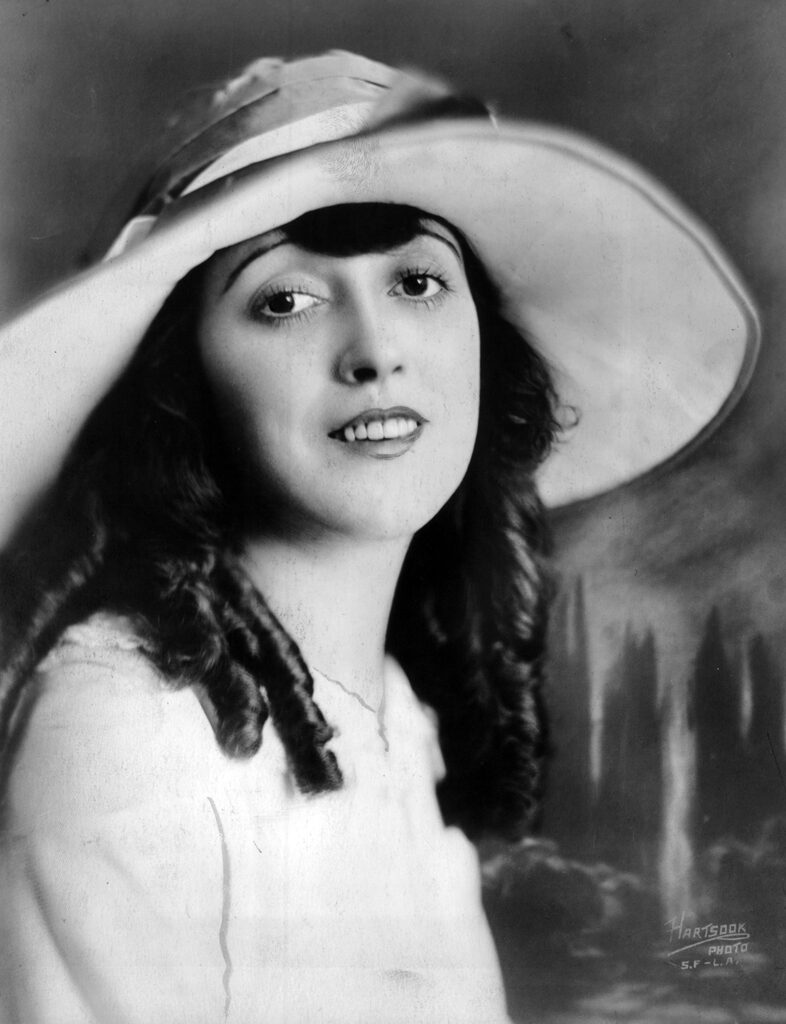
1924 started cold and violent. The mercury dipped below zero at 3am on the first of the year and continued to drop steadily, approaching a new record. Several Chicagoans froze to death, including John J. Quirk, whose body was recovered close to the lake, at the 79th Street beach.
As reported in the Chicago Tribune, almost a million Chicagoans stayed up late on December 31, 1923 to welcome in this new year. Hotels like the Congress and Drake drew thousands to their festivities, while many other Chicagoans celebrated quietly at home. Champagne appeared to be in short supply, with national prohibition now entering its fourth year, but revelers had access to “synthetic gin,” bourbon from pharmacies, and bootlegged Canadian whisky.
In the comic strip The Gumps, poor Andy Gump got so drunk on “sympathetic gin” early in the evening that he passes out during the party at the Chez Paree, much to the consternation of his long-suffering wife. He wakes calling out her name in the early morning hours in an empty ballroom.
The police reported arresting six drunks in the Loop. Four Chicagoans suffered gunshot wounds sustained accidentally when neighbors fired off random shots of joy. One of the victims, a woman, was peeling potatoes in her kitchen at the time.
As the temperature dipped, Chicagoans could get the blood pumping by reading about conflict and mayhem around the world and at home. In Washington, a rift had emerged in the governing Republican Party between the conservative President Calvin Coolidge (who had assumed office in August after the death of Warren G. Harding) and the progressive Senator Hiram Johnson of California, that threatened to disrupt the national convention later that year, while a House Committee quietly approved sending to the floor a new immigration bill that would radically impact the demographics of the country.
Abroad, the Mexican government attempted to quell another revolution, war seemed imminent in the Balkans, and the Tories and Liberals plotted a coup to keep the Labour Party, suspected of “Bolshevikism,” out of power in England. All these stories, with a few exceptions, appeared below the fold or within the interior of the Tribune that first week. The above the fold story concerned a scandal in Hollywood.
In that first week of 1924, for three straight days the Tribune reported on the tribulations of actress Mabel Normand, frequent costar of Roscoe “Fatty” Arbuckle and Charlie Chaplin, who had been in the wrong place at the wrong time on the first of the year. She had been driven to the rented apartment of a transplant from Denver, Courtland Dines, who’d made his money in oil and become involved with a friend of Normand’s, fellow actress Edna Purviance. All the official reports agree that a lot of drinking ensued, as Normand and Purviance were still intoxicated when taken to be questioned by the police later that evening.
At some point, when Normand was in a back bedroom powdering her nose alongside Purviance—or was she on the sofa in the front room talking to Dines, who stood behind the bar or was she, as her chauffeur maintained, attempting to leave but Dines wouldn’t let her and became violent—at some point, this is known: Normand’s chauffeur shot Dines and then calmly called the police to report what he had done, claiming it was to protect a woman’s honor.
Dines would be found in the back bedroom, groaning and clutching his gut, and be taken to Good Samaritan hospital where, within a day, Normand joined him, to receive an emergency appendectomy. As a result of the scandal, the second shooting in as many years involving Normand, picture houses across the nation announced they were pulling her films. In Chicago, during that first week of 1924, her film The Extra Girl screened at the Orpheum, at State and Monroe.
The country’s second largest city had several scandals of its own unfolding over the week. The Tribune intended to create one by listing each day a steadily growing number of automobile-related fatalities; one of the first issues of the new year included a supplement that was little more than a roll call of the over 700 Chicagoans who had died by car in 1923.
Albert Klein, a teacher at the Parental School, a reform school for boys, turned to the courts for protection when he was terminated, he claimed, for having testified about abuses there at an earlier trial, setting up a conflict between the city’s school board and the judge who’d pledged to shield him from retaliation.
The most sensational case at the start of the year mirrored the Dines shooting—like that Hollywood scandal, it involved booze, changing testimony, and perhaps romantic jealousy. On the first of the year police officer John Mulcahy shot and killed Jenny Plarr, 22, an employee at Al Tearney’s cafe and the Cocoanut Grove cabaret, while the two of them were drinking with police officer J.L. Kelly in the back room of Thomas Gilligan’s cigar shop in Woodlawn.
Mulcahy claimed it was an accident but not before switching revolvers with Kelly, evidence in the eyes of Police Chief Morgan Collins of a “coverup.” Both men were drunk at the time of the shooting, and the cigar store was known to be a front for illegal drinking. Mulcahy had married a month prior and met Plarr for the first time that evening as she left the Cocoanut Grove, offering to walk her home before persuading her to slip into the cigar store and join him for a drink. Wounds on Plarr’s hands suggested to the deputy coroner that perhaps the shooting was a result of Mulcahy playing with the gun before it accidentally went off.
The deputy coroner went to great lengths at the inquest to convince the jury that the shooting was an accident, going so far as to interrupt their closed door deliberations so that he could impugn, without evidence, Plarr’s character. It worked, and the jury “absolved” Mulcahy of any “criminal responsibility” in the death. An infuriated Chief Collins vowed there would be consequences for the two officers regardless of the verdict.
“What is behind all this unseemly rush to exonerate a drunken, killing policeman?” Collins fumed. “Is human life so cheap in Chicago as all that?”
Week Two: January 6-January 12, 1924
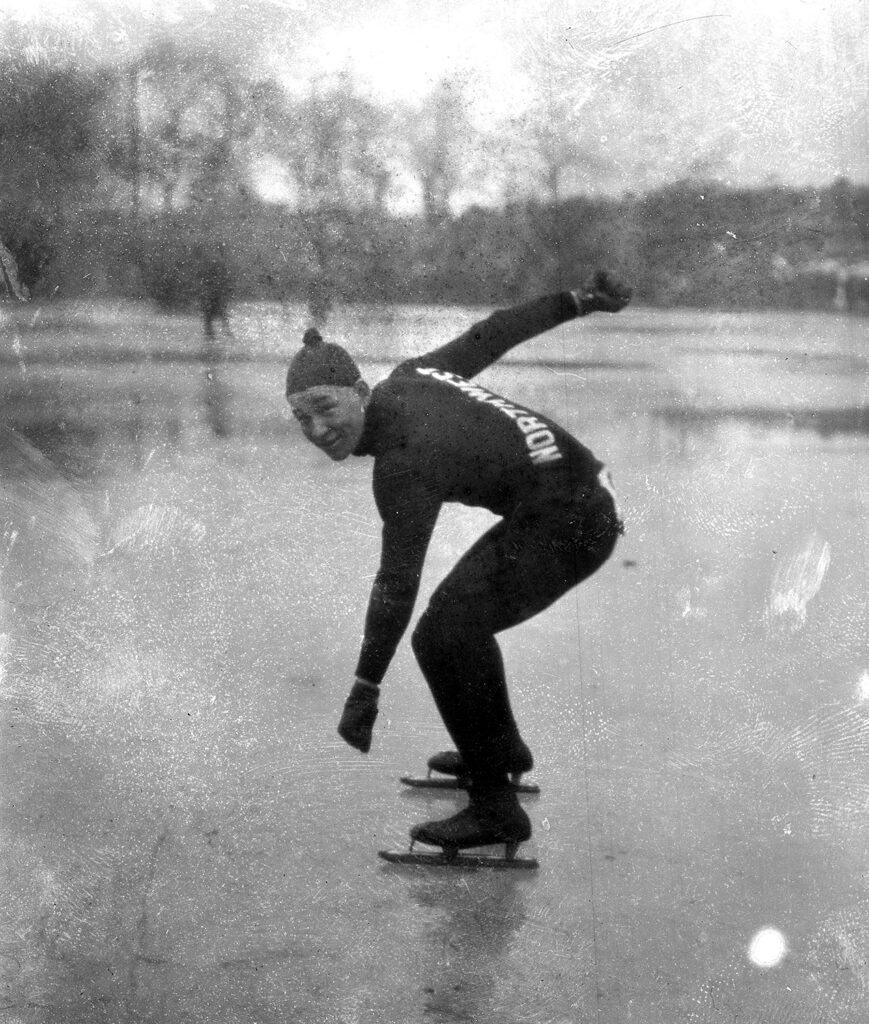
Ice skating season started in the lagoons of Humboldt Park in the second week of 1924. The city’s best skaters had already departed for the winter Olympics in Chamonix, but scores of others turned up on the ice to welcome back one of the pleasures of the season. This followed after forty-eight hours of intense cold, resulting in the death of seventeen Chicagoans from exposure.
A 4-11 fire broke out in a Loop warehouse late in the week, with the smoke clearing the theaters along Randolph Street, while the curious paid transit fare simply so they could view the conflagration from the safety of nearby L stations.
Heat of a metaphorical kind filled the pages of the Tribune that week, with Sun Yat-Sen’s government in Canton calling for “world revolution” against Western powers and Japan, while stateside the popular twice-married short story writer Nina Putnam faced public accusations of adultery from the wife of her housepainter.
Out in Hollywood, the chauffeur of actress Mabel Normand pleaded self defense in the shooting of Courtland Dines on New Year’s Eve, as prohibition agents looked into the drinking that preceded the incident and the states of Massachusetts, Ohio, and Michigan banned screenings of her films. Asked by the Tribune’s Inquiring Reporter about these bans, Chicagoans seemed more sympathetic to the actress, unless found culpable through a court other than the one of public opinion.
At the Hamilton Club of Chicago, the solicitor general of the United States, James M. Beck proclaimed that the “greatest curse of our nation today is our moving picture mind,” where “we cannot hold any lasting impressions,” and, therefore, are incapable of making informed decisions, whether in regard to politics or ethics. In addition to moving pictures, Beck blamed newspapers and the radio for the nation having lost its “sense of values.”
This loss of values had been on display the previous week when a grand jury had cleared Officer John Mulcahy of any wrongdoing in the shooting death of cabaret employee Jenny Plarr with surprising rapidity. Encouraged by Police Chief Morgan Collins, Coroner Oscar Wolff empaneled a new jury who determined that Mulcahy had committed involuntary manslaughter.
A different police officer was cleared in the fatal shooting of Lane Tech high school honor student Waldemar Linne Lindgren that week, having claimed to have mistaken the boy for a burglar skulking outside the former’s front window. “I told him I was an officer and told him to hold up his hands,” explained Officer Walter Ficther, “He ran. I fired once into the air, then three shots at him.” No evidence found on Lindgren’s body suggested he was attempting a burglary, while his father maintained, “He was a model boy. He wouldn’t do no wrong.”
A day after Officer Ficther was cleared, Betty Michaelson, 19, began a thirty-day sentence in the county jail for having shot and wounded her husband. As she scrubbed the floors of the various cells, the Tribune reporter noted that it was mud tracked by Michaelson’s husband across the clean floors of her kitchen that had led to his shooting.
As part of a series of articles focused on the rising level of gun violence, journalist Arthur Evans noted that Chicago had strict laws in place, but “Evanston, Harvey, Gary, a long string of other suburban towns, are delivery points of easy access.” Gang members engaged in the illicit booze trade knew all the loopholes and used them to their advantage. Only “action on a nation-wide scale” could lessen gun violence. The next in the series promised to consider the “pistol vs. shotgun as a home defender, with some observations on the ‘right to bear arms’ provision in the federal constitution.”
Week Three: January 13-January 19, 1924
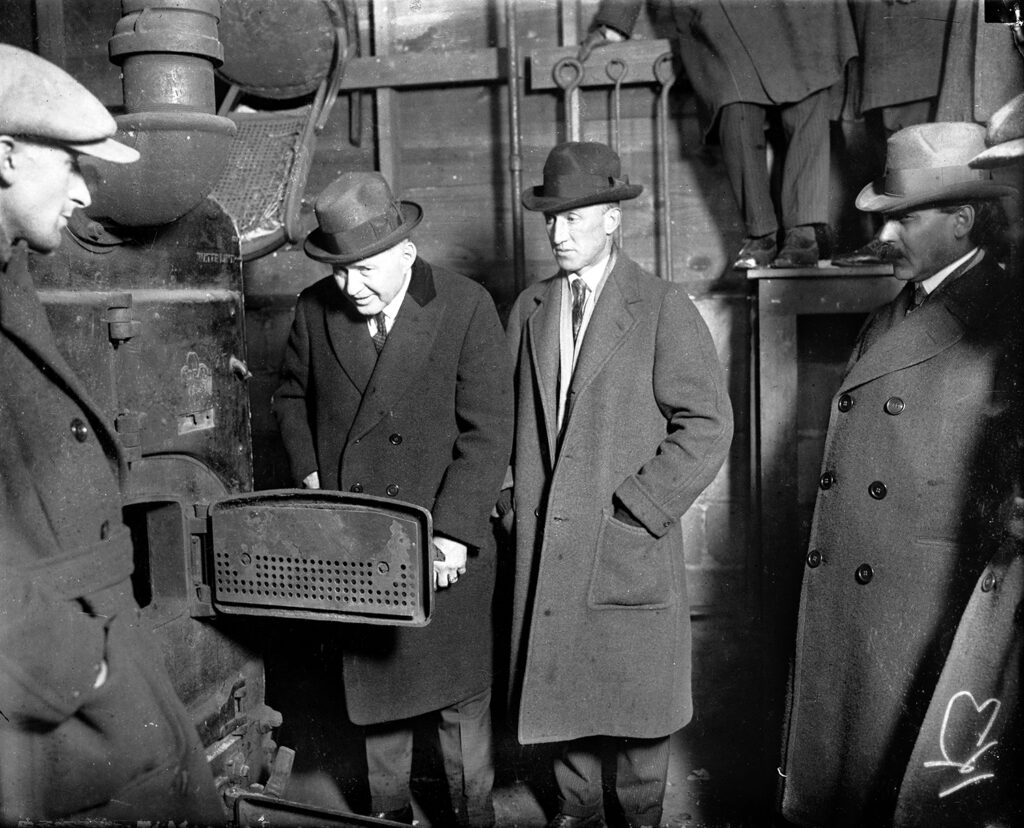
Headlines in the Tribune in the third week of 1924 grabbed readers with scandals old and new. The strange story of Warren J. Lincoln, a lawyer and floriculturist from Aurora, resumed when the man—who had months earlier disappeared, having been presumed murdered by his wife and brother-in-law, only to turn up alive and vanish again—reappeared. This time authorities arrested him on suspicion of having slain those accused of killing him.
In Oak Park, a married Baptist minister faced charges that he’d seduced one of his married congregants, now embroiled in a very public divorce. Adding to the shame were accusations that church deacons had tried to bribe the woman to remain silent about the affair.
The one national headline to break through involved questionable leases to the Navy’s oil reserves to private interests, granted by the late President Warren G. Harding’s Secretary of the Interior, in an area of Wyoming called Teapot Dome.
The nation marked the fourth anniversary of national prohibition on January 17. The Chicago Crime Commission received a report from its director that proclaimed Chicago one of the safest cities in the country. The Inquiring Reporter asked four Chicagoans encountered at 11 South Dearborn if prohibition had been a success; the responses from a bond salesman, two homemakers, and another salesman were divided, with a fireman saying it was too early to say one way or the other.
Police officer John Mulcahy, found culpable for the boozed-fueled New Year’s Day fatal shooting of cabaret employee Jenny Plarr, had the verdict of a second grand jury inquest voided by a judge who’d deemed the proceeding illegal.
An association of Chicago women’s clubs debated whether or not to recommend that the films of Mabel Normand, embroiled in her own boozy scandal in Hollywood, be banned, but decided to invite the actress to speak before them and defend herself; Normand agreed to visit Chicago as soon as she was able.
A photograph of Kate L. Butler, from Dorchester, MA, appeared in the newspaper with a caption calling her “Edison” for having won, with one other entrant, a contest to coin a new word to describe Prohibition violators like Mulcahy and Normand: scofflaw.
Had he been alive, Benjamin Franklin would have turned 218 this week. In an attic in New Jersey, his printshop “work book” or ledger from the last decades of the eighteenth century, believed lost to history, was discovered. In Chicago ten men with the first name “Benjamin” and middle name “Franklin” held a luncheon at the Union League Club, followed by a laying of a wreath at the base of the diplomat and inventor’s statue in Lincoln Park.
It was a week of innovation to make Franklin proud. In France, a flying machine, the helicopter, stayed airborne at 15 feet for over eight minutes. In the United States, Radio Corporation of America’s David Sarnoff sent a message asking about the weather 14,000 miles by radio from San Francisco to a station in Tomioka, Japan in 105 seconds. It was the first time a radio signal had traveled such a distance successfully. Sarnoff predicted a future of global connection through “radio television” where “Americans sitting in their homes not only will hear concerts, plays, and operas being broadcast in the great cities of this country but that the farmer may some day hear and see, by radio, on the farm, what is going on in Paris, London, or some other foreign city.”
Closer to home, the South Park Commissioners had met and agreed to accept a gift of $250,000 for the erection of a fountain, “equipped with colored electric lights,” the following summer in Grant Park. The gift of the fountain was made in the memory of her late brother Clarence by Kate Buckingham.
Week Four: January 20-January 26, 1924
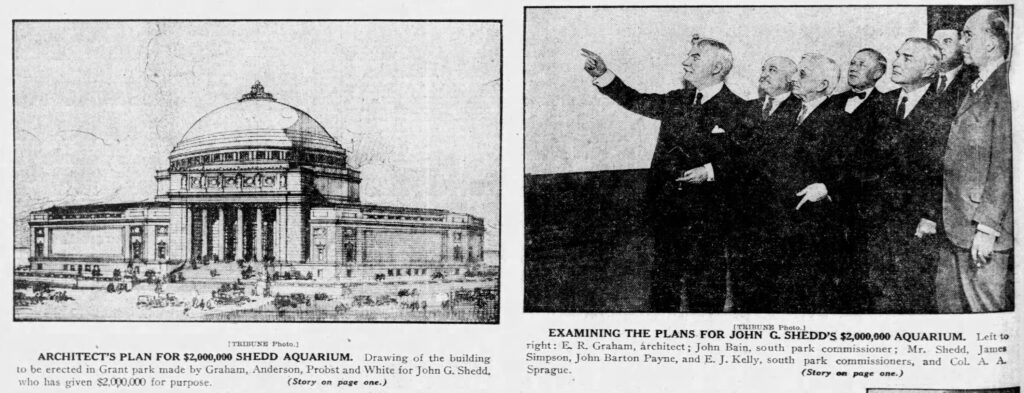
In the fourth week of 1924 during a dinner at the offices of the architectural firm Graham, Anderson, Probst, & White, the chairman of the board of directors of Marshall Field & Co., John G. Shedd, announced a $2 million gift to the South Park Board of Commissioners to support the building of an aquarium adjacent to the Field Museum of Natural History. The aquarium, to be designed by the firm hosting the dinner, would be “two and one-half times as large as New York’s” and be the “equal of the best in Europe, which is said to be that at Naples.”
An aquatic accomplishment of a different kind had occurred earlier in the week in Fort Wayne, Indiana, when Illinois Athletic Club swimmers Sybil Bauer and Johnny Weissmuller set new world records in the 100-yard backstroke and 400-yard freestyle respectively. Back in Chicago, amid brutally cold conditions, 15,000 turned out to watch 600 skaters participate in the Chicago Tribune’s Silver Skates Derby held on the lagoon in Garfield Park.
Over in Chamonix, France, at the base of Mont Blanc, what became regarded as the first Winter Olympic Games opened with 16 nations participating. The American team sang “I’ve Been Working on the Railroad” at the opening ceremonies, and American speed skater Charles Jewtraw won the first gold medal.
The most gripping athletic contest of the week, for locals at least, unfolded over three days in Orchestra Hall, when Willie Hoppe of New York faced Jake Schaeffer of San Francisco to determine who would be the international 18.2 balkline billiard champion. A clearly exhausted Hoppe prevailed on day three, retaining his title.
Rivalries of a more serious nature unfolded across the world in the fourth week of 1924. In Moscow, thousands waited in the cold for a chance to view the body of V.I. Lenin, who had died on the 21st, while Tribune foreign correspondent John Clayton reported on speculation as to who would assume control of the Russian state, Leon Trotsky or Joseph Stalin.
In Georgia, old divisions appeared etched in stone when artist Gutzon Borglum unveiled his head of Confederate General Robert E. Lee, part of an immense sculptural relief on Stone Mountain. At the unveiling, timed to coincide with Lee’s birthday, Emory University’s Plato Durham delivered an address in which he proclaimed that the “man who calls Lee a traitor is doubly damned.”
The never-ending conflict between capital and labor took an unexpected turn when Meyer Perlstein of the International Garment Worker’s union admitted challenges organizing women workers in non-union shops; the manufacturers, he claimed, had taken to hiring “Sheiks”—that is, handsome cads—to take the women to dances on the nights of organizing meetings and, between acts of romance, spread anti-union propaganda.
Two “sharps” were shot when stepping out of the lobby of the La Salle Theater after catching a first night show at the popular venue in the Loop with their wives. Moments after the four shots rang out, chaos erupted among the estimated crowd of 1,000 leaving the theater, making it difficult for police to determine who had downed brothers Davy and Max Miller, West Side gamblers and grifters. Within days, however, they had apprehended the most likely suspects, a north side florist and former singing waiter named Dean O’Banion and his associate, the notorious “perfume burglar,” Earl Weiss.
Week Five: January 27-February 2, 1924
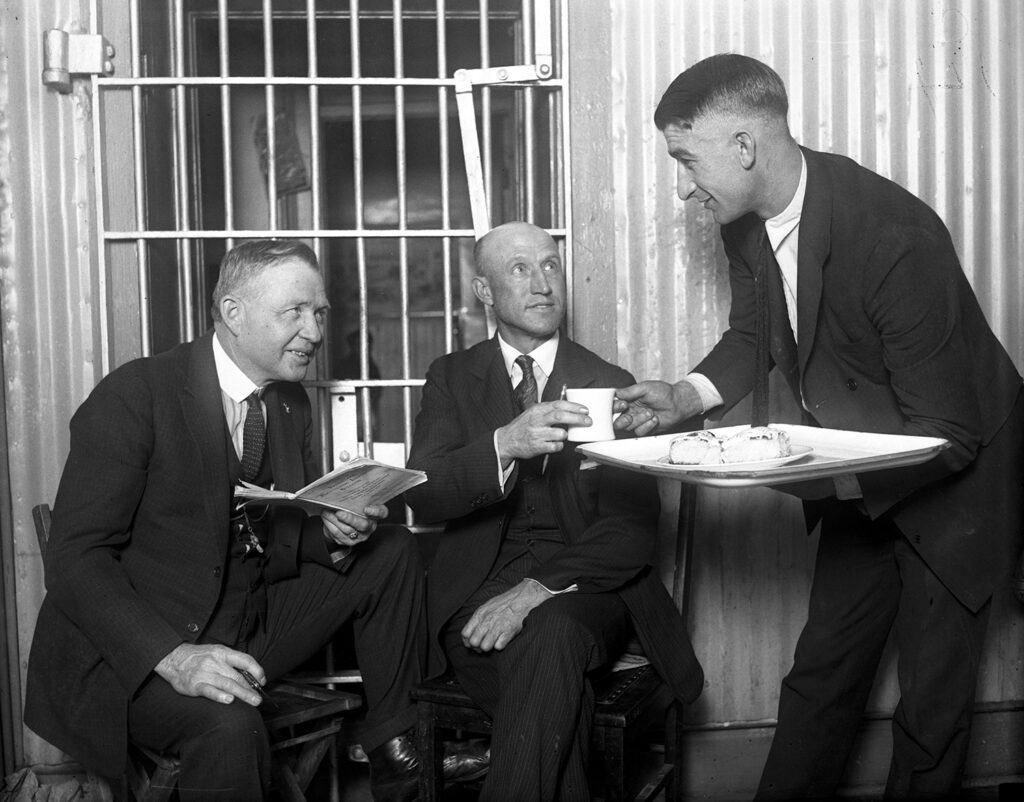
A thick fog covered the city near the end of the fifth week of 1924, leading to calamity. There were numerous automobile accidents. Illinois Central and L trains collided. The worst occurred on the Ravenswood elevated line where one train struck the rear of another, leaving 40 passengers with injuries, although most were superficial.
Earlier that week, a metaphorical fog lifted in the strange case of Warren J. Lincoln, lawyer and floriculturist from Aurora, a man believed to have been killed by his wife and brother-in-law, who turned up alive, only to disappear again, and, finally, was apprehended when attempting to pick up funds mailed to his missing, presumably murderous, wife. Interrogated by his longtime friend, Aurora’s chief of police, Lincoln changed his story yet again, finally admitting he had murdered his wife and brother-in-law. He led investigators to a city dump along the Fox River, not far from his home and greenhouse, and there, wrapped in burlap and encased in a 18”x 36” block of cement, were the severed heads of his wife and brother-in-law. Lincoln said he’d come upon them having sex and in a fit of rage shot both fatally, but the chief of police believed that the brother-in-law’s money served as the true motive. The remainder of the two bodies, Lincoln confessed, he burned in the greenhouse furnace.
The same day the Tribune reported Lincoln’s confession, it announced the opening of the twenty-fourth annual National Auto Show, which would run from Monday through Saturday of the week, from 10am to 10:39pm daily. A record number of attendees turned out to see 500 new automobiles, many featuring such innovations as four-wheel brakes and balloon tires, with the show spread across the Drake Hotel, the 131st Infantry Armory, and the Coliseum, the latter full of decorative art “reminiscent of the Louis XIII and Louis XIV periods,” emphasizing the automobile’s place as a true status symbol.
Outside Chicago and around the world, Prince Hirohito of Japan wed Nagano Kuni, while the musical comedy star De Wolfe Hopper, after being caught in the company of a chorus girl, was divorced by his fifth wife, Elda, known on the stage as Hedda Hopper. In Italy, Benito Mussolini purchased for the state the tomb of Virgil, which had been on privately owned land, and kicked off the general election by urging a crowd of thousands to turn out at the polls to oust an oppositional parliament, “For our Fatherland, for Fascism.” He declared himself and fellow Black Shirts “ready to kill or die” to secure electoral victory.
The presidential aspirations of Democrat William McAdoo, former Secretary of the Treasury and son-in-law of Woodrow Wilson, were challenged when his name was linked to the expanding Teapot Dome scandal; however, McAdoo, an attorney, in a forceful response to Congressional investigators delivered from his law office in Los Angeles, stated he had represented oil interests only in Mexico and never had anything to do with leases on federal land in Wyoming.
Princeton University, where Wilson had served as president, turned up in the news, when five of its faculty were asked to name the six most significant words in the English language. Four of the five gave a response similar to J.D. Spaeth from the English Department—”Liberty, loyalty, sympathy, justice, intelligence, character”—but Henry Van Dyke recognized utility with his list of “a, the, is, no, yes, do.”
In Washington, Wilson wasn’t doing that well, but his attending physician assured the public that he “did not consider the former President’s illness serious.”
Week Six: February 3-February 9, 1924
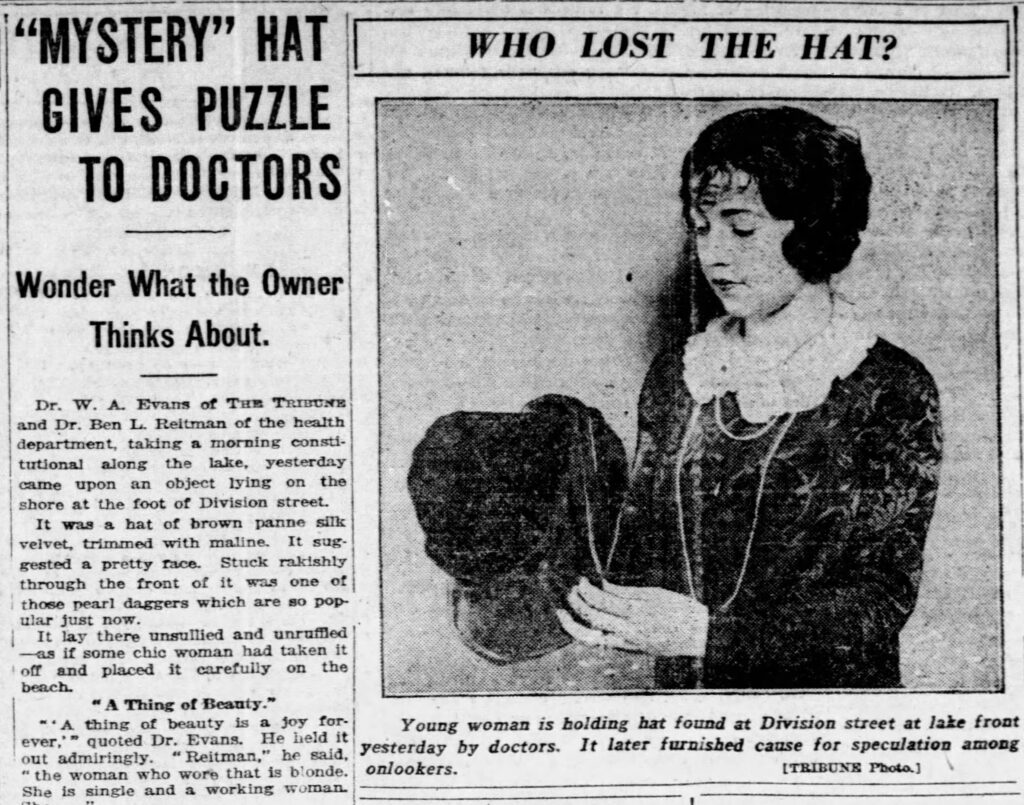
Deaths of note bookended the sixth week of 1924. The passing on February 3 of Woodrow Wilson, the former President of the United States, filled the front page of the Sunday edition of the Tribune. In his home in Washington D.C., with his wife and eldest daughter at his side, lying in a replica of the bed Lincoln had used in the White House, Wilson slipped into a coma and died quietly, his dream of the United States joining the League of Nations unrealized.
On Friday of that week, halfway across the country, in Carson City, the state of Nevada executed a human being by exposure to lethal gas—the first use of this method in the United States. The cyanide had to be brought over from California, where it was used to fumigate crops, and was tested on a cat in a chamber in the prison’s butcher shop that could be sealed safely. Satisfied with the test, prison and medical officials moved on to executing Gee Jon. In 1921 he had traveled from San Francisco to a small town in Nevada to murder an elderly member of a rival gang. A terrified Gee was strapped to a chair in the chamber; within moments of being exposed to the gas, his head slumped forward, bobbing up and down for several minutes before going still. Witnesses had to be evacuated out of fear that the gas was leaking from the chamber. Despite the speed and apparent humaneness of lethal gas, the prison’s warden stated that he still preferred the use of a firing squad in executions.
Between these moments of quiet passing, the city of Chicago continued on with the conflict and calamity that had defined so much of the beginning of the year. The newspaper reported on a dance thrown by the Teamsters union at Carmen’s Hall, near Van Buren and Ashland, which had devolved into a riot in the early hours of Sunday, leaving one dead and twelve recovering from gunshot wounds. Winter reasserted itself with a storm of snow, rain, and sleet that led to one streetcar derailing and two others colliding while numerous trains stalled on the tracks outside the city. All were aided not by telegraph wires, downed by fierce winds, but by the radio, which effortlessly transmitted information about the trapped train passengers to rescuers and stories about the storm to newspapers across the country. Not wanting to miss reporting a moment, the Tribune turned to WJAZ, a station owned by Zenith and broadcasting out of the Edgewater Beach Hotel, to alert cities to the west of what was happening in Chicago.
The storm did not deter attendance at a revival of a motion picture beloved by the late Woodrow Wilson, The Birth of the Nation. What did disrupt the screening at the Auditorium was a judge, intentionally seated in the audience, who determined that the film violated a state statute, passed in 1917, that barred the “showing of pictures which tend to engender race or class hatred.” Police shut down the showing of the film, repeated the effort on the following evening, and then stood aside and let the film play while an injunction worked its way through the courts.
Amid all this, readers of the Tribune became privy to a minor mystery when it was reported that the paper’s health columnist, Dr. W.A. Evans, while walking along the lakeshore at Division Street with Dr. Ben Reitman, physician to the hobos and denizen of the Dil Pickle Club, came across a woman’s brown velvet hat laying “unsullied and unruffled” on the sand. This discovery prompted the men to turn detective and use the qualities of the hat to determine the character of its owner.
Noting the pearl dagger pendant “rakishly” pinned to the front, Evans concluded she was a young, blonde, single, working woman. Perhaps not single but married, Reitman suggested, although he gave no reason for this conclusion. Had this woman walked into the lake and ended her life, as Evans deduced, or had the hat blown off her head while she rode on the top level of an open air motorbus, as Reitman maintained?
They brought the hat to the Tribune’s office where more speculations were made by journalists. A label on the lining led them all to the hat’s maker who in a phone call remembered the owner as being a rather nondescript woman.
Within a day, the mystery resolved itself when the owner, Mary Edna Cook, came forward, saying Reitman was correct, she had been on a bus, near the lake, when the hat blew off her head. She thought it lost forever. Cook worked as a secretary for the Sinclair Oil Company, in the news that week for its connection to the Teapot Dome scandal.
Week Seven: February 10-February 16, 1924
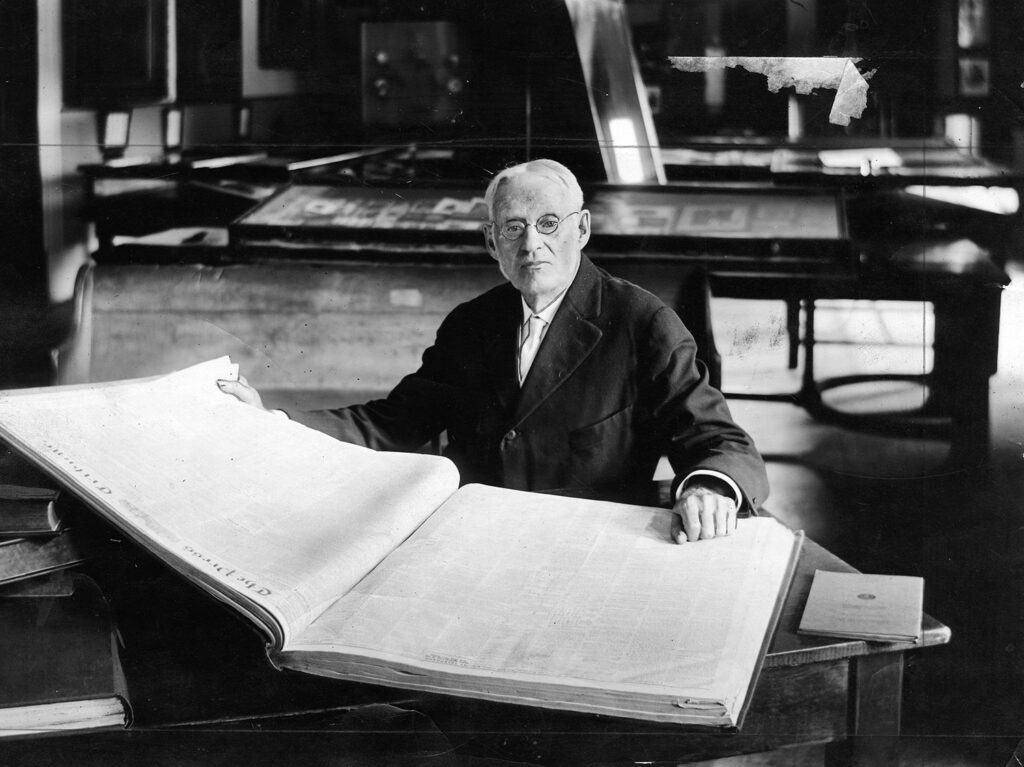
A baby fell into the snow and a child slipped under the ice in the seventh week of 1924.
Two-year-old James Novello tumbled off the upper porch of his family’s home but landed headfirst into a pile of snow. When his mother found him, he was kicking his feet in the air.
Marie Schram had a more harrowing experience when the twelve-year-old, out on the ice covering a drainage canal in Evanston, fell through. The screams of her schoolmates who’d dared her to go there attracted the attention of a passing delivery truck driver for Marshall Field, Robert Phil. He leapt from his vehicle with a length of rope in hand. Fastening the rope around an object found on the shore, Phil, an experienced swimmer, edged out onto the ice. The rope wasn’t long enough to reach the open water, so he slipped free of it and dove in to retrieve the struggling Marie.
Several times she went down, and Phil followed, before finally gaining a good grip on her and treading back to the edge of the ice and the end of the rope. By this time, others had gathered who helped pull the two up and out of the canal. Marie was wrapped in blankets and placed in the back of a limousine, which sped off toward her home. A cold and tired Phil remained alone at the site until a passing motorist picked him up. The Tribune, learning of the incident, recommended Phil for a Carnegie Medal for heroism.
The long certainty of the past offset the precariousness of the present in the seventh week of 1924. Chicago and the nation observed the 115th anniversary of the birth of Abraham Lincoln. At the city’s historical society, Addison Proctor, 86, the sole surviving delegate to the 1860 Republican convention, told the “true story of Lincoln’s nomination for the presidency.”
Proctor had come to the convention in Chicago from Kansas intending to support New York’s William Seward. Party leaders, however, come to believe that the “border states—between the north and the south—held the balance of power. They kept telling everyone they wanted a nominee born among them—one who understood them.” That led to the nomination of the Kentucky-born Lincoln. After the talk, visitors to the historical society had the opportunity to view the gray shawl Lincoln wore in New York when he made his famous Cooper Union speech, a whittling knife, a lock of hair, and other artifacts.
In Egypt the University of Chicago’s James H. Breasted was among those who witnessed the truth of a much deeper past revealed. Outside Luxor, in the Valley of the Kings, within pharaoh Tutankhamun’s tomb, a story millennia in the the making neared its end when a system of pulleys lifted up the heavy pink sandstone lid of the inner sarcophagus holding the mummy case containing the ancient ruler’s body. The first to look inside was archaeologist Howard Carter, who had rediscovered the tomb in 1922. At first, he saw only shrouds of darkened linen, which he and a colleague began to slowly roll from the foot upward until they exposed a “gleaming, golden man.” Set within an exquisite mask that captured the “wistful, beautiful, boyish face” of Tutankhamun,”gleaming eyes of aragonite, strangely and eerily lifelike” gazed up at Carter and the others assembled there.
A relic of a different sort, capitalist inventor Thomas Edison, turned 77 in the seventh week of 1924. Interviewed in West Orange, New Jersey, where he lived and worked, Edison said he was “good for, say, ten years yet,” thought Calvin Coolidge would win the fall presidential election, considered radio the most important technological innovation of the year, and proclaimed that when oil and coal were exhausted as sources of energy, they’d be replaced by “(s)un, wind, tides, and vegetable growth.”
A part of the past many Chicagoan preferred to forget resurfaced when a jury awarded Joseph Jefferson “Shoeless Joe” Jackson—former White Sox baseball player disgraced by his believed involvement in the crooked 1919 World Series and banned from the sport for life—the pay that was owed to him for the 1920 season. Outraged by the verdict and citing perceived perjury in some of the testimony, the trial judge set it aside and dismissed the case. Jackson’s attorney planned to appeal, citing the verdict as the first step in the player’s “ultimate return to organized baseball.”
For those still involved in the sport, its seasonal return was fast approaching. On Saturday, thirteen pitchers, three catchers, and four infielders from the Chicago Cubs boarded a train bound for Los Angeles. From there, they’d get on a boat to Catalina Island, owned by chewing gum maker and the club’s owner William Wrigley Jr., for the start of spring training.
Week Eight: February 17-February 23, 1924
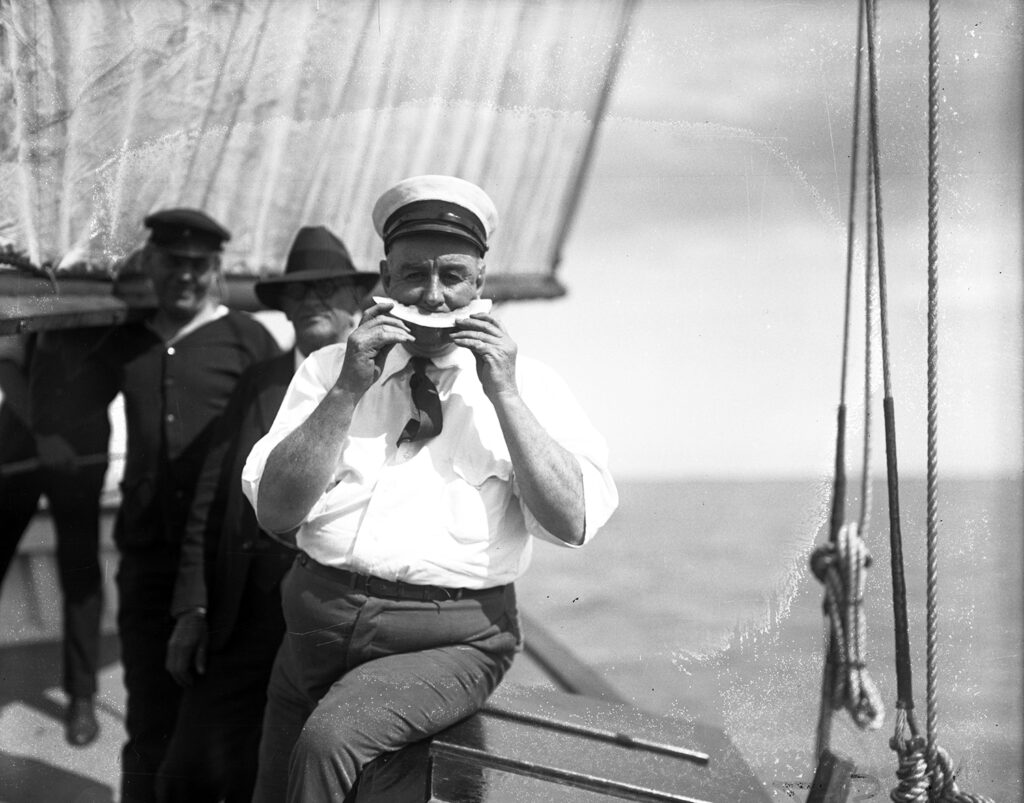
The Year of the Rat started with a bang in the eighth week of 1924. In “old Chinatown in Clark Street and the new one in 22nd street,” strings of firecrackers suspended from second- and third-story windows erupted in streets “ablaze with lights”as the community welcomed the New Year. All debts must be paid, according to resident Frank Moy, so that one starts the New Year with a clean slate.
In Chinese mythology, the rat is considered a clever creature, and Chicago’s criminal underclass demonstrated this quality during the course of the week. On the eve of Chinese New Year, the police raided the headquarters of an underground lottery game in the Loop. Frank Averitt, the organizer of the operation, had a unique source for his winning numbers, the US Weather Bureau. “The temperature report at certain specified hours of the day is said to have provided the digits for the lottery figures,” the Tribune reported.
A few days later a cashier at the People’s Trust and Savings Bank on north Michigan Avenue returned to his cage mere minutes after leaving it only to discover several notes and certificates scattered around a drawer he’d left open. Some of the notes were covered in a sticky substance and gave off a hint of spearmint, leading investigators to conclude that some thieves had used a penny pack of gum, attached to the end of a stick, to reach through the bars of the cage and lift up and out what was determined to be $50,000 worth of certificates. A similar crime had occurred a month prior at a bank in Indianapolis, suggesting the start of a spree. Unfortunately for the gum bandits what they plucked, while valuable, was difficult to redeem, as they were all “United States certificates of indebtedness.”
The value of a historical artifact came under debate at an auction in Philadelphia. Did the “Mr. Douglas,” who successfully bid on the coat worn by Abraham Lincoln at Ford’s Theater on the night the president was assassinated by John Wilkes Booth, receive the genuine article? Not so according to the the Chicago Historical Society who claimed to have the coat as part of its collection. Frank G. Logan, who gifted the coat to the Society, said he had the documents to prove its authenticity, while the auctioneers in Philadelphia said they had their own sources of their coat’s provenance.
Logan contributed a significant sum to keeping another object of historical importance in Chicago this week. A portrait of George Washington by Gilbert Stuart, on loan and on display at the Art Institute of Chicago, was available for purchase if sufficient funds could be raised. The Chicago Herald-Examiner launched a campaign to keep it in Chicago, which was soon joined by the city’s other morning newspaper, the Tribune.
Someone who was not first in the hearts of his countrymen—and who, not surprisingly, turned up at the beginning of the Year of the Rat—was the former Mayor of Chicago, William Hale “Big Bill” Thompson. His Honor, along with the former city comptroller and the head of the Lincoln Park Commission, put forward the funds to incorporate the South Sea Research Company, which planned to dispatch on July 4 an expedition to discover and document “acrobatic fish,” the kind that can “climb trees, live on land, and jump three feet to catch a grasshopper.”
A bit of the wild came closer to home when three young lions broke free of their cage on a baggage car headed from Minnehaha, Minnesota to Sellers, Maryland, where the animals’ owner, a circus, wintered. By the time the train reached Chicago, the lions had taken full possession of the baggage car, but a “Lincoln Park trainer” succeeded in coaxing them back behind the bars.
Week Nine: February 24-March 1, 1924
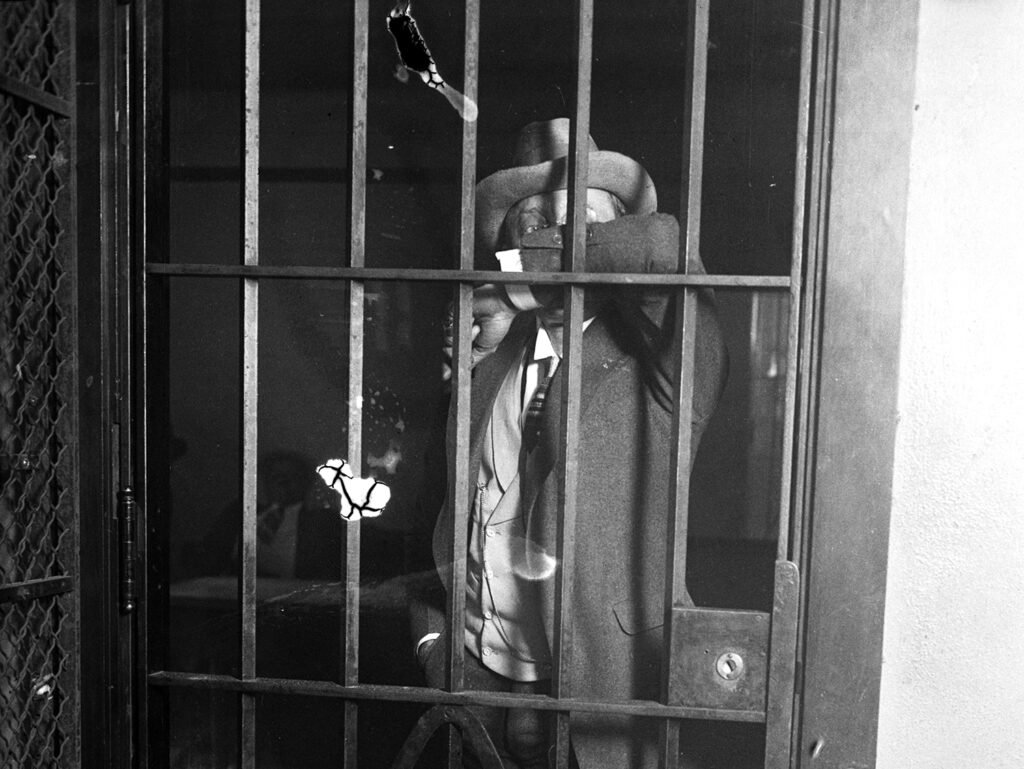
(Chicago Tribune historical photo)
In the ninth week of 1924, predators of all sizes stalked Chicago and the world. Driving back to the city from Tomahawk, Wisconsin, Thomas Smith claimed to have been pursued by five large gray wolves near Milwaukee and Devon avenues, making him the “latest victim of the great wolf scare in Cook county.” Earlier in the year, a pack of twenty-four wolves sighted along the Elgin road were determined to be friendly “German police dogs,” belonging to an attorney who lived nearby. Said Smith of his encounter, “I have been in wolf country for a week and never saw a wolf.”
Women were on the prowl across the city on February 29 if a Tribune article with the title “Watch Your Step, Men; They’re After You Today” is to be believed. The article referenced an old tradition allowing women to propose to “unattached men” on Leap Day. Men, as usual, seemed to be the ones doing the most pursuing. Joseph “Yellow Kid” Weil, known as being “without peer as a con man,” found himself accused in a divorce suit of having stolen the heart of Helen Carrozzo, the wife of a former Street Sweepers Union president and known gangland associate. Weil admitted knowing of the man but said, “I’ve never seen nor met his wife. It’s the bunk.”
At a Polish dance hall in South Lawndale, a dispute between lovers didn’t look likely to reach the courts. Refused a dance from former fiancee Mary Mitas, Edward Kociza pulled out a revolver and shot her in the face before turning the gun on himself to the horror of the couples dancing around them. Both survived the shooting, although they were expected to die from their wounds. Kociza retained consciousness throughout the trip to the Bridewell infirmary where surgeons, having discovered the “bullet lodged at the base of his brain, marveled that death had not been instantaneous.”
The Vatican publication Osservatoro Romano would have placed the blame for this shooting and all “recent flagrant immorality” squarely upon popular dances such as the “shimmy” and “camel’s step.” In an article published that week, it warned of the dangers posed by these dances with their “imitation of animal movements.”
The Church itself came under attack at a trial for high treason that began in Munich in connection with the previous November’s failed insurrection there, the infamous “beer hall riot.” On trial were former Field Marshall Erich Ludendorff and the “leader of the Bavarian fascisti,” Adolph Hitler. The two veterans of the Great War contrasted in appearance and style, with Ludendorff composed and clad in a pressed blue suit and Hitler animated and wearing an old “black coat showing tinges of green and shiny areas on the back and sleeves.” Ludendorff spoke for both when he proclaimed, “We want a Germany free of Marxism, semitism, and papal influences.”
Similar sentiments found expression back in the United States but also ran into opposition. The Ku Klux Klan found its meeting at the Commercial Hotel in Waukesha, Wisconsin disrupted by “2,000 citizens” who objected to the group meeting there. The police and members of the American Legion had to hold back the protestors so that Klan members and their sympathizers could safely flee.
Back in Chicago, during a talk at the University Club, Dr. William Paxton Burris, “dean of the college of teachers of the University of Cincinnati,” called upon the National Education Association to proclaim the Klan “100 per cent American” in exchange for the “invisible empire” supporting a congressional bill that called for establishing a cabinet-level department of education.
Another bill slowly moving through Congress would significantly alter the nation’s immigration laws. The Tribune warned, however, that the bill had one glaring omission: it did not take into account illegal immigration across the Canadian and Mexican borders of the United States. In two editorials over successive days, the newspaper drew attention to the number of Mexican immigrants who were coming to work and live in Chicago, having established their own neighborhoods near the new Chinatown, along 23rd and 24th Streets, and between Peoria and Newberry Avenues. While acknowledging the critical contributions made by this community to the city’s economy, the paper nonetheless fretted about unchecked immigration and the inability of legislation to address it: “The Mexican border is long enough and wild enough and there are enough ports of entry, into Mexico, to nullify any restrictive system in time, unless it is corked up.”
Week Ten: March 2-March 8, 1924
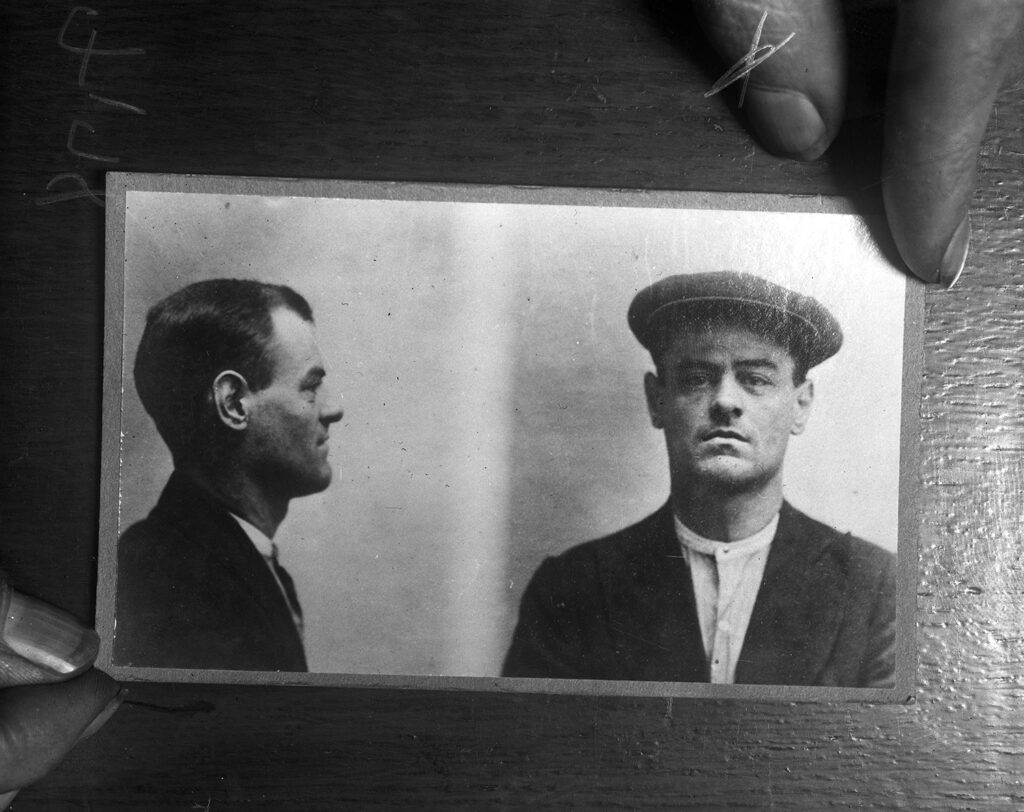
Thoughts filled the ether at the start of the tenth week of 1924. Three college psychologists sent out their thoughts over the airwaves from WJAZ, the radio station at the Edgewater Beach Hotel, in the largest test of telepathy in history. In a series of twelve three-minute tests, thousands of listeners at home were asked to receive and record thought projections of, among other things, a number from 1 to 1,000, an animal, and a piece of food consumed by one of the psychologists at the station. All results were to be submitted by midweek.
Similar mysteries of the heart and mind filled the pages of the Tribune during that week. Two former reporters, John Seymour and Thyra Samter Winslow, announced that after twelve years of a happy marriage, they were separating—not getting a divorce but rather taking a one-year vacation from matrimony. They planned to go together to Europe once the year was up. Explained Thyra, “For twelve years we have been together so much that we are afraid of losing our individuality.”
While the Winslows were putting their love on hiatus, another couple was just getting started. The previous fall, Erlean Berry had found herself temporarily overwhelmed by the rush of traffic in the middle of State Street, near Madison, the “world’s busiest corner.” Standing still amid the streetcars, taxicabs, and pedestrians passing around her, Erlean was awakened from her stupor by a shrill whistle blown by Officer Edward Schimmel. Expecting to harangue her for jaywalking, the officer instead found himself smitten when she looked into his eyes and smiled. A romance took its first step as he led her across the street. In the tenth week of 1924, they married.
Such tenderness was intended to be absent from the Christ Brotherhood religion, founded by one Adam Thomasson and based in a boarding house on Clark Street. The dozen followers of Thomasson abstained from sex, meat, and, money—the latter in the sense that they gave everything they earned over to their god incarnate. Apparently, Thomasson didn’t practice what he preached, as he was hauled before a judge, accused by disillusioned followers of propositioning some of them for sexual favors and using the church’s funds to purchase real estate in Florida. He did, it seems, practice vegetarianism. “All we get is raw carrots three times a day,” said one of the apostates, who deemed the lack of variety in the diet the worst offense.
Such restrictions would have protected the Christ Brotherhood members from falling afoul of some bad eggs—144,000 of them that went missing from a wholesale grocer. The eggs had been identified as “decomposed” by government inspectors upon their arrival in Chicago from the Ozarks. Intended for industrial use in a tannery, the eggs instead disappeared. Assistant District Attorney Mary D. Bailey brought suit against the grocer, who admitted to selling the bad eggs but wouldn’t name the buyer.
Growing frustrated with the lack of progress in the investigation of the murder of underworld figure John Duffy and his common law wife two weeks prior, State’s Attorney Robert E. Crowe decided to round up all of the city’s bad eggs, the human kind. These included several high-ranking hoods who were “nearing the millionaire stage through the peddling of contraband liquor,” such as Dean O’Banion, Earl Weiss, John Torrio, and one Al Brown, who obscured the lower half of his face with a newspaper when his photograph was taken by the Tribune.
Brown’s face would become well-known soon enough. What was known by Wednesday was that thoughts apparently couldn’t be transmitted over the radio. Four thousand WJAZ listeners mailed in responses to Sunday’s telepathy test. Out of that pool, 150 were selected and reviewed. No one identified the correct number, 664, although several, curiously, put down 994 and 499. No one picked a walrus, with a zebra and an elephant being the most popular choices. And no one could say that one of the psychologists had munched on a small beet.
Week Eleven: March 9-March 15, 1924
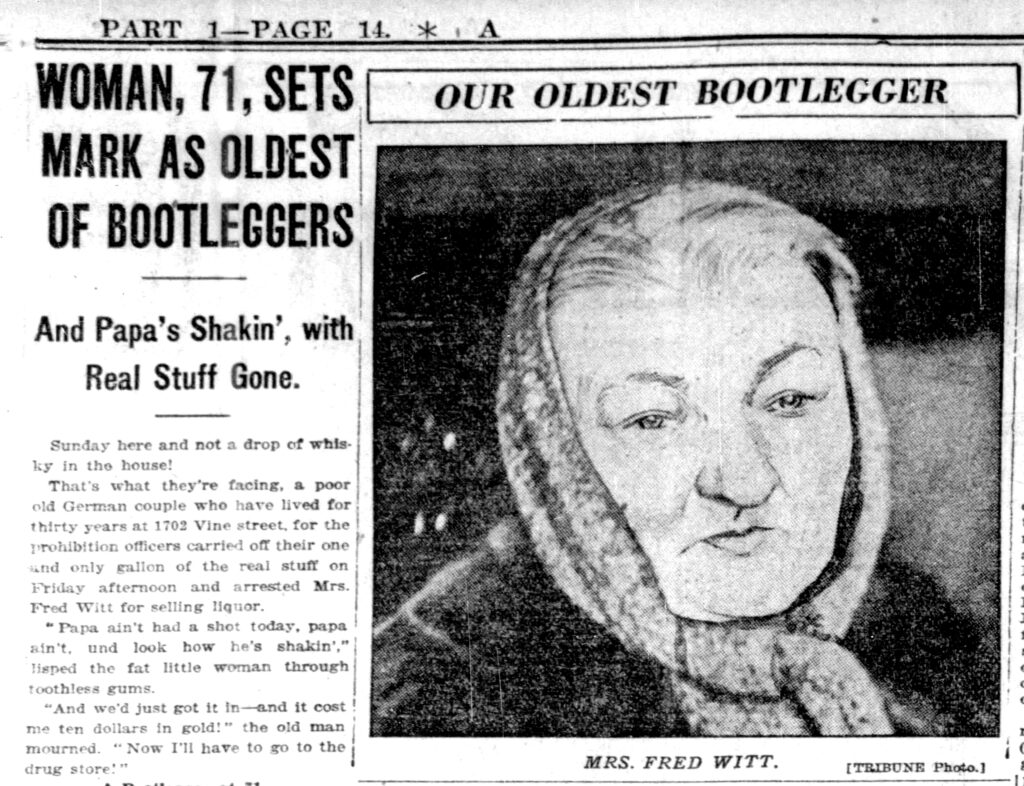
The ball got rolling in the eleventh week of 1924. The largest ball in the world, a “huge inflated sphere covered with red, white and blue leather,” set off from Chicago on a “tour of the country.” Destinations included Detroit, Cleveland, Buffalo, Albany, Philadelphia, New York, Washington D.C., Atlanta, New Orleans, Fort Worth, Los Angeles, Salt Lake City, Denver, Kansas City, and then Chicago again to complete the circuit. Pushing the ball were Boy Scouts, American Legionnaires, and members of other patriotic organizations, all in support of “citizens’ military training camps” run by the government. It was estimated the complete trip would take eighteen months.
As the ball moved forward, readers of the Tribune were invited to reflect back on past events. In Chicago, stories from the first weeks of the year, buried in the interior pages, reached their seeming conclusion. Officer John Mulcahy who had fatally shot cabaret employee Jenny Plarr on New Year’s Day was convicted of manslaughter and faced a sentence of one year to life. Edward Kocizca, who had fatally shot Mary Mitas at a Polish dance hall before turning the gun on himself on February 24, died of the gunshot wound to his head. Promoters of The Birth of the Nation won the right to screen the film at the Auditorium, which had been raided and shut down by the police during the week of February 3, after a jury determined it did not promote racial animus.
A more distant past also came to mind during the week. The St. John Baptist Church announced plans to honor Booker T. Washington, who had passed away in 1915, with a new social center to be built at Grand Boulevard and 36th Street. Originally from Alabama, the Reverend F.A. McCoo, pastor of St. John’s, had been a friend of Washington’s. The center was to have a statue of the educator outside the first floor assembly hall, along with offices for doctors and dentists on the second floor, a gymnasium on the third, and a dormitory on the fourth.
Harry K. Thaw, the millionaire who had murdered architect Stanford White in 1906 and then pled temporary insanity, received the right to a new trial to determine if he was sane enough to reenter society.
Inventor Nikola Tesla emerged from seclusion with the announcement that he’d perfected a “system of transmitting power without wires.” The system involved an “electrical generator which delivers its energy into the earth, whence it can be unlocked”and be “transmitted over wide stretches.”More ominously, the energy could be concentrated “in a beam” to “explode distant stores of explosives, in arenas and warships.”
Radio waves were put to a more immediate use when a poll of WJAZ listeners was conducted to gauge support of modifying the Volstead Act, the “first radio poll ever taken on the prohibition question.” Listeners favored modifying the act 27,120 to 10,071. Responses came from across the country and Canada, with the largest concentration of “wets” residing in the city.
Law enforcement, however, remained indifferent to public sentiment. Arrested that week was Mrs. Fred Witt, Chicago’s “oldest woman bootlegger”at the age of 71, who had resold some of her prescribed weekly medicinal whisky allotment to three young men later apprehended for speeding. The young men would get probation, it was predicted, while the nearly destitute Mrs. Witt would be issued a $200 fine.
After three years of failed pursuit, authorities finally nabbed the “gray wolf of Sheridan Road,” so-called because of the bootlegger’s ability to elude capture in his sleek gray automobile and his list of affluent clients in Evanston, Highland Park, Lake Forest, and elsewhere along the North Shore. The “wolf,”it turns out, was a “squat little German chemist,” Otto Von Bachelle, who made his own hooch at his residence in the 1600 block of Wells and merely convinced the well-off they were getting the good stuff.
Criminals of a younger age no doubt trembled at the news that Chicago was organizing a force of 600 “Junior Police” to patrol the city’s fifty-five playgrounds. The majority were high school students and members of the ROTC. Patrolmen were to receive silver badges, and officers would receive bronze badges, bestowed upon them by Chief of Police Morgan Collins at the formal swearing in ceremony scheduled for early May. The new force would “minimize the dangers to which many teachers have been exposed at the hands of neighborhood gangs” and “attacks of rowdies upon school children will be eliminated.”
One threat the Junior Police couldn’t address was the invisible spread of disease. Fortunately, Chicago had health commissioner Herman N. Bundesen—who’d also made a citizens arrest of a truck driver in violation of the city’s “malicious noisemaking” ordinance that week—to respond swiftly to an outbreak of smallpox among students at Trumbull, Brown, Franklin, and Emerson schools. Unvaccinated students were ordered to remain at home to prevent the outbreak from becoming an epidemic.
Week Twelve: March 16-March 22, 1924
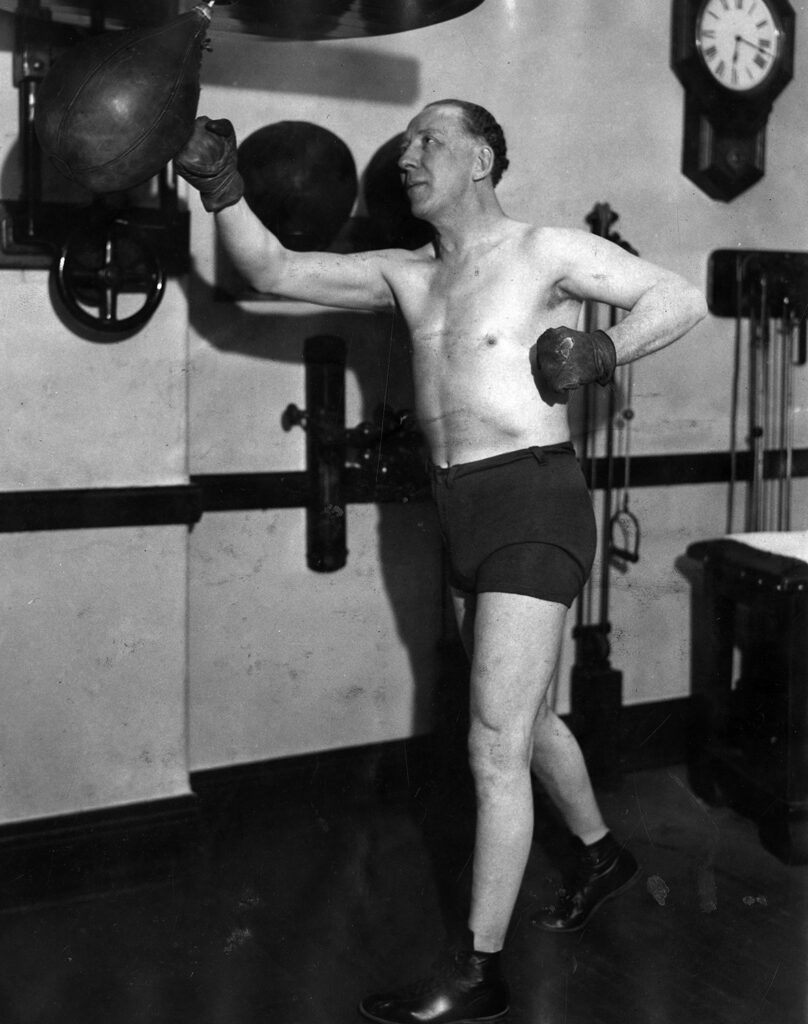
In the twelfth week of 1924, the first day of spring, March 20, brought snow. “At 3:20 o’clock the air was filled with white flakes which C.A. Donnel, weather forecaster for the Chicago district, readily identified as snow,” observed the Tribune. “A half gale made the storm take on the aspects of a blizzard.”
The week had gotten off to a blustery start. The Inquiring Reporter had asked five Chicagoans, “Why are people less agreeable on Monday than other days of the week?” Among the responses, Joseph Cerveny, whose profession was listed as “bread maker,” provided the most succinct: “I suppose because they have a week of hard work ahead of them, and maybe not too much pay for it. The fun’s all over and for six long days they have little to look forward to except monotonous work.”
“Monotonous” was not how one would describe a meeting of the city council’s finance committee as first reported on Sunday. Full-on fisticuffs broke out between Aldermen John H. Lyle and U.S. Schwartz as the two disagreed over whom should report on the law department’s budget needs. For three minutes the two brawled while several of their colleagues sustained injuries attempting to separate them. Having received some bruises and lacerations, the two ultimately reached an accord and left City Hall for dinner arm-in-arm.
The brawl preceded the finance committee approving the largest annual budget, at $46,609,700.00, in the city’s history. Alderman Lyle, the “lone dissenter,” vowed to claw back some of the expenditures on city worker salaries before the entire council voted on the budget.
Politics abroad was no calmer. Voters went to the polls in the Westminster district of London to fill a seat in Parliament. Running to represent the wealthy area were Conservative candidate Otto Nicholson, Liberal candidate Scott Duckers, Labor candidate Fenner Brockway and former Liberal MP turned “independent anti-Socialist” Winston Churchill. At the close of the day, Brockway and Churchill appeared to be the favored among the four. “The election is especially interesting,” the Tribune noted, “because, if Churchill, who is one of the most clever British politicians, wins he will become a recruit of the Conservative party, with a good chance of eventually securing the leadership and becoming prime minister.”
Another leader of a very different character was encouraging a very different practice of politics in Bombay. Recently released after two years of imprisonment for opposing British imperialism, Mahatma Gandhi gave an interview to the Tribune’s foreign correspondent Thomas Ryan. “Civil disobedience is always an advisable weapon when the government is not based on the will of the people,” said a visibly but not spiritually weakened Gandhi, “but it is practicable only when the masses are imbued with a spirit of nonviolence.”
In the interview, Gandhi voiced support for certain educational reforms and temperance in India. Back in Chicago, in the twelfth week of 1924, both were subjects for innovation. The Chicago Public Schools promoted its first fully “accredited branch” in the Cook County Jail, offering 120 incarcerated young men a chance at an education. Josephine Kumtinan, meanwhile, was arrested for fronting the most compact and mobile of speakeasies: “Underneath her long black coat she wore suspended from her neck by a stout cord a large copper tank, curved to fit comfortably over the body. This was equipped with a valve for measuring out a small quantity of liquor and also a couple of glasses.”
Week Thirteen: March 23-March 29, 1924
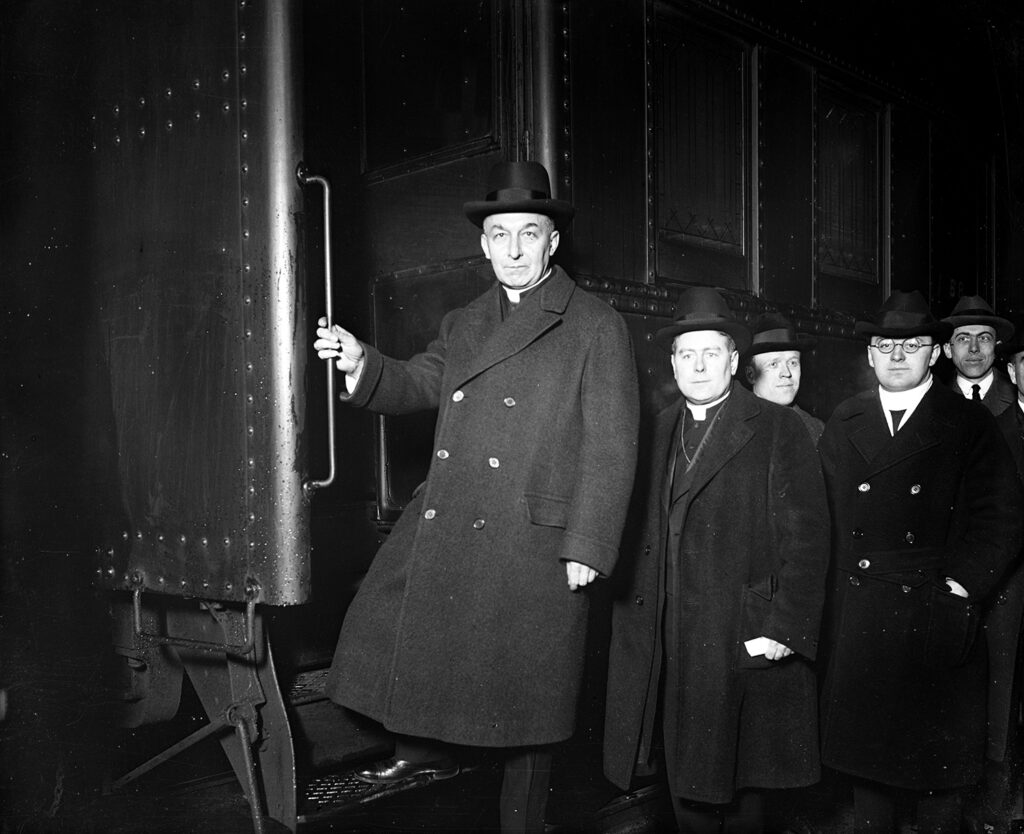
A fox took flight, and the President’s cat went missing in the thirteenth week of 1924. On Sunday on the southwest side, seventeen-year-old Milton Hons, accompanied by his three younger siblings, took his pet red fox Susie on a walk through the neighborhood. At one point Susie snatched the lead from Milton’s hand and sprinted toward freedom. The children gave chase, and soon others joined in, but the swift animal evaded them. It was not until Milton was able to flag down and commandeer a passing automobile that he overtook Susie, cornering her in an alley near 25th and Crawford Avenue, about ten blocks from where she’d escaped.
Standing pat rather than taking flight was Notre Dame football coach Knute Rockne. After being courted to take over Iowa’s squad, Rockne instead signed a ten-year contract with the Catholic university in South Bend, saying, “I will never leave Notre Dame as long as they wish to retain me.”
Also sticking around for awhile were the objects placed in the time capsule in the cornerstone of the new thirty-two-story Straus Building on Michigan Avenue, near Jackson Boulevard. Making up the contents of the capsule were “(f)ive phonograph records containing jazz music and the offerings of famous artists, a package of needles for the same, a strip of movie film, and Chicago newspapers bearing the March 25 date line—all representatives of civilization as it obtains in 1924.”
Time would tell if the contents of the capsule stay in place as long as the skull of the so-called “Los Angeles man” had—thousands of years, in fact. Recovered from a “vast glacial pond of oil in which skeletons of the giant sloth and the saber-toothed tiger” and other ancient creatures resided, the skull was “decidedly more primitive and more receding than that of the Neanderthal man.” Its discovery revived debate as to whether “man emerged from some lower state at one time and place on the earth or whether he evolved at various times and places.”
Something slightly less ancient was on display in Rome, as a phalanx of black-, red- and purple-robed men, led by Pope Pius XI, elevated George Mundelein, Archbishop of Chicago, to the College of Cardinals. “It is no personal merit of mine that this honor has come to me,”said the new Cardinal. “The sovereign pontiff desires to reward the good children of Chicago.” Mundelein became the first Cardinal west of the Allegheny Mountains. Joining him in this station was the Archbishop of New York, Patrick Joseph Hayes.
In Tehran, the holy men of a different faith took to the streets to protest attempts to establish a republic. Brandishing signs reading “Down with Republicanism” and “Long Live Islam and the Shah,” they viewed the creation by their parliament of a more representative government as “another British weapon introduced to undermine the Islamic faith.” Supporters of the republic also accused the British, but, in this case, of fomenting civil unrest to serve their needs. By the end of the week, a compromise had been reached to depose the current Shah but retain the present form of government by installing his younger brother in the role.
Someone who’d have relished the opportunity to pour out his sins before leaders of any faith was Harry Thomas. Dubbed the “champion confessor,” he made his 283 confession before Judge John R. Caverly for crimes “ranging from burglary to murder.” It was believed the state’s attorney would pursue the death penalty if Thomas was convicted of the latter.
One crime Thomas couldn’t take credit for was the disappearance of President Calvin Coolidge’s cat Tiger, or Tige for short, from the White House. Having darted out into a snowstorm, the beloved feline was believed lost, but a S.O.S. sent out over the radio led to a quick recovery. The cat received a new collar with the words “White House”stamped on it.
Week Fourteen: March 30-April 5, 1924
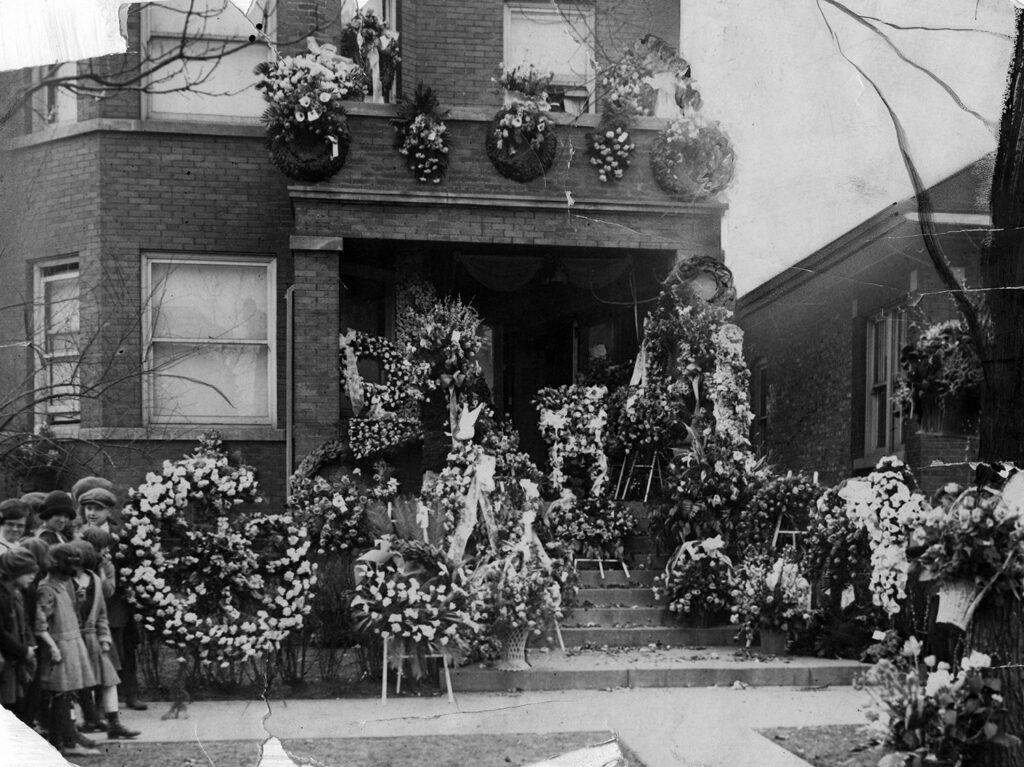
New truths about African animals formed the heart of a lecture by Carl Akeley at the Field Museum. Having returned from a three-year expedition to the continent, with several specimens that he intended to stuff and mount, Akeley shared how wrong some of his and presumably the audience’s preconceptions were. The lion was not vicious, but brave, a protector of its territory and indifferent to man. And the gorilla was of a “gentle, kind, and inquiring nature.” He regretted having killed three—a male, female, and their offspring—for the museum. “Shooting gorillas is about as much sport,” Akeley remarked, “as shooting blind and crippled women.”
In the fourteenth week of 1924, most violence was man made. In Romania, while in the middle of addressing more than a hundred business leaders at the Economic Institute, banker Aristide Blank was assaulted by a mob of fifty young men. They were part of a large wave of Antisemitic violence cutting across Bucharest in the wake of the trial of a man accused of attempting to murder a prominent Jewish newspaper publisher. As the young men beat Blank, they shouted, “Hurrah for Henry Ford,” the American car manufacturer from whom they’d gleaned their worldview.
A similar spate of violence greeted the election of the village board in Cicero, just west of Chicago. On the night before voters went to the polls, armed men stormed into the office of the Democratic candidate for village clerk and pummeled him with the butts of their revolvers, while the candidate for village president barely escaped being shot. Kidnappings and beatings of poll workers and voters marred election day as Democratic and Republican candidates vied for the control of the village and, more importantly, its 143 saloons, operating in defiance of the Volstead Act.
Allied with the Cicero Republicans was a transplanted South Side Chicago gang led by John Torrio. One of his associates, Frank Caponi, or Capone, didn’t make it to the ballot box. Caught in a shootout with a squad of Chicago police, brought in to restore order, Caponi took one in the heart and dropped dead into the prairie grass outside the enormous Western Electric plant. Four days later at the funeral held at the Prairie Avenue two-flat he shared with his mother and brother–Tony “Scarface” Caponi, also known as “Big Al” Brown, operator of the notorious Four Deuces resort–Frank got memorialized with three thousand roses that completely covered the house and the walk leading up to it. In addition to the various members of the Torrio gang, in attendance were some well-known politicians, judges, and Police Sergeant William Cusick whose squad had shot Caponi dead.
Two days prior to the gangster’s lavish funeral, the strains of the popular song “Hula Lou,” could be heard coming from within an apartment at 817 E. 46th Street. The song played for almost two hours straight before car mechanic Albert Annan arrived to discover his wife Beulah standing by the phonograph, the body of a dead man at her feet. The man, she said, was a stranger who’d attempted to assault her, so she shot him–in the back. Under questioning by police, she admitted the dead man was her lover, Harry Kolstedt. They’d spent the afternoon drinking and a lover’s quarrel had turned deadly. Sensing a memorable story, the Tribune had this to say of Beulah Annan, “They say she’s the prettiest woman ever accused of murder in Chicago—young, slender, with bobbed auburn hair; wide set, appealing blue eyes; tip-tilted nose; translucent skin, faintly, very faintly, rouged, an ingenuous smile; refined features, intelligent expression—an ‘awfully nice girl’ and more than usually pretty.”
Whether Beulah deserved to be executed for killing Koldstedt would be up for a court to decide. Wealthy Chicago playboy Augustus Darwin Curtis got what he deserved, not far from Algiers. Curtis had a “hobby for monkeys” and kept “several at his country home near Chicago.” Near Blida he “captured one of the baby apes, hoping to take it home,” but the “parents of the youngster pursued him.” He barely escaped with his life.
Week Fifteen: April 6-April 12, 1924
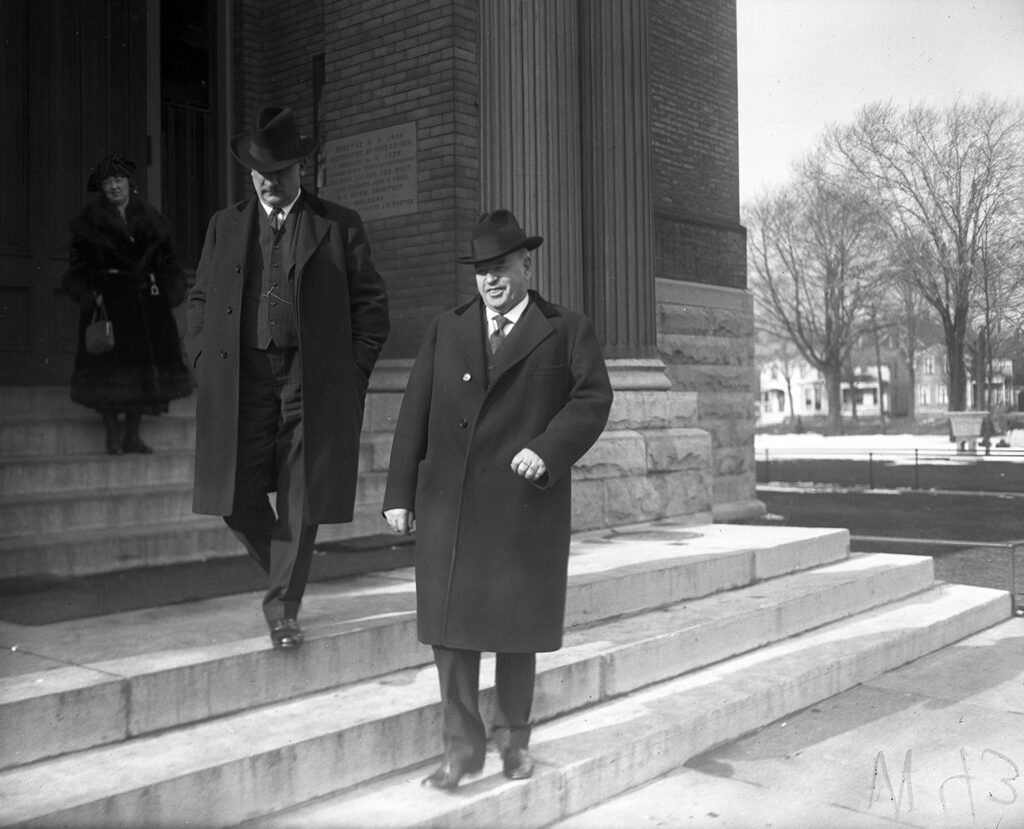
Illinois voters went to the polls in the fifteenth week of 1924. In the primary election, two of the most contested offices were the Republican nominee for Governor and United States Senator. The Chicago Tribune had led a long campaign against the incumbent governor, Len Small, under investigation for some corrupt practices during his time as state treasurer. In contrast, the newspaper supported the incumbent senator, Medill McCormick, whose family owned the Tribune. Illinois voters did not share the opinion of Chicago’s paper of record.
As the Tribune sourly announced the morning after the election, Governor Len Small “carried Cook county by a substantial margin and reports from downstate indicated that he was victorious there.” The race for the Senate seat was much closer. By Friday of that week, twenty precincts had yet to report their results. Former Governor Charlese Deneen led the incumbent Senator Medill McCormick by 4,091 votes out of over 800,000 cast statewide. Of the precincts yet to report, ten were in Chicago. One was thought to be the precinct where the ballot box was “stolen and is believed to have been thrown into the drainage canal at Thirty-first Street.”
Small triumphed despite a strong push for reform within the Republican Party. Among the leaders of this effort were Chicago’s Black churches. Before the election, twenty churches held events that denounced Small despite his campaign highlighting the appointment of a couple of Black state officials. At Olivet Baptist Church, with a congregation of over 10,000, making it the largest Black church in the nation, the Reverend L.K. Williams denounced Small and his campaign’s tactics from the pulpit.”My people are not to be bought in that way,”said Reverend Williams.”We care more for honesty in public administration than we do for a few favors that may be handed out to certain individuals. We call it an insult to say to us that our chief concern is not a decent and clean conduct of the affairs of the state, but the political prizes we may win.”He noted that Small had the support of the Ku Klux Klan.
And the Klan was sure to take credit for Small’s victory. In the Illinois Fiery Cross, published in Chicago and distributed statewide, the Klan patted itself on the back for helping rally support behind the beleaguered Small. “Even in Cook County with its strong and well organized Roman Catholic, Jewish, Negro, and alien citizen vote, the victory for patriotic Protestantism was almost as great,”the paper noted.
In Italy, another election occurred that week that solidified the power of a party that shared some of the Klan’s worldview. The Fascisti party led by Premier Benito Mussolin took 356 seats in the Italian parliament, far outpacing the second place Roman Catholic party and leaving the various socialist and communist parties with but a handful of seats. All in all, it was a relatively peaceful election in Italy, the Tribune observed, with only one man being killed in a brawl outside the polls at Tivoli.
Week Sixteen: April 13-April 19, 1924
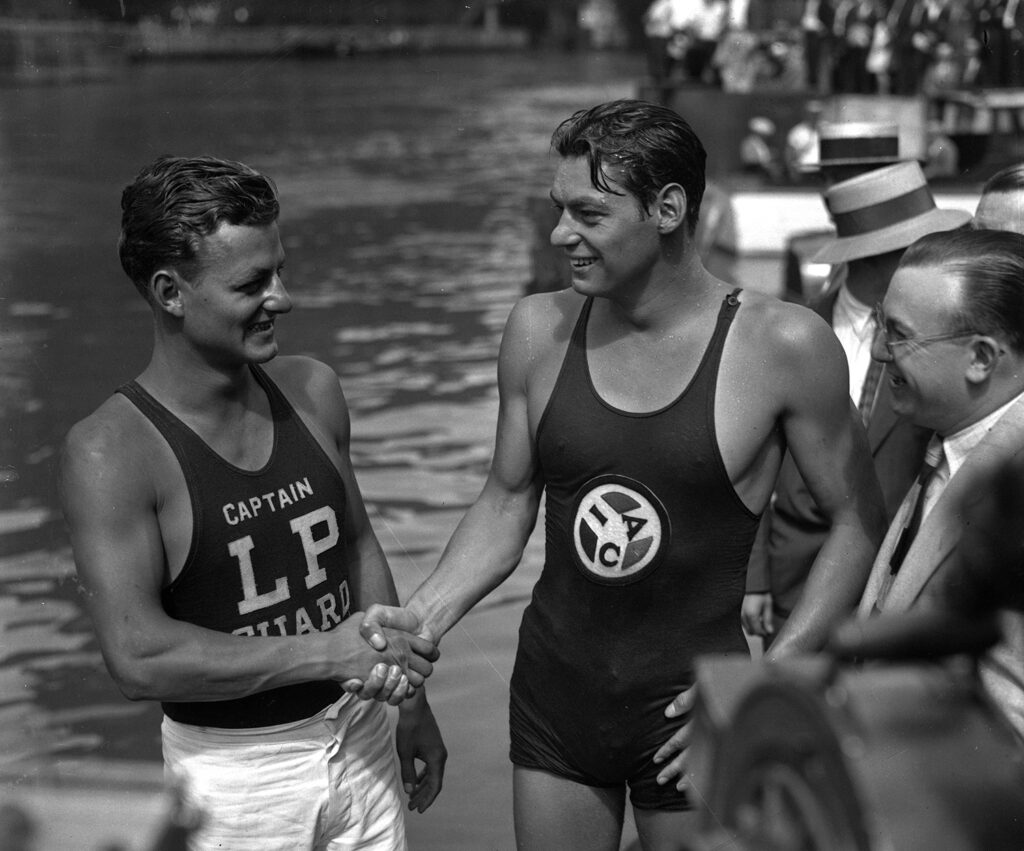
Baseball returned in the sixteenth week of 1924 bringing with it all the promise of the new season. Neither Chicago club got off to a good start on opening day. “No white hosed hero rose above the dust of battle at Comiskey Park,” as the White Sox were defeated 7 to 3 by the St. Louis Browns before a crowd of 25,000. As for the Cubs, playing on the road, the”Chicago entry pulled about everything that could be expected of a minor league outfit in the ninth inning and allowed the St. Louis Cardinals to score three runs and come from behind to win a 6 to 5 victory, much to the delight of some 18,500 rooting natives.” The Tribune predicted that the Cleveland Indians and New York Giants would win their respective league’s pennants that year.
It was a week of fresh starts and looking to the future. In Greece, in time for the centennial of Lord Byron’s death in support of Greek independence, voters overwhelmingly supported the establishment of a republic, abolishing the monarchy. Closer to home, at a banquet at the Congress Hotel, prominent Jewish Chicagoans pledged $150,000 toward a $300,000 campaign to establish a “Chicago colony in Palestine.” Speaking at the event, Mayor William Dever proclaimed,”The Jewish citizens of our city have decided to build a large agricultural colony to be named Chicago to perpetuate the name of our own great and prosperous city and to show appreciation of the advantages Chicago has given them.”
A more pessimistic attitude toward the future was expressed by the announcement that the French were working to revive development of a “death ray,” suspended at the time of the Armistice, ending the Great War, when it was learned that the English were working on a similar weapon, an “invisible radio ray,” capable of downing airplanes and being designed by inventor Harry Grindell Mathews.
The United States Congress feared not an external future foe but rather internal transformation. In an effort to preserve a majority of “Nordic” people and their descendants in the United States, the House of Representatives passed an “immigration restriction bill” 322 to 71. The new law would establish strict quotas on European immigration, tied to 2% of an ethnic group’s population based on the 1890 census, significantly reducing the number of migrants from Southern and Eastern Europe and “tend to make Northern Europe the chief foreign breeding ground of future American citizens.” The bill also excluded any Japanese migration, in defiance of the longstanding “gentleman’s agreement” between the two nations and straining the ties between the two. The immigration commissioner at Ellis Island, Major Henry Curran, when asked for his impression of the new bill declared, “Our gates have stood open long enough. It is time to close them a bit.”
A prominent Chicagoan was having his citizenship investigated that week by Representative Henry Rathbone of Illinois. Star swimmer Johnny Weissmuller’s father had been born in the former Austrian-Hungarian empire, but Johnny said he could prove he was born in the United States, thus ensuring he could represent the country at the Olympics in Paris that summer.
Weissmuller must have welcomed the news that the city council was examining a plan to create a six-mile long, uninterrupted bathing beach along Lake Michigan on the north side of Chicago. It was one of many projects announced that week that could, if they moved forward, profoundly transform the city. The planning commission hoped that Judge O.M. Torrison would dismiss the objections lodged by various landowners and clear the way to “transform South Water street from an alley-like street lined with rambling, ramshackle buildings into a two level riverfront boulevard and heavy traffic thoroughfare, flanked with huge skyscrapers.”
One of those skyscrapers would be the newly announced Jewelers’ Association building, containing the “world’s tallest garage,” with a quarter of its twenty-three stories given over to parking. It would join the Tribune Tower, the new Palmer House Hotel, the Straus Building, and the American Furniture Mart building in transforming the city’s landscape.
Another proposed project promised to give an old building from Chicago’s past a new purpose. The South Park District approved a plan to transform the former Palace of the Fine Arts from the 1893 World’s Columbian Exposition, abandoned since the Field Museum had moved into its new building a few years prior, into the “largest and finest convention hall in the world.”
Surveying all this growth and transformation. Colonel Robert R. McCormick could confidently predict in an address before the Chicago Association of Commerce that within a handful of years, the city would become the “great inland capital of the United States,” the center of art, science, and commerce for the nation. He attributed the certainty of Chicago’s destiny to its “ideal site”and the resilience of meatpacking, agricultural, tool manufacturing, and the Board of Trade in the face of “hostility from the government of the United States.”
“I can see nothing,” said McCormick, “which can change this excepting some great cataclysm such as had vast influence on other great nations and that is extremely unlikely.”
Another individual who earlier in his life had dreamed of a great future for Chicago died at the age of 68 from heart disease, poor and alone in a cheap hotel on Monday of that week, before any of the city’s grand plans had been announced in the newspapers. Arriving in the city in 1880, architect Louis Sullivan had designed the Auditorium Building, Chicago Stock Exchange, Schlesinger & Mayer department store, and Transportation Building at the 1893 World’s Fair, among other structures, forever transforming architecture in Chicago and the nation.
His last work would be reviewed in that Saturday’s paper by Tribune book critic Fannie Butcher, who proclaimed Sullivan’s recently published The Autobiography of an Idea “one of the few great American biographies.” “There is something peculiarly sad in the thought that the man who wrote this really great book should have died just as it was about to be given to the world,” Butcher observed, “a monument to him which will be firm and steady when the work by which men knew him by shall be crumbled.” Within days of his death, Sullivan was buried in Graceland Cemetery, with members of the American Institute of Architects and the Cliff Dwellers Club serving as the pallbearers.
Week Seventeen: April 20-April 26, 1924
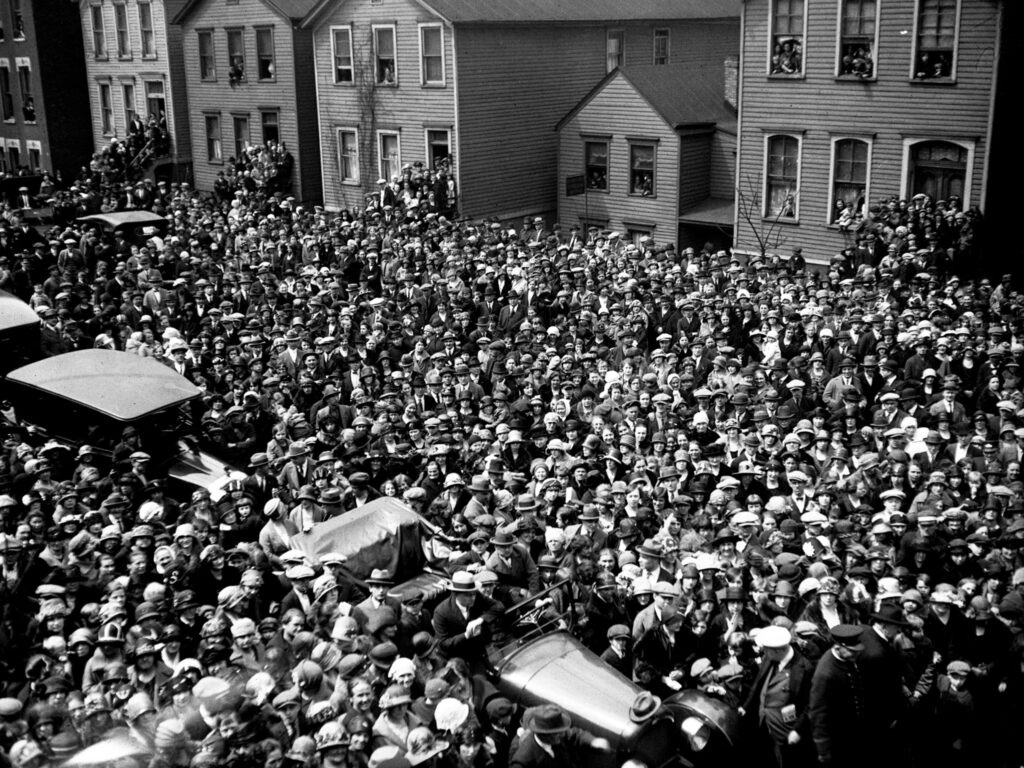
On Easter Sunday, prominent Chicagoans promanded along Lake Shore Drive, the “acknowledged parade ground for wealth and fashion,” in the seventeenth week of 1924. The holiday had fallen later in the year than usual, but the day was a cool one, with many forced to wear their winter coats. Men strutted about in silk hats and morning coats with “white carnations and gardenias in their buttonholes.” The hats the women wore remained small while green was a “popular color this spring, in all its shades.” Reflecting these trends was the ensemble of twenty-one-year-old Elizabeth Paepcke, née Nitze, who looked “unusually lovely in a reseda green cloth coat trimmed with dark fur, and a small black hat”that she wore to services at Fourth Presbyterian on Michigan Avenue.
A slow steady progression, like that of the Easter Parade, characterized the career of motorman Edgar Dickens, who marked 50 years of service on the city’s streetcar lines. It was believed that over the course of a half century–which had seen public transit go from horse- to cable- to electric-powered–Dickens had traversed 1,822,500 miles, “all of it here on Chicago car tracks.” Dickens, 74, observed the occasion on his regular 69th Street line.
A New Yorker with a fondness for Chicago marked his own milestone that week. Chauncey Depew, the former head of the New York Central Railroad and United States Senator, turned 90. He attributed his steady, healthy progression through life to his personal “philosophy.” “This is a pretty good world, and the people in it are pretty good people,”Depew remarked. “If you cultivate a sense of humor and the right outlook you won’t get dyspepsia or insomnia, and most of your troubles come from them. Most of the things that could upset us if they happened, never happen.”
Something upsetting did happen to twenty-three-year-old Wanda Stopa that week, cutting short her progression through life. It had started with tremendous promise. Born to a respected artist and a mother descended from minor nobility, Wanda grew up in a comfortable home within the Polish enclave on the northwest side, achieved academic success, and became, after attending law school, “Chicago’s youngest woman attorney.”
Wanda became intrigued by the city’s bohemian neighborhood, clustered around the old Water Tower. She started to frequent artist studios, teahouses, and cabarets. She married a ne’er-do-well Russian “count,” who mistreated her, but found comfort in the companionship of another fixture within the city’s creative community, advertising man Y. Kenley Smith.
The much older and married Smith regarded Stopa as the “brainiest girl” he’d ever met and, when she gave up her career as a lawyer, supported her financially. According to friends, Smith was a “romantic humanitarian” who supported several struggling artists and bohemians. Wanda took this as a sign of his love and, aware of his unhappy marriage, became determined to wed him.
All of this led to an encounter between Stopa and Smith’s wife, Vieva, at the latter’s cottage in Palos Park. Feeling ill, Vieva refused to engage with Stopa, who was demanding the Smiths divorce. When the cottage’s caretaker, Henry Manning, a sixty-eight-year-old former architect whose career and family had been destroyed by his alcoholism, attempted to intervene, Stopa pulled out a .38 caliber handgun and shot him through the cheek, killing him. Before Stopa could turn the gun on her, Vieva jumped through a window and ran for help. Reached at his office in the Wrigley Building, Smith could only react in horror at the death of Manning and attempted murder of his wife.
Wanda disappeared. The police hunted her, but the search did not last long. Within a day she had been discovered dead in a room at the Hotel Statler in Detroit. She had ingested cyanide. The Tribune blamed Chicago’s bohemia for this tragic sequence of events. Wanda’s mother, Inez, the blood of Polish nobles flowing through her veins, felt otherwise, saying of Y. Kenley Smith, “no gray haired man, no matter how rich, who makes love to a little girl while he has a wife is anything but a bum.”
Week Eighteen: April 27-May 3, 1924
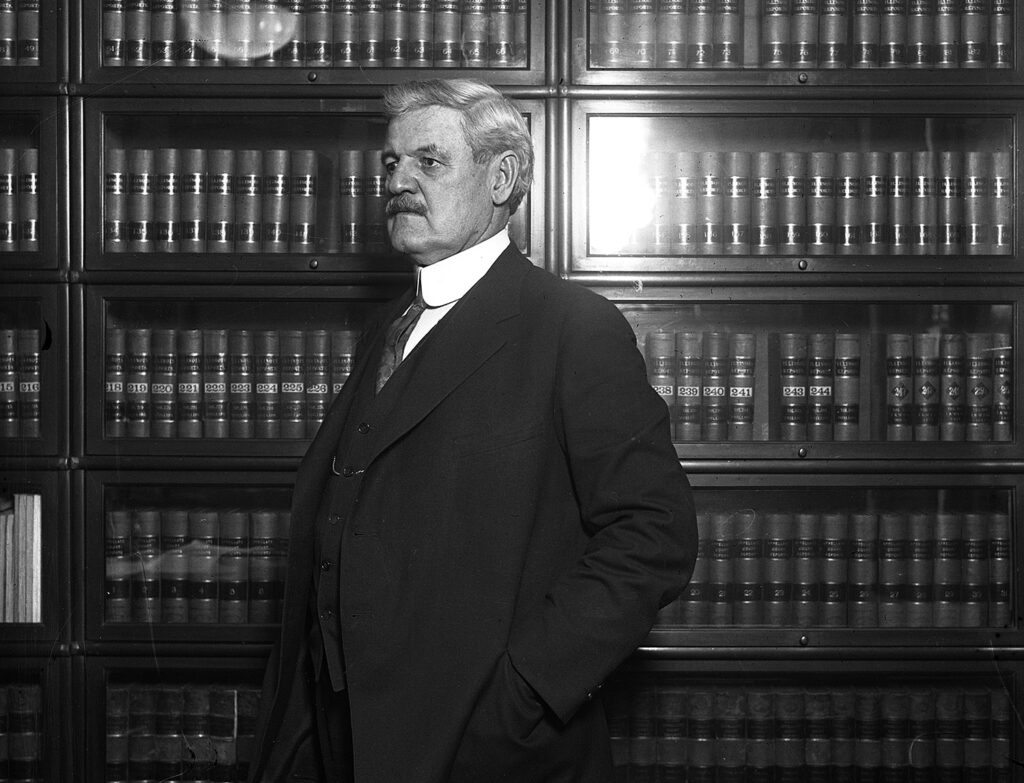
Shouts of “You’re a liar” met Health Commissioner Herman Bundesen when he suggested at a public meeting of the city council’s health committee that “vaccination was necessary for the prevention of epidemics.”For over three hours, the gathered “medics–homeopaths, allopaths, neuropaths, osteopaths, and chiropractors–as well as cult leaders, anti-vaccinationists, and others fought over the merits of their respective theories.”
They had come to protest the proposed creation of a city board of health, one of many reforms supported by Mayor William Dever. In the eighteenth week of 1924, Dever and 1,000 of his supporters celebrated the completion of one year in office with a large party at the Edgewater Beach Hotel, in the former judge and alderman’s old ward, the 49th.
A year prior, the Democrat Dever had defeated the Republican incumbent, William Hale Thompson, largely perceived as being corrupt. Once in office, Dever set out to reign in crime associated with bootlegging, root out the graft present at almost all levels of city government, and champion the consolidation of public transit lines and implementation of the Plan of Chicago.
Dever stood in stark contrast to many of his fellow politicians. Illinois Governor Len Small had been accused of various crimes but managed to be renominated in the recent Republican primary. In neighboring Indiana, Republican Governor Warren T. McCrary learned that he didn’t share Small’s luck. A federal jury found him guilty of mail fraud–the result of a somewhat complicated scheme in which the governor had bilked Hoosier bankers out of close to a million dollars–and the judge sentenced him to a $10,000 fine and ten years in the penitentiary in Atlanta. In handing down the harsh sentence and having McCrary immediately remanded into custody, the judge pronounced “there is no difference between the lowest criminal and the highest.”
That didn’t seem to be the case in Washington that week. While congressional investigations into various misdeeds committed by members of the former Harding Administration and the current Coolidge Administration continued, a jury took only a few hours to dismiss charges against Minnesota congressman Harold Knutson. He had been arrested the previous March after having been discovered in the company of a much younger government clerk in the backseat of an automobile parked along a remote stretch of country road in Virginia. Knutson claimed he’d done nothing indecent but did admit to offering the arresting officers money in order to make the whole matter go away. “I didn’t want the headlines in the papers saying ‘Congressman Arrested!’ regardless of how malicious the arrest might be,”said Knutson, who also worried about what his elderly mother would think.
While corruption didn’t seem likely to tarnish the reputation of Chicago’s mayor, Dever couldn’t control larger forces at play that might sink his administration. A bulletin released by the Chicago Crime Commission reported that 86 murders had occurred in the city in the first 91 days of 1924–almost a murder a day. The Commission noted that in the previous year, 270 murders had occurred in all of Cook County, but only 129 suspected killers were indicted by grand juries. The Commission blamed the slow, uneven pace of justice for the uptick in crime.
One person whose day in court would not be delayed was Mrs. Belva Gaertner, accused of the fatal shooting of automobile salesman Walter Law while the two were together in her car. As the trial began, the defense asked that the automobile, the scene of the crime, be released from police custody to Belva’s husband, which the judge denied. The Tribune noted that Belva “appeared in court garbed in the same fashionable suit and hat which she has worn on other occasions.”
Week Nineteen: May 4-May 10, 1924
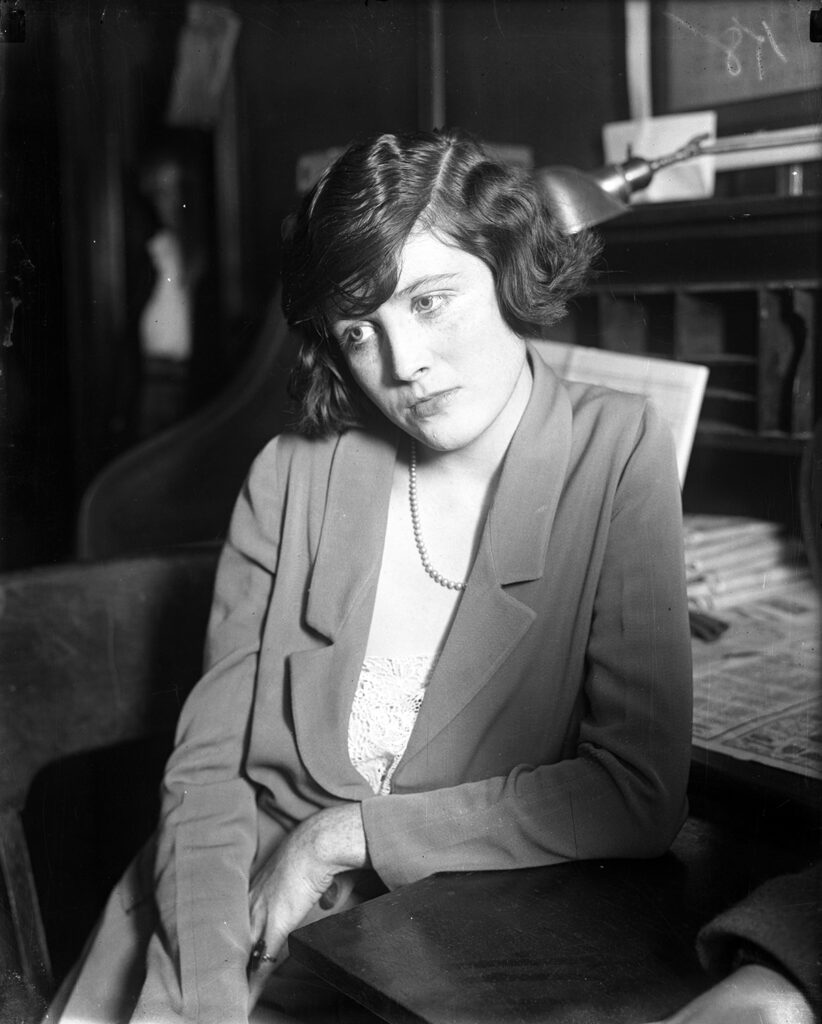
Duchess, an Indian elephant aged somewhere between 85 and 90, dropped dead while eating her afternoon meal of hay in her “winter home, the monkey house,” at the Lincoln Park Zoo. She had been at the zoo for over thirty years, after being gifted to the city by P.T. Barnum. A call for a replacement elephant went out immediately, and Duchess’s remains were sent to the Field Museum where her hide would be removed, preserved, and put on display. All Chicago mourned her passing.
The slow, quiet death of Duchess matched the mood of the beginning of the nineteenth week of 1924 as various stories unfolded with little urgency or drama behind them. A Princeton astronomer threw cold water on the notion that the radio could be used to communicate with life on Mars for the simple reason that there was no life on Mars. The canals that amateurs claimed to see on the planet’s surface were merely the product of the “defective human eye or the imperfect telescopic lenses.” A French astronomer claimed, however, that Mercury could be inhabited. “The heat and light on Mercury are seven times more intense than on the earth,” he said. “But the atmosphere surrounding the planet is so compact that their effects may be less violent.”
Closer to home but no less heated was John Phillip Sousa’s testimony before the House of Representatives patent committee that Prohibition had killed the light opera, which almost always contained “drinking songs of the rollicking kind.” According to the band leader, “we can’t write them nowadays as, apparently, the inspiration is lacking.” He was there with composer Victor Herbert to testify to the detrimental impact radio broadcasts were having on the sale of music–why would anyone buy sheet music or a recording when one could listen for free to a song on the radio? And by the time a listener did get around to buying the music, it would be waning in popularity due to overexposure on the airwaves.
Recently returned from Egypt, the University of Chicago’s James H. Breasted had with him an example of a far earlier human innovation whose impact continued to be appreciated into the present–a bed. Its first occupant had slept in it before the pyramids of Giza had been built, making this treasure the “oldest piece of furniture that has ever yet reached the shores of the American continent.”And yet, with its four legs carved to resemble those of a bull and its “leather thongs … strung to serve as a plaited, hammock-like spring,” the bed seemed remarkably contemporary in regard to style and comfort. It was to find a place in the University’s Oriental Institute. Equally compelling was Breasted’s announcement that week that, having translated several ancient manuscripts recovered from King Tut’s tomb, he had concluded that, yes, the Trojan War had been fought and that a real woman named Helen had been at the heart of the conflict.
While Helen of Troy’s beauty may have swayed the conduct of armies, the beauty of Beulah Annan and its potential impact on a Chicago jury continued to be debated. An older, less attractive killer of her lover had been recently spared the death penalty, so, the Tribune reasoned, Beulah’s chances seemed pretty good. Plus, she was expecting a “visit from the stork” in the fall, and who would want to be responsible for the taking of an innocent life by convicting the mother?
But the taking of a life is what upended the slow unfolding of the nineteenth week of 1924. On Friday, the front page blared “Gunman Killed by Gunman.” At a saloon on Wabash, near 23rd, John Howard, “beer runner and burglar” had been shot six times in the face while talking with three friends near the cigar counter. The killers had been two men who’d come off the street and gone directly over to Howard. One was short and thin, the other tall and fat. The tall and fat one had fired the gun, while the short and thin one had held onto Howard, according to an elderly carpenter who’d witnessed the shooting from his seat near the back of the saloon. He’d also heard the tall, fat man addressed as “Al.”
The police immediately began to search for Al Brown, beer runner and proprietor of nearby dive the Four Deuces, also making sure to check his home on Prairie Avenue, where he told his family he sold used furniture for a living and went by his birth name, Capone. The police couldn’t locate Capone. They couldn’t find the three friends who’d been beside Howard when he was shot. The saloon owner claimed to have seen nothing and said, despite being neighbors, he knew Capone only by reputation, while the carpenter admitted he didn’t see the shooter’s face. “I am sure it was Capone, and I know just what happened,” said Chief of Detectives Michael Hughes, but the motive remained a mystery and without other witnesses there was no case.
Week Twenty: May 11-May 17, 1924
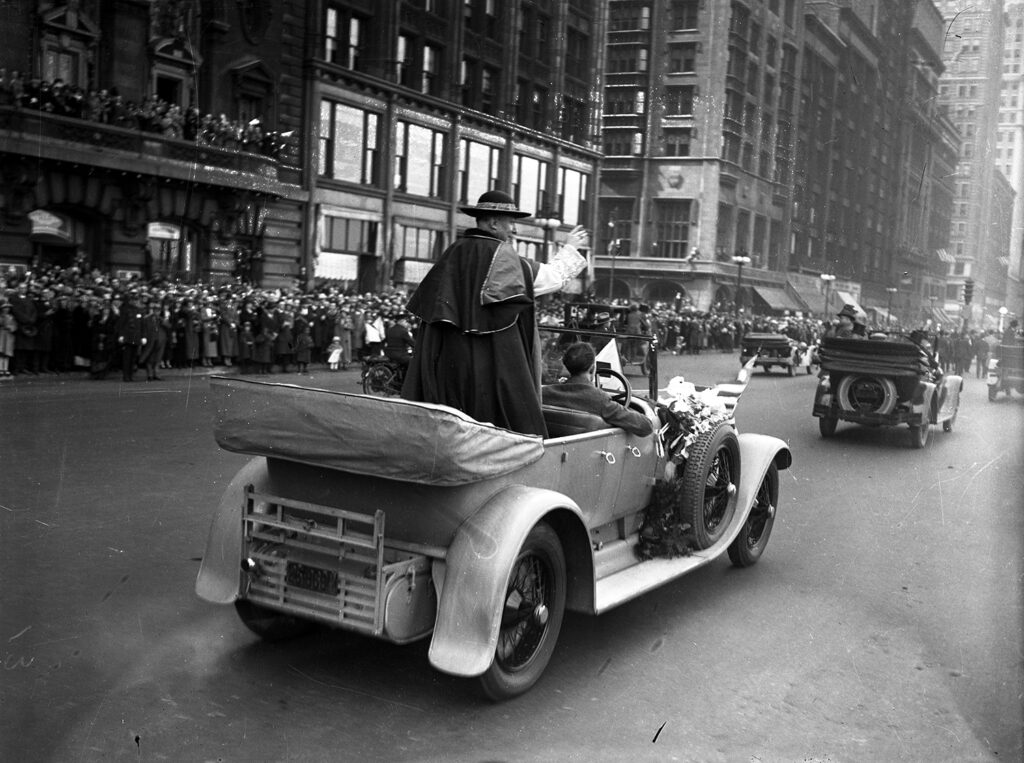
Chicagoans welcomed home their first Cardinal, George Mundelein, in the twentieth week of 1924. Hundreds of thousands lined the streets as this “prophet of the future rather than the prelate of the past” processed toward Holy Name Cathedral. Among them were Edward “Spike” O’Donnell, beer runner and racketeer, along with his wife, his seven-year-old-son, his son’s cousin, and $9,700.00 in the pocket of his overcoat. Lifting his son above his head to better see the Cardinal pass, O’Donnell failed to notice someone pilfering the cash from his pocket. He reported the crime to the police in the hope that the thief, upon learning whom he’d robbed and taking into account the reaction of O’Donnell’s wife to the crime and the solemnity of the occasion, would return a portion of the cash.
Prohibition and its violators, like O’Donnell, filled the pages of the paper that week. In Washington, former Chicago attorney and pharmacist, and current inmate at the federal penitentiary in Atlanta, George Remus, testified before Congress about the amount of corruption, some at the highest levels of government, that had allowed him to prosper as a bootlegger. He derided the issuing of permits to pharmacies for the sale of medicinal whisky as the “greatest comedy, the greatest perversion of justice ever known in the civilized world.”
This sentiment seemed to be shared by James and Dan McHale, owners of a seafood restaurant where there were more “pickled” customers than herring. The brothers had received a “tip off,” and prohibition agents were greeted by bolted doors and barred windows. With their “noses flattened against the big plate glass front windows,” the agents observed the restaurant’s employees pour gallon after gallon of what appeared to be liquor down the drain. Then came a “deluge of fish” over the “back transom”onto a squad of agents, which was enough to prompt them to break down the door and arrest the McHale brothers.
Residents of Thornton, a village to the south of Chicago, took a raid of a popular roadhouse by prohibition agents more seriously. When the agents removed several barrels of beer and prepared to pour it into a nearby creek, they found themselves surrounded by an angry mob of armed villagers. Drawing their own weapons, they persuaded the villagers to disperse and then disposed of the beer.
Perhaps the prohibition agents merely had the health and well-being of the residents of Thornton in mind when they confiscated their beer. One unforeseen result of prohibition, according to the presidents of both Northwestern University and the University of Chicago, was the drop in the number of cadavers available for education and research. Interviewed to gauge whether they shared the opinion of the president of Columbia University that the Volstead Act should be amended to allow for legal beer and wine, the two Chicago educational leaders avowed support for the act as written and said that their respective medical programs were contending with a shortage of bodies, as the number of “hobos, bums, and floaters” killed by alcoholism had steadily declined since the 18th Amendment went into effect in 1920.
Someone acutely aware of a decline, at least in fun and frivolity, was Ike Bloom, longtime proprietor of Freiberg’s Dance Hall, who announced his retirement. For over twenty years, Bloom had managed the hall, which despite its location in the city’s vice district had welcomed residents of all social stations to dance the night away. At Freiberg’s, the “respectable could dance on the same floor with the not so respectable. There politicians, actors, actresses, society slumming parties, bejeweled queens of many a First Ward ball, and kings of the old levee were wont to gather nightly.” In his retirement, Bloom planned to open a cigar store in the Loop and resume using his birth name, Isaac Gitelson.
Week Twenty-One: May 18-May 24, 1924
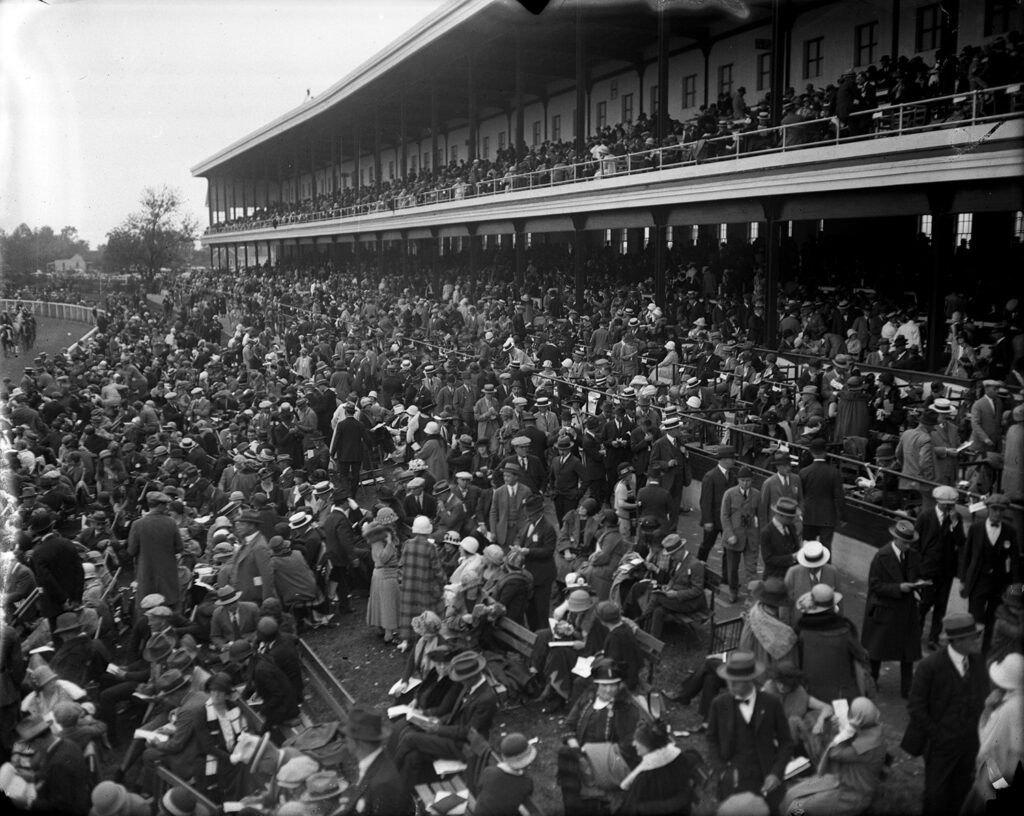
Calvin Coolidge caught a cold in the twenty-first week of 1924. At first it was believed to be a case of “rose fever,” the result of having attended the circus and then a White House garden party given by Mrs. Coolidge. Instead, it proved more serious, and the President, like Solomon Grundy, got sick on Wednesday, and sicker on Thursday, so much so that he had to cancel attending a second garden party.
While the President slowed down, the world did not. Sunday’s paper was full of Saturday’s news, which included a victory at the wire in the 50th running of the Kentucky Derby. Black Gold, owned by Rosa M. Hoots, an Osage woman from Oklahoma, won the derby by a nose. In Chicago, the Colonial Theater lowered its curtains for the final time after its Saturday performance. The relatively young theater in the Loop was slated for demolition but would be forever remembered for the over 600 people who died in a fire there in December 1903 when it was called the Iroquois.
While the tragedy of the Iroquois Theater fire survived in living memory, the stories archaeologist Howard Carter spun that week at Orchestra Hall had long remained buried in the past. Sharing for the first time in Chicago his many discoveries from the tomb of the boy pharaoh Tutankhamun, Carter included among them his belief, based on various artifacts, pictorial evidence, and an inscription–”with these my worldly goods I thee endow”–that the ruler had married for love. “It is a charming story, a sweet story, that is told in Tut’s tomb,” said Carter. “Those were the days when men and women married for love, when they lived in love and died together and happily.”
There was no love to be found between gang leaders Johnny Torrio and Dean O’Banion when the two of them, along with several corrupt Chicago cops, were swept up in a raid of the former Sieben brewery. The South Side gang, led by Torrio, had just bought controlling shares of the brewery from the North Side gang, led by O’Banion, when the raid occurred.
Even less love existed on the streets of South Bend, Indiana, where the Ku Klux Klan had burned a cross outside the “headquarters in the business district” and were openly planning a “masked May festival of klansmen from four states.” Around 2,000 angry residents gathered outside the Klan’s office in response to a klansman having assaulted a student from Notre Dame. As the police moved in to restore order, Father Mathew Walsh pleaded with university students to remember the example of Christ and not engage in any violence.
In Germany, Fascists and Communists continued to clash. The former Kaiser, Wilhelm II, announced he was now a Fascist. He delighted in giving visitors a silver swastika and copies of the “Protocols of the Elders of Zion,” published by Henry Ford, a document whose fictions presented as facts were inflaming antisemitism across Europe.
A true account of the history of the Jewish people in Chicago was celebrated at the Chicago Historical Society. The culmination of 10 years of research, the history encouraged Jewish Chicagoans to, in the words of its author H.L. Meites, “realize how much you have done for the city, how truly American you are, and lift up your heads higher and be better Americans.”
While it was not reported in the papers until the end of the week, on Wednesday, a young boy went missing in the early evening in the Kenwood neighborhood while walking from his private school two blocks back to his home. While his father was out searching for him, his mother received a phone call informing her that their son had been kidnaped and was being held for ransom. Early the following morning, the boy’s dead body would be discovered far to the south in Wolf Lake. He had been murdered. His name was Bobby Franks.
Week Twenty-Two: May 25-May 31, 1924
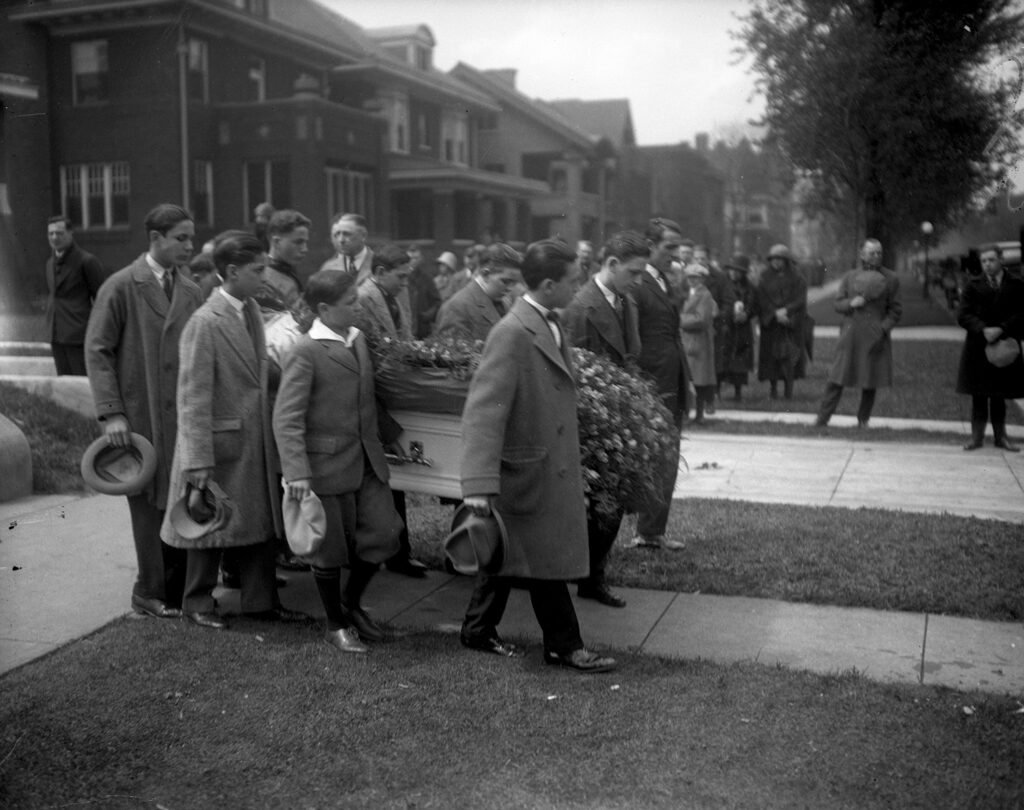
The ghost of Lenin stalked London in the twenty-second week of 1924. This according to Sir Arthur Conan Doyle, the creator of Sherlock Holmes, who’d attended a seance in Piccadilly where the spirit of the relatively recently deceased Russian manifested himself. Lenin brought a message of peace but also of potential conflict between his country and England.
Future conflict seemed to be front of mind for several governments as England, France, Germany, and the United States all let slip that their militaries were working on the development of a “death ray” that could use wireless electrical currents to disable whole armies and navies The race to perfect the ray was set off by English scientist Grindell Mathews offering to sell his invention to the French, but he could be persuaded to arm his countrymen for the right price.
First in peace, first in war, and first in the hearts of Chicagoans was founding father George Washington, a portrait of whom by Gilbert Stuart was unveiled at the Art Institute of Chicago with Mayor Dever there to present it to the museum’s director. Over “25,0000 Chicagoans and 200,000 school children”had contributed to raising the $75,0000.00 to buy the portrait from a private collector, with the Chicago Tribune playing a leading role in this patriotic campaign.
A more local legend was believed to have resurfaced in Minneapolis. In 1921 Thomas “Terrible Tommy” O’Connor had escaped from the Cook County Courthouse days before being executed for having slain a police officer. The man arrested in Minnesota admitted his name was Tommy O’Connor but denied being “Terrible Tommy.”
At that same courthouse, Beaulah Annan learned whether or not she would be found guilty of the murder of her lover Harry Kalstedt. Despite having shot Kalstedt in the back and listening to a recording of “Hula Lou” on her Victrola over and over while he slowly bled out, Annan was acquitted by her all-male “beauty proof” jury, convinced by her story of self defense. That should have been the biggest story in Chicago that week, but Beulah’s crime had been overshadowed by one far worse.
All week, every day, the headlines in the Tribune flashed the latest developments in the Robert Franks case. The previous Wednesday, in the early evening, the fourteen-year-old boy had been walking home from school, a distance of four blocks, when he disappeared in the affluent Kenwood neighborhood. Later that evening, his parents learned to their horror that Robert, known to family and friends as “Bobby,” had been kidnapped and was being held for ransom. Early the following morning, far south of Kenwood, in a culvert in Wolf Lake, the nude body of a dead boy was discovered. The boy was Bobby. He had been murdered. Recovered along with the body was a pair of tortoise-shell-framed glasses, believed to be connected to the crime.
Within a day of Bobby’s death, the ransom note that had been sent to the distraught Franks was discovered to have been modeled on one that appeared in “The Kidnaping Syndicate,” a short story published in the May 5 issue of Detective Story Magazine. Furthermore, it was determined the note had been written on a portable Underwood typewriter. Police searched for a gray Winton automobile, seen by witnesses in the area where Bobby had disappeared. A seventeen-year-old girl had gone missing in the same place, around the same time on the same day, but, it was learned, had merely run off with her boyfriend. Teachers at Bobby’s private school came under suspicion. The Franks family received notes threatening their surviving children, and the police received tips from that led nowhere. On Sunday, Bobby’s funeral had been held at the family home, with several of his classmates serving as pallbearers.
Chief of Detectives Michael Hughes remained convinced that the glasses were the key to solving the crime. He told the Tribune he was trying to “see [the] slayer through his spectacles,” having reached the conclusion, upon consulting various opticians, that the glasses were not worn by a laboring person but rather one who sought to reduce eye strain brought on by prolonged close work and concentration. He was, according to Hughes, a “highly educated person who wore these glasses. A high strung nervous temperament.. Such a person would be likely to need such spectacles, and it is such a person we must look for.” Directly below that article appeared an advertisement for Almer Coe and Co. Scientific Opticians, whose motto was “Always the best in quality but never higher in price.”
Beneath an illustration of a pair of spectacles appeared a single word, “Responsibility,” which a brief paragraph expanded upon: “All who have purchased eyeglasses of Almer Coe & Company during more than a third of a century have found that this institution’s responsibility never ceases, that it positively assures eyeglass efficiency, comfort, and satisfaction.”
Almer Coe prided itself on keeping meticulous records. Once the glasses were determined to have been purchased from the company, an employee scoured over fifty thousand records before he determined three people in Chicago owned a pair with the same frame, prescription, and, critically, hinges, as the one found near Wolf Lake. Two of these individuals were quickly ruled out as suspects. By Thursday, police were beginning to question the third, who was familiar with the Wolf Lake area, having led birding trips there. He was a nineteen-year-old law student at the University of Chicago and resident of Kenwood, Nathan F. Leopold Jr.
Week Twenty-Three: June 1-June 7, 1924
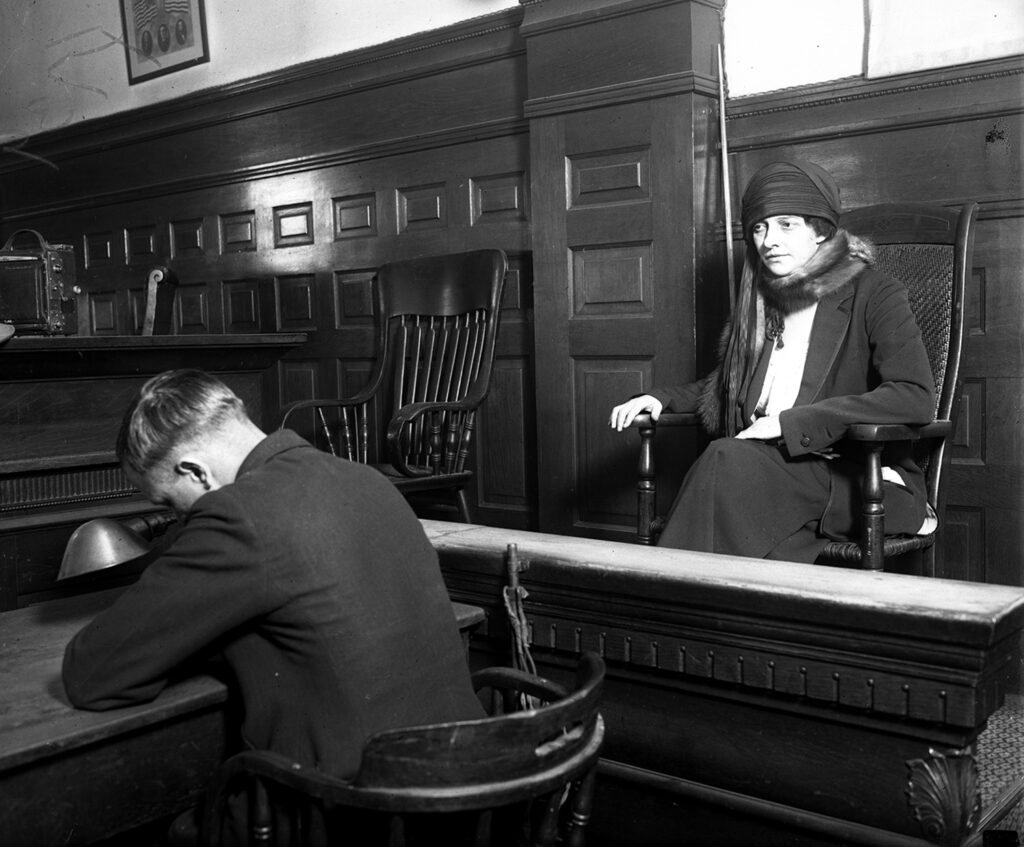
Beulah Annan had been the “pretty” inmate of murderess’ row at the county jail while the slightly older but no less sensational Belva Gaertner had been the “stylish” one, at least according to the Tribune. In the twenty-third week of 1924, Gaertner went on trial, accused of having murdered car salesman Walter Law, who back in March had been discovered shot in the head and slumped over the steering wheel of the woman’s car. The gun used in the death and a bottle of gin lay on the floor. Police discovered Gaertner back at her apartment in an agitated state, her blood-stained clothes strewn across the floor.
The twice-divorced former cabaret performer admitted to having spent a night of “gin and jazz at the Gingham Inn” with the married Law but was “so drunk she [didn’t] remember” how it ended. Elegantly attired, on the “dangerous side of 30,” she exhibited “virtuous calm” as the state made its case against her at trial that week. The defense didn’t bother to make an opening statement, call any witnesses, or make a closing statement, convinced that enough reasonable doubt existed to acquit. After six hours of deliberation and eight ballots, that’s exactly what the jury did.
Upon learning her fate, Gaertner announced she intended to remarry her wealthy ex-husband and sail for Europe. With her and Beulah gone, that left four women on murderess’ row. Two were Black, two were middle-aged, having all been accused of killing their husbands. The Tribune concluded these women “can’t hope for publicity, maybe not even acquittal.”
Gaertner’s story never made the front page. All week it continued to be the Robert Franks case that captured the headlines. On the morning of Saturday, May 31, Nathan Leopod Jr. confessed to having kidnaped and murdered the fourteen-year-old boy. He had been joined in the commission of this crime by fellow Kenwood resident, University of Chicago student, and longtime “chum,” Richard Loeb, who also made a confession.
According to Leopold, the choice of victim for this crime, which they had started to plan back in November, was “left undecided until that day. We decided to take the most likely looking subject that came our way,” who happened to be young Bobby, a distant relative of Loeb. On that early spring evening, they managed to lure him into their rented car with the offer of a ride back to his house, murdering the boy within a block of where they picked him up. They drove the body down to Wolf Lake, waited for the sun to set, and then placed it in the culvert where it was discovered the following morning. They had always intended to murder their victim, with the ransom a ploy, a chance for the two wealthy young men to get some extra spending money for the summer. Convinced they were “too clever to be trapped,” the two had been driven by a “thirst for new emotions” to murder Bobby.
In Leopold’s confession, it was Loeb who had struck and suffocated Bobby. In Loeb’s confession, it was Leopold who’d done these deeds. This disparity in their accounts led to a rupture in their friendship as they were placed in separate cells in the county jail, while their shocked families turned to prominent attorney Clarence Darrow to formulate some kind of defense.
Awaiting the grand jury to convene, Leopold and Loeb settled into jail life. Loeb started taking classes in the school for inmates. Leopold played handball and read to his cellmate. Outside the jail, various experts, including phrenologists, weighed in on the mental state of the two boys and their motive. By week’s end, the grand jury, having heard from seventy-one witnesses, indicted Leopold and Loeb on the charges of murder and kidnaping for ransom. State’s Attorney Robert E. Crowe requested a July start for the trial at which he would seek the death penalty.
Amid so much death, it should come as no surprise that even the national pastime was touched by tragedy. On Friday, during the fifth inning of a game between the New York Yankees and Chicago White Sox, bartender Thomas Lynch, 45, became so agitated that he dropped dead of a heart attack in the stands at Comiskey Park. The inciting incident–New York’s George Herman “Babe” Ruth hitting his fourteenth home run of the season. The Sox went on to lose the game 5 to 3 before 18,000 fans, minus the deceased bartender.
Week Twenty-Four: June 8-June 14, 1924
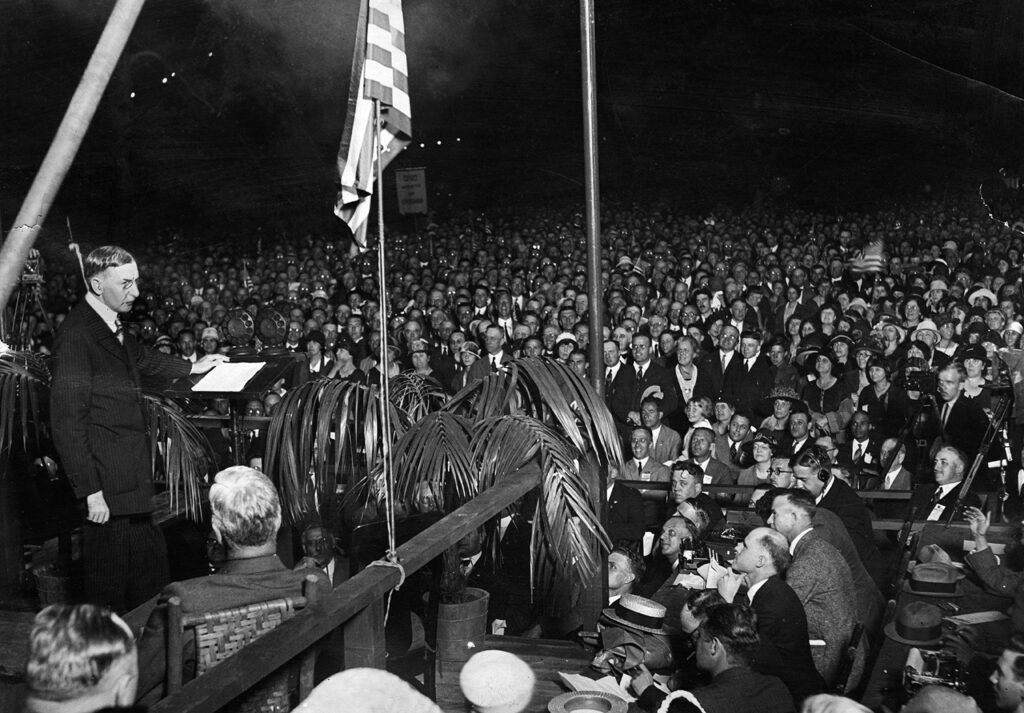
On the Monday of the twenty-fourth week of 1924, readers of the Tribune were greeted with a front page cartoon by John T. McCutcheon in which an enormous elephant head burst through an open spread of a newspaper being read by a surprised and smiling man. Around the elephant’s head were visible partial headlines such as “Millionaire’s Sons … Murder,” “Insanity,” and “Confession … Murder.” Upon the animal’s head sat a fringed cap stamped with the letters “GOP.” The cartoon’s caption: “The Convention Will Be a Cheerful Relief.”
That shift away from the murder of fourteen-year-old Robert Franks by Nathan Leopold and Richard Loeb started with Sunday’s coverage of the laying of the cornerstone the previous day of the planned memorial to 7,000 members of the Benevolent and Protective Order of the Elks who had served in the Great War, 1,200 of whom had lost their lives in the conflict. Thousands attended the ceremony near the corner of Diversey and Lakeview. More than one million members of the fraternal organization from across the country had contributed funds for the construction of the memorial.
Similar pomp marked the opening of the annual American Medical Association’s conference. At the Drake Hotel, Chicago surgeon Max Thorek dismissed the popular trend of grafting animal glands onto elderly men in an attempt to reverse the effects of aging. He had seen, in his own practice, some success in the transplantation of younger human glands into the bodies of the old. At another point in the conference, ethylene-oxygen, the “new gas that sounds like the name of a sleeping car,” was promoted as an anesthetic that “miraculously works,” while the affair concluded with a session on plastic surgery, an area that had advanced significantly through operations on injured veterans of the War. It was giving way to new uses, more “cosmetic surgery,” where a woman could have her “face lifted.”
Perfect specimens of health made up the men and women from Chicago selected that week for the swimming and diving teams headed to the Olympic games. Among those bound for Paris were Johnny Weissmuller and Sybil Bauer. At the final Olympic trials, Bauer had broken her own record for the 100 meter backstroke. Gertrude Ederle of New York had also set a new record in the 150 meter freestyle event.
The eyes of the nation, however, were not on Chicago that week but on Cleveland as members of the Republican party gathered for their national convention. Who would be at the top of the ticket was of little doubt. Calvin Coolidge had ascended to the presidency after the death of Warren Harding in 1923, and he quickly and easily won the nomination. Most of the drama surrounded the selection of the vice presidential candidate. By midweek, the delegates had selected Evanston resident Charles Gates Dawes. The candidate had served in the Great War, had spent the past year working with European nations on the recovery and reparations plan that bore his name, and was known in Chicago for his philanthropy and colorful language.
While Elks, medical professionals, Olympic athletes, and Republicans looked to a bright future, the darkness of the past few weeks hadn’t completely vanished from the pages of the newspaper. The typewriter used by Leopold in the writing of the ransom note sent to the father of Robert Franks–a key piece of evidence–emerged from the depths of the southernmost lagoon in Jackson Park. Salvager Frank Blair received one thousand dollars for the dive that recovered it. The state released transcripts of the full confessions given by the young killers and noted some small and one major discrepancy–who had actually beaten and suffocated Franks–between the two accounts, while the pair entered pleas of “not guilty” at their arraignment. Judge John R. Caverly set the start of the trial for August 4.
Perhaps sensing that attention was directed elsewhere, Alphonse “Al Brown” Capone walked into the Cottage Grove police station and volunteered to be questioned in connection with the killing of small-time hoodlum John Howard in a saloon back in early May. Police had been searching for “Scarface Al,” as he was also known, but Capone claimed he’d been out of town at the time of the killing and had returned to Chicago only that week.
Week Twenty-Five: June 15-June 21, 1924
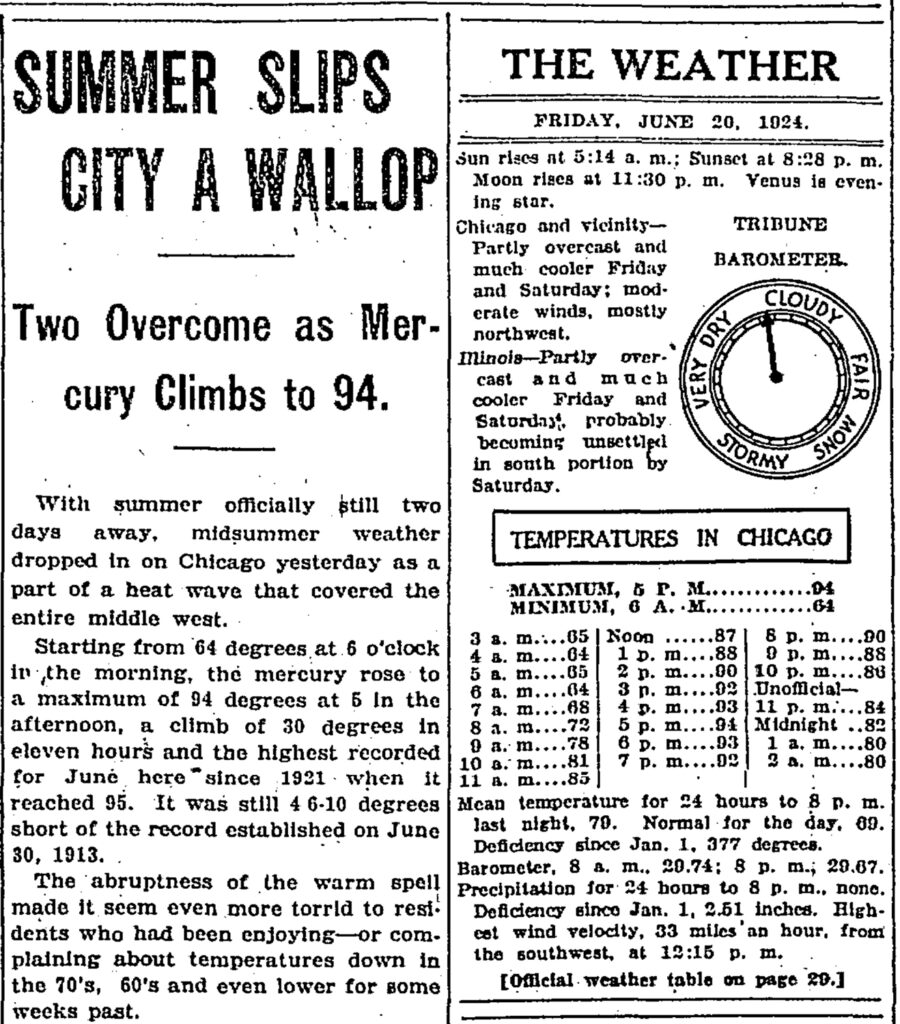
Chicago Police shot nineteen “heat crazed dogs” on the north and northwest sides near the end of the twenty-fifth week of 1924. A few days before the official start of summer, the temperature jumped thirty degrees in eleven hours, settling at 94, the hottest on record for June since 1921. Chicagoans sought relief in the cool waters of Lake Michigan, even though the beaches hadn’t officially opened. At Oak Street Beach, a man in his forties, overcome by the heat, toppled off a park bench and required medical attention.
Also feeling the heat were the eight men who’d stopped and robbed a Chicago, Milwaukee, and St. Paul train outside Rondout, Illinois at the end of the previous week. They’d made off with over $2 million in cash, bonds, and securities from the registered mail car. The disciplined execution of the crime, as well as the use of military equipment, such as gas canisters and masks, led investigators to believe the bandits could be veterans of the Great War. One of the men had been shot by his colleagues at the scene, perhaps for having committed some deviation from the plan.
Tracing what became of him led to an apartment in a three-flat on North Washtenaw Avenue in Chicago where police discovered the wounded man, who gave his name as John Wayne, which was quickly revealed to be an alias. Another one of the gang, arriving and finding police in the apartment, attempted to bribe them with $20,000 of the stolen loot. As it turned out, the two criminals were brothers, and the shooting had been an accident. By week’s end, all eight had been identified, and four were in custody. An elderly tenant farmer led investigators to $100,000 in negotiable securities that had been left, along with several empty mail bags, in a stolen car abandoned in a field near Joliet.
Heat of the political kind bore down on Italian Premier Benito Mussolini that week when it was revealed that members of his cabinet and the Fascist press had played a part in the kidnaping and disappearance of Giacomo Matteoti, the “millionaire Socialist deputy.”A political opponent of the Premier, Matteoti had been on the cusp of exposing corruption involving the government, a failed bank, and the Fiat automotive company, among others. Mussolini stayed mum while his associates were arrested or fled Italy, even as King Victor Emmanuel attempted to form a new cabinet to preserve the government. It was reported but then suppressed that the mutilated corpse of Matteoti had been discovered on the shore of Lake Verde. Many in Rome, it was believed, had “determined that Fascism had run its course” in the country.
Also running its course was the trial of Horace Greer, chauffeur to Hollywood actress Mabel Normand. Greer was being tried on the charge of assault with the intent to murder. On New Year’s Day, he had stormed into a booze-soaked party, where he’d driven Normand, to discover her and the host, fellow actress Edna Purviance, being menaced by a drunk and disorderly Courtland Dines, Denver oil man. To protect the women’s honor, Greer shot Dines but not fatally. The jury of ten women and two men accepted this story and acquitted Greer. He was subsequently arrested before he could leave the courthouse on an unrelated charge of having violated the Wright Act, California’s prohibition law.
Far from the heat of Hollywood or Chicago, the cold slopes of Mount Everest, the tallest mountain in the world, concealed a tragedy beneath the ice and snow. It was believed that about two weeks prior the third expedition to summit Everest had ended with the disappearance of mountaineers George Mallory and A.C. Irvine, as reported by the Royal Geographical Society. Presumed dead, the two men, it was believed, could have succeeded in reaching the top. A year prior while lecturing about the failed 1922 expedition in which he’d also taken part and raising funds for the current one, Mallory had reportedly responded to a question about why he wanted to climb Everest by replying, “Because it’s there.”
Week Twenty-Six: June 22-June 28, 1924
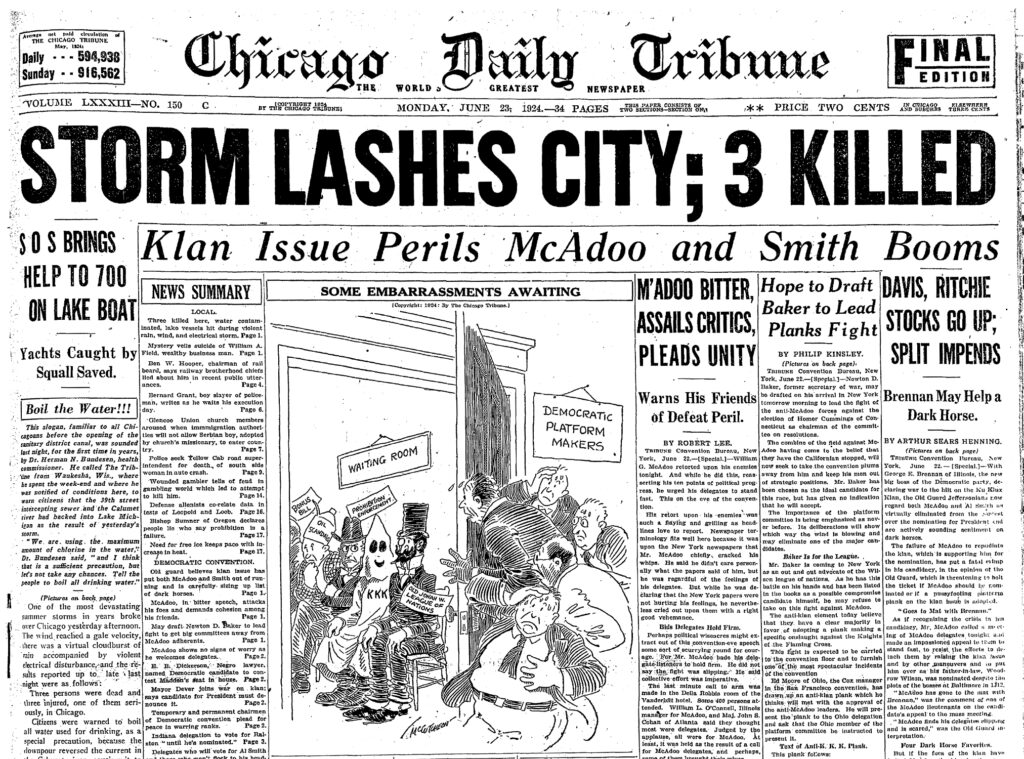
“Boil the water,” commanded health commissioner Herman N. Bundesen after a summer storm on Sunday in the twenty-sixth week of 1924 caused sewage to flow into Lake Michigan. Violent winds and heavy rains drove bathers from the city’s beaches while several yachts and the steamer City of Saugatuck, with 700 onboard, became stranded on the churning waters of the lake. Lighting claimed the lives of three, including a caddy, aged 16, on a golf course in Olympia Fields.
The storm also tore away the tents at a street carnival, leading to the escape of a “wild and maddened” bear, who stalked the streets of the small south suburb Burnham and the nearby Chicago neighborhood of Hegewisch the following day, terrifying residents and driving them indoors. The bravery and ingenuity of Burnham’s “boy mayor,” Johnny Patton, brought an end to the threat, when he used a pot of honey to distract the bear long enough for its trainer to slip a collar and lead around its neck.
The storm in Chicago was sudden and short, but the political storms growing on both coasts threatened to be longer and more damaging. In Los Angeles, three members of the Japanese community were murdered, their deaths believed to be the result of a growing empowerment among bigoted whites after the U.S. Congress passed the recent anti-immigration bill. In New York, Democrats gathered for their national convention, with no clear favorite for the presidential nomination and differences on prohibition, the Ku Klux Klan, and other issues threatening to tear the party apart.
Over in Europe, no stranger to political storms, Italian premier Benito Mussolini, in a speech before parliament, announced his intention to purge the governing Fascist party of its more extreme elements and reestablish democratic norms, while the opposition Socialist party and its friends in labor held a moment of silence for Giacomo Matteoti, whose kidnaping and murder had created this political crisis.
It was also reported this week that Italian Fascists had begun to build relationships with admirers in other European nations, with the intent of spreading their ideology across the continent. Fledgling political groups in Spain and Germany appeared the most receptive.
Back at the University of Chicago, as part of the Norman Walt Harris foundation lecture, Dr. Herbert Kraus, visiting from the University of Koenigsberg, argued that Germany required, according to the Tribune, a “strong leader who will strike at a psychological moment” and remove the “great political hopelessness” plaguing the nation since the end of the Great War.
Not all was storm and stress in the twenty-sixth week of the year. A steamer set off from Benton Harbor bound for Chicago with 55,000 cases of fresh strawberries, the largest shipment ever sent to the city. A ship of considerably greater size, the SS America, arrived in Cherbourg with the 350 athletes set to represent the United States at the Paris Olympics. Cries of “Vive America” erupted from those gathered on the docks, to which Duke Kahanamoku, the “Hawaiian swimming marvel,” responded by playing several songs on his ukulele to the delight of the crowd. Fellow swimmer Johnny Weissmuller told the Tribune’s foreign correspondent to “send his best regards to Chicago, and tell them I feel like breaking a few swimming records.”
Week Twenty-Seven: June 29-July 5, 1924
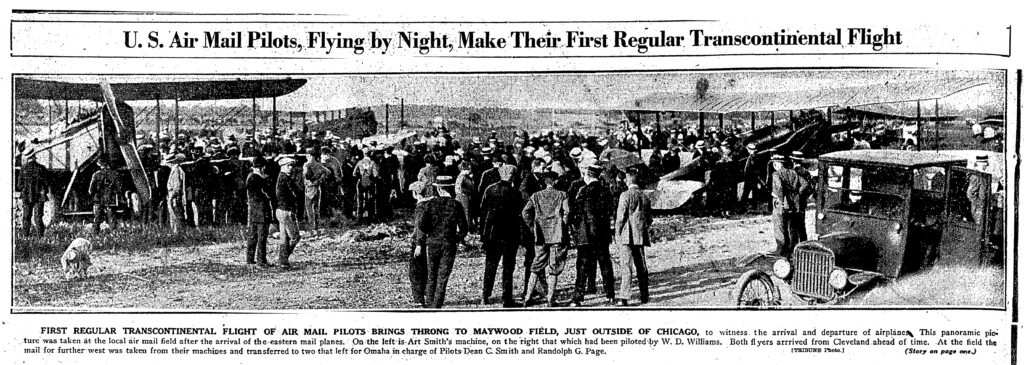
Chicago planned to have a “sane Fourth of July” in the twenty-seventh week of 1924. Various ordinances forbid setting off fireworks without a permit and the selling of “toy pistols, sky rockets, and the giant crackers” within city limits. Nonetheless, “enterprising merchants now jockey for position on every highway leading to Chicago,” offering prohibited incendiaries for sale at a considerable mark up. Fire department officials stressed their intention not to be “kill-joys” but rather to “protect the community from foolhardy Independence Day show-offs.”
Flying above any potential fireworks were the pilots crisscrossing the country as part of the first nighttime airmail service, which launched that week. Hailed as an important advancement in aeronautics and the efficiency of the mails, the night flyers, heading east and west, touched down on an air strip near Maywood, where they were feted by the Chicago postmaster and a small group of local business leaders, including Julius Rosenwald of mail order giant Sears, Roebuck and Company..
Down on the floor of Madison Square Garden, Democrats struggled to stay above the fray and nominate a candidate for President. After fifteen ballots on Monday, no candidate had received the two-thirds needed to secure the nomination. Former Secretary of the Treasury and son-in-law of deceased President Woodrow Wilson, William G. McAdoo maintained a small lead against his chief rival, New York Governor Al Smith. Dividing the two candidates and the party were attitudes toward the Ku Klux Klan. The adopted plank insisted on “obedience to the orderly processes of the law and [condemned] any effort to arouse racial or religious dissension” but had barely passed over one explicitly denouncing the clandestine organization. Worried that balloting would continue indefinitely, party leaders were said to be looking for a “dark horse” candidate.
Chaos within the Democratic Party couldn’t be better timed for Republicans, as it drew attention away from their nominee, President Calvin Coolidge, and the various scandals of the previous Warren G. Harding administration playing out in the courts. Former Secretary of the Interior, Albert Fall, and oil men Harry Sinclair and the two Edward Dohenys, senior and junior, were indicted by a federal grand jury for “conspiring to defraud the government” as part of the Teapot Dome scandal. A different jury convicted former Justice Department agent Gaston Means of violating the Volstead Act in an elaborate plot that involved securing whisky from a government warehouse for use by a New Jersey steel tycoon. A former associate of the disgraced Attorney General Harry Daugherty, Means received a sentence of two years in the federal penitentiary in Atlanta and a fine of $10,000.00.
With political fireworks going off elsewhere, Chicago settled into a “sane Fourth of July” on Friday with picnics, parades, and permitted pyrotechnic displays. No fires and few accidents were reported. Nineteen-year-old Charles Kruger was fatally shot in the abdomen by his close friend August Tamburino, while the two were playing with a mail order pistol belonging to the latter’s father. A sixteen-year-old-boy shot himself through the hand and an eight-year-old girl received burns from firecrackers carelessly tossed into a nearby bonfire. Having reported on these accidents at length, the Tribune concluded, “The rest of the city enjoyed itself.”
The 148th birthday of the United States coincided, coincidentally, with the 52nd birthday of President Calvin Coolidge. In Washington, festivities marking both were muted, as sixteen-year-old Calvin Coolidge Jr. battled for his life against “septic poisoning,” which had developed from an untreated blister on his foot and spread throughout his body. Walking in the White House grounds, a despondent President Coolidge came across a small rabbit which he coaxed into his arms and then delivered to the sick room for the comfort of his youngest son.
Week Twenty-Eight: July 6-July 12, 1924
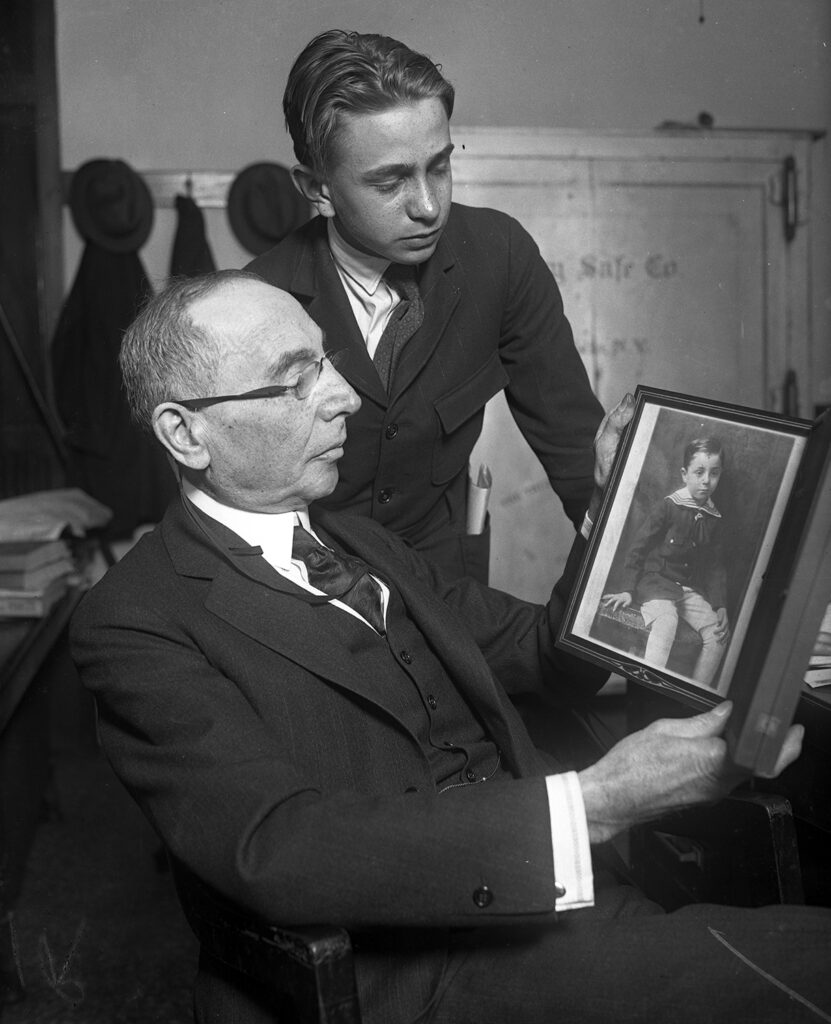
The release of three thousand fluttering homing pigeons and a barrage of artillery fire capped the opening ceremonies of the Paris Olympics in the twenty-eighth week of 1924. Before that stirring moment of sight and sound, athletes representing forty-five nations paraded through Colombes Stadium, pausing before the box where French President Gaston Doumergue and the Prince of Wales awaited them, while thirty thousand spectators cheered them on. Athletes from the United States–the women all in white, the men in dark blue jackets and straw boaters–fielded the largest team. Among the formerly warring nations, only Germany did not participate.
Back in the United States, with considerably less fanfare, the Democratic Party selected its nominees for President and Vice President after three weeks and 103 ballots. Former congressman and Ambassador to the United Kingdom, John W. Davis was selected for President, with the Governor of Nebraska, Charles W. Bryan, as his running mate. As the convention at Madison Square Garden wound down to the strains of “Auld Lang Syne,” New York Governor Al Smith, who had been among the leading candidates early in the balloting, stressed that the prolonged, fractious convention hadn’t damaged the party but rather had served as an illustration to the American people of democracy at work. The Tribune felt otherwise. Given the various scandals attached to the late Warren G. Harding’s administration, Democrats were favored to win in November, but divisions on display at the convention of a party “half southern klan, half northern Catholic” prevented the quick coalescing around a candidate and led to the selection of the dark horse Davis. An attorney who’d represented capitalist J.P. Morgan in the past, the Democratic candidate was “a man as conservative as President Coolidge.” The choice of Davis led the old Progressive and former candidate William Jennings Bryan, Charles’s brother, to lament that the campaign was lost before it had begun.
Near the end of the convention, the head of the New York delegation Franklin D. Roosevelt had invited Rabbi Stephen Wise to the podium to offer a resolution that came in the form of a prayer. It was made in memory of Calvin Coolidge Jr. The sixteen-year-old son of the President had died of septic poisoning after several days of struggle. The President and the First Lady were at his side when he died at Walter Reed Hospital. The infection had developed from a blister on his foot, the result of a tennis match against his brother John. Back at the White House, John awaited word from the hospital, but as Calvin’s condition worsened, no one thought to alert his older brother. He would learn of the death after the fact and, like his father, receive the news stoically. President Coolidge returned to work the following day. Apart from a slight redness around the eyes, aides noticed no change in his demeanor.
Another grieving father returned to court in Chicago to see three young men brought up on charges for having threatened to kidnap and murder his only daughter if a ransom wasn’t paid. Jacob Franks had already lost his youngest child, Bobby, in such a fashion back in May. The three young men, all in their teens, were arrested when they went to pick up the ransom at an agreed upon location near the corner of Division and Elston. They claimed it was all a prank, and they didn’t intend to harm Josephine Franks. At the Cook County jail, the confessed killers of Bobby Franks, Nathan Leopold Jr. and Richard Loeb, continued to be examined by a battery of alienists as the date of their trial neared.
While the motivations and sanity of Leopold and Loeb continued to be debated, the reasons behind an equally tragic crime were easier to discern. Sixty-eight-year-old Charles N. Wilcoxen had used an “axe, potato masher, and razor as the instruments of death” in murdering his wife, two years his senior, in their mansion near Michigan City, Indiana. He then hung himself in their bedroom. The former head of the Chicago, Lake Shore, and South Bend Electric Railway, Wilcoxen was believed to be suffering from “senile dementia” and was distraught over having been forced into retirement the previous February.
The week ended on even grimmer news out of Hanover, Germany. Authorities had discovered butcher Fritz Haarman in the process of dismembering a body in his place of business. He admitted to having murdered thirteen other young men, although police believed the number to be higher. Residents of Hanover expressed outrage at the reluctance of the police to investigate the disappearance of the murdered men up until this point. The press called Haarman a “vampire,” due to his habit of drinking the blood of his victims directly from wounds in their necks. His murders were deemed the “worst in the history of German crime.”
Week Twenty-Nine: July 13-July 19, 1924
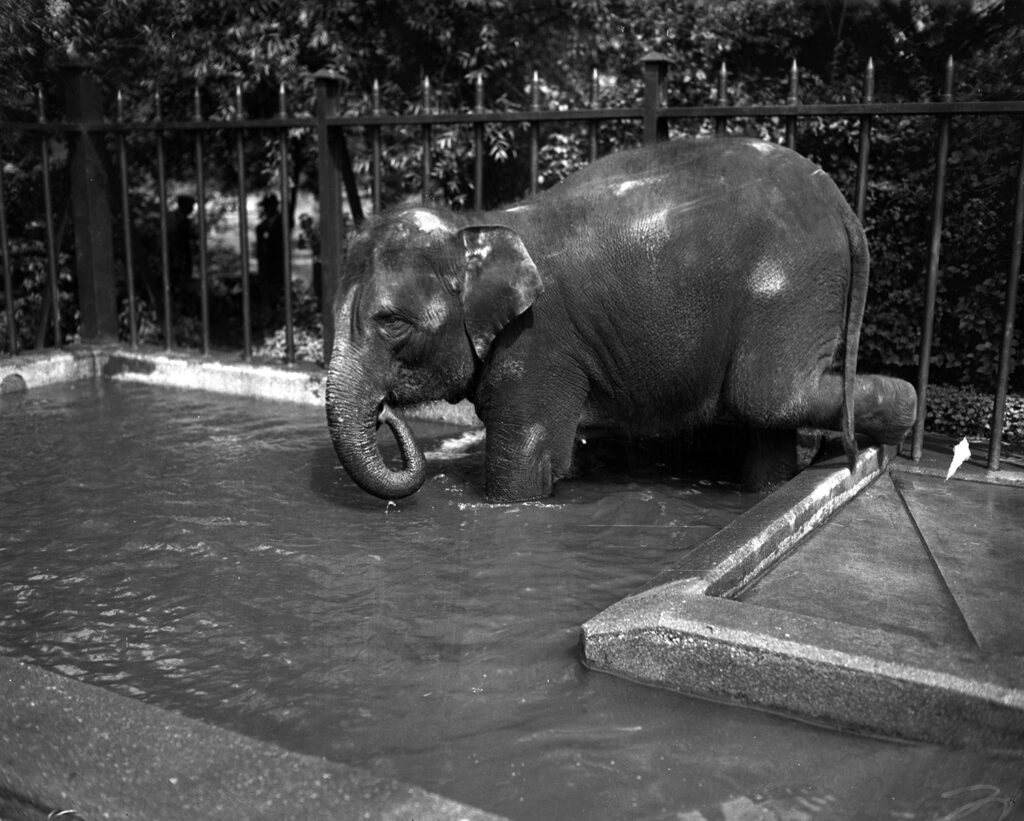
Deed-a-Day was the winning entry in the contest to name the baby elephant at the Lincoln Park Zoo, and courtesy became part of the code of conduct for Chicago Police during the twenty-ninth week of 1924. Responding to reports out of New York of the excessive politeness of its officers during the recent Democratic National Convention, Chief Morgan Collins determined that his men needed a reminder, one backed by an official order. “Members of the department must be courteous and polite to the citizens with whom they, in their official capacity, come in contact,” he wrote.
Two officers at the Hyde Park station quickly tested the enforcement of the new policy when they roughed up a Chicago Tribune photographer, who as part of the paper’s ongoing automotive safety campaign had the temerity to suggest they arrest an obvious speeder. Mayor Dever himself promptly suspended the two offenders against civility. For its part, the Tribune responded by sending two of its reporters, one female and one male, undercover to badger eight randomly selected police officers with inane questions to see if their patience and politeness would crack. All eight behaved admirably, and two of them even provided the incognito journalists with streetcar fare.
One officer who might have seen through the Tribune’s deception was James “Zip”Larkin had he not passed away that week. A thirty-three veteran of the force, he was known as the “man who never forgets.” Throughout his career, Larkin was often called upon to confirm the identification of various offenders since his memory proved to be as accurate as a photograph. In 1912, he correctly identified confidence man Louis Johnson, after the latter had been picked up at the Northwestern railway terminal. Larkin had last encountered Johnson in 1893 when the officer pinched the swindler at the World’s Fair.
Two alleged killers who didn’t require identification, given all the publicity surrounding their case, were Nathan Leopold Jr. and Richard Loeb. With the opening of the trial of the two for the kidnaping and murder of fourteen-year-old Bobby Franks fast approaching, the Tribune put a question directly to its readers on the front page, should the proceedings be broadcast over the newspaper’s radio station WGN? Capacity in the courtroom was limited, and public interest was high; the radio offered a chance to address both. The Tribune insisted the proposal was not a circulation “stunt” but rather “an experiment by a journal which occupies the position of being the World’s Greatest Newspaper.” Accompanying the article was a simple ballot that readers could cut out, complete, and mail to the paper.
Within a day it had received over 800 responses, with a slight majority voting “No” to the broadcast. The Tribune sent out its Inquiring Reporter to get additional insight by asking Chicagoans the question directly. By combination of the ballot, the direct questions, and calls to the radio station, within two days the responses topped 4,000, with the “No”s still leading. While perhaps surprised by the position of the majority, the paper wasn’t surprised by the swiftness of the response to the question. The Franks case “is a tragedy that has made America look questioningly at wealth, precocity, and higher learning.”
One of the inventors responsible for making such a radio broadcast possible, Dr. Lee De Forest, was in Chicago that week at McVicker’s theater to demonstrate his new innovation, the Phonofilm, which promised to make the images projected on the silver screen silent no more. “Two pictures are made simultaneously, a picture of the subject and a picture of the sound waves, both on the same film,”the Tribune reported. “When projected, waves not only throw the pictures on the screen, but convert the sound pictures into the sounds themselves, through an amplifier, to the audience.”
A place where amplification wasn’t required was Belmont Harbor on Saturday when cheering crowds saw off the twenty-nine vessels participating in the nineteenth race to Mackinac Island, the “longest fresh water race in the world.” The assortment of sloops, schooners, and yawls made up the “largest fleet” to participate in the over 300-mile race, which would take them from the coast of Chicago to the Round Island lighthouse “under the shadow of Fort Mackinac.”
Week Thirty: July 20-July 26, 1924
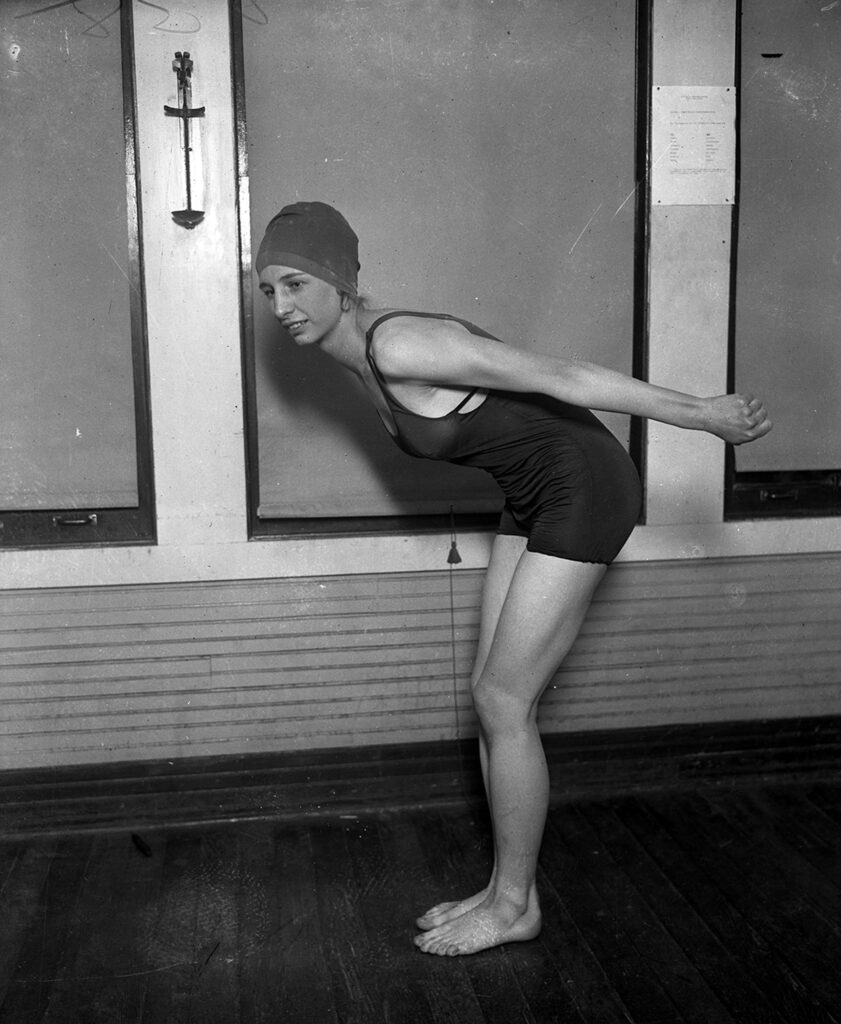
Calvin Coolidge’s cat did not come back in the thirtieth week of 1924. For the second time it wandered off the White House grounds. Previously, a radio broadcast had gone out, and Tige was found and given a collar to make future identification easier. This time the President decided not to search, having concluded that Tige “had plainly indicated his preference for society other than those found around the White House.”
Whatever mysterious forces drew Tige from his home was perhaps as strong as those being studied by University of Chicago physicist Albert A. Michelson. From the heights of the Mount Wilson Observatory in California, the Nobel Laureate engaged in an experiment whose goal, according to a forthcoming issue of the University of Chicago Record, was “to ascertain whether a beam of light traveling in a closed circuit on the earth’s surface experiences a draft on account of the earth’s rotation.” To this end, he had created an “apparatus for the rapid measurement of the earth’s gravitation” with the intent to test and refine Einstein’s theory of relativity.
On a tramcar in Berlin, the conductor mocked a passenger who’d attempted to calculate in his head the change he should receive back with the ticket for his fare. The passenger was, in fact, wrong in his figures, which caused some smiles among the fellow passengers who recognized him as none other than Albert Einstein.
Lost in this moment of levity was an approaching darkness. In Bavaria, the Ludendorff-Hitler party put forth a bill to the local diet intended as a test prior to introducing a similar one in the Reichstag. The bill called for the “exiling of Jews from Germany,” and, according to the Tribune, included several other provisions: the “proposed law provides that Jews must not change their names and must not hold public office. The number of Jews in schools and universities must be limited to a small percentage, and neither Jews nor other foreigners must hold land in Bavaria. Finally, it provides that Jews must wear special costumes with emblems showing their religion.”
In Paris at an Olympic Games in which Germany did not participate, the American swim team far outmatched any of its competitors. Chicago swimmers excelled, with Johnny Weismuller setting a new world record for the 100-meter freestyle and Sybil Bauer also making a new mark in the 100-meter backstroke.
Back in Chicago, residents were celebrating another sporting achievement. By just about an hour, the sloop Sarl, the “smallest yacht ever to enter the Mackinac race,” beat out the largest fleet ever assembled, despite some stormy weather.
Mixed in with the locals learning this news were over 500 delegates to the seventh annual convention of American Beauty Store Owners. On their first day in the city, many agreed to gather in a Loop restaurant where they would easily recognize one another, having all donned “hats at least ten years old,” from a time before the Great War.
One romantic touch of the city’s present, the “shining brass sliding pole” in Chicago firehouses, became relegated to the past when it was announced that the new one-story station being built at 35th Street and Lowe Avenue would not have one, the result of the switch from horse-drawn to motorized fire engines. Also soon to meet his end, according to the Tribune was “J.J. Walker,” with the erection of the “first automatic traffic signal designed for pedestrians as well as the auto” at the corner of Washington Boulevard and Ashland Avenue, thanks to the efforts of the West Park Board.
Minor traffic violations got barely any notice though as the Franks trial commenced that week at the Cook County Courthouse with a twist no one had anticipated. With the majority of respondents to the Tribune’s poll voting against the broadcast of the proceedings on WGN, the capital case against Nathan Leopold Jr. and Richard Loeb for the kidnaping and murder of fourteen-year-old Bobby Franks began with defense attorney Clarence Darrow saying clearly and succinctly, “We have determined to withdraw our pleas of not guilty and enter a plea of guilty.” After a pregnant pause it dawned on all those gathered that the fate of the two affluent teenage slayers now rested not with a jury but with Judge John R. Caverly.
Week Thirty-One: July 27-August 2, 1924
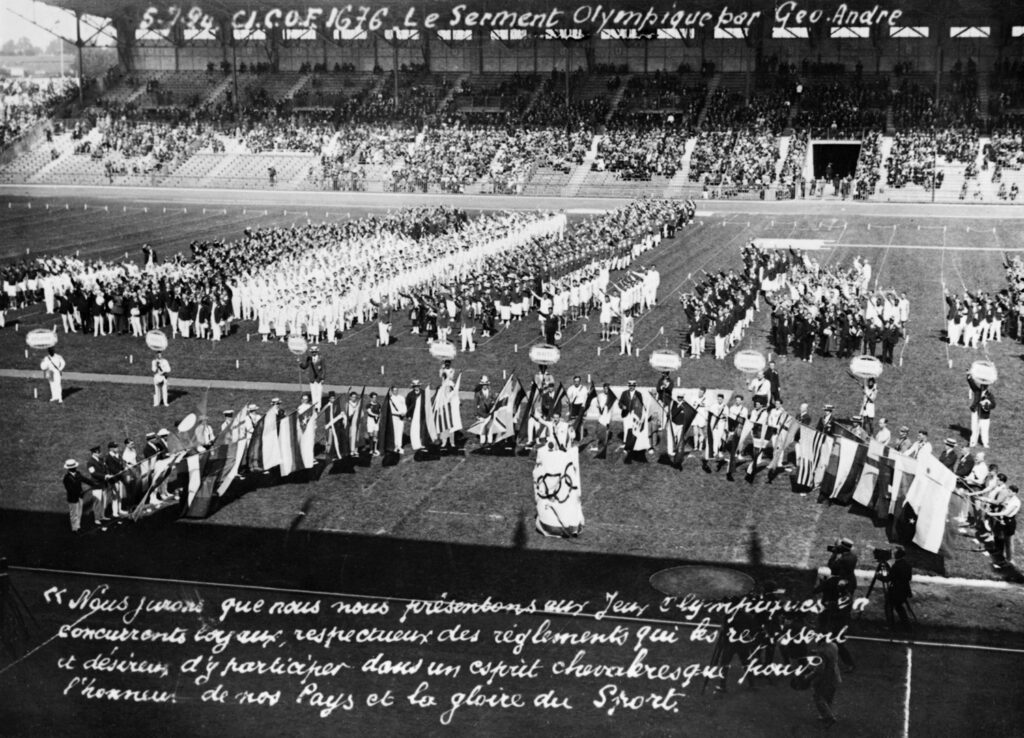
The “first ideal Sunday for swimmers” kicked off the thirty-first week of 1924. With temperatures in the mid-80s, and the waters of Lake Michigan a comfortable 64 degrees, an estimated 200,000 spent the day relaxing on the city’s beaches. The drowning of two young boys, both aged eight, formed the only darkness in what was a bright day.
That feeling of summer calm and comfort extended to the incarcerated at the Cook County Jail. “Cool breezes swept through the tier of cells,” wrote the Tribune, “and sunshine oozed its way to the concrete floors.” The jail’s two most infamous inmates, Nathan Leopold Jr. and Richard Loeb, enjoyed a leisurely day of reading, attending a musical entertainment, and savoring a chicken dinner sent by their families. In remarks to a reporter, Leopold defended the boredom that appeared on both their faces over the previous week’s court proceedings. “It is only natural that when we hear witnesses spend fifteen minutes and more telling stories about finding a letter in a railway coach of something of the sort that we could not be exceedingly interested. We put it there and know all about it.”
The most drama in the courthouse the previous week came not from witness testimony related to the kidnaping and murder of Bobby Franks, all well-documented in the city’s papers, but from the sudden malfunctioning of two of the building’s elevators. A passenger on one of them was Judge John R. Caverly who after dropping several feet unexpectedly used his authority to pressure City Hall to prioritize repairs. “This morning’s pair of near catastrophes is only one more proof of the positive danger of using the present building as a court building,” said the judge, attributing the recent overcrowding to the public’s interest in the case.
Perhaps the city could have called in respected electrical engineer Frederick T. O. Wood if he weren’t being considered to assume the rule of Albania. When oil man Harry Sinclair turned down the offer of the crown, a letter putting Wood forth as a candidate to assume control of the kingdom was received by an Albanian diplomat. Interviewed in the fourth floor apartment above a bakery on Wells Street where he lived with his “seven fine, long-haired cats,” the out of work Wood expressed surprise and incredulity that anyone believed he could become the king of Albania. But, as the reporter noted, Wood did seem to know a lot about the small Balkan nation.
In Paris, Albania was not among the nations participating in the conclusion of the Olympic Games. At the sparsely attended ceremony, France stepped in for nations whose athletes had already departed. The United States team was well-represented, with Lemuel Clarence “Bud” Houser, the shot put and discus medalist from the University of Southern California, holding high the Stars & Stripes in the final procession. The Americans would head back the following day on the steamer America, having won 98 of the 361 medals awarded, 45 of them being gold.
Recovering from their own athletic exploits were two American writers based in Paris who’d traveled to Pamplona to participate in the annual running of the bulls in the Spanish city. Not content to merely run, the two got into the ring with a bull that tossed Donald Ogden Stewart into the air before goring him. His friend, Ernest Hemingway, rushing to Stewart’s aid, got gored for his efforts as well. Fortunately, the bull’s horns had been bandaged at the time, and both men were extended to recover and return to Paris with their two more sensible friends Robert McAlmon and Chicago native John Dos Passos. The Tribune noted that young Hemingway, a “short story writer and foreign correspondent for the Toronto Star,” was the son of an Oak Park doctor and had achieved distinction and sustained wounds while serving in Italy during the Great War.
Week Thirty-Two: August 3-August 9, 1924
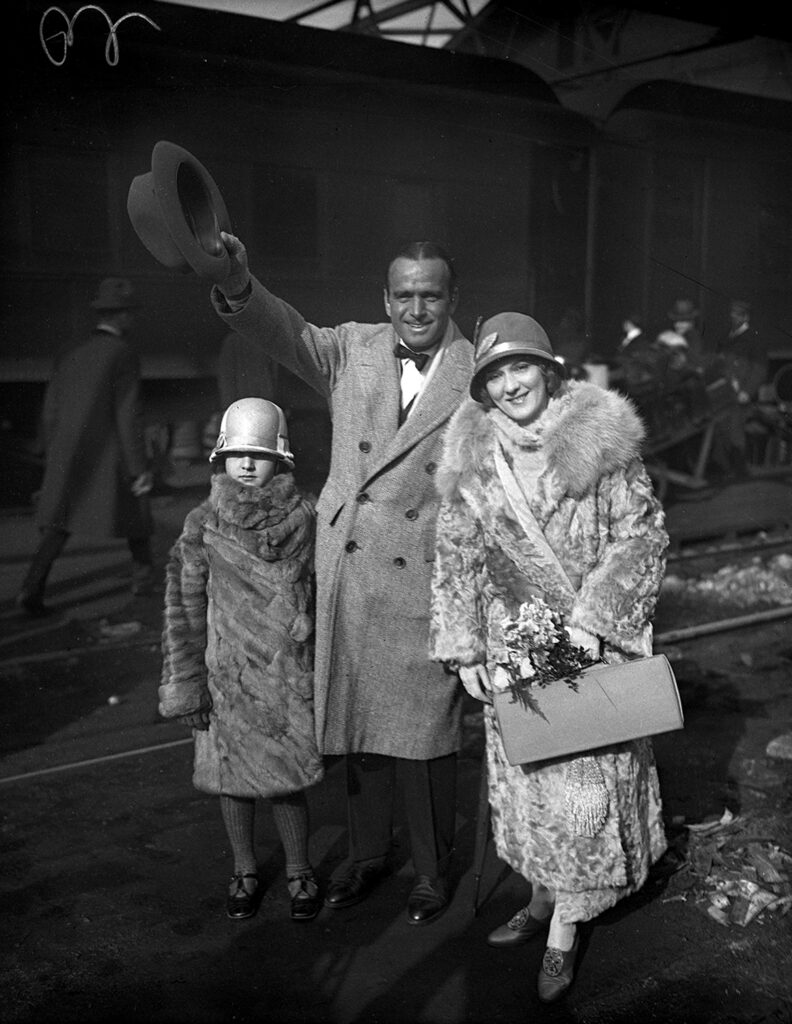
Hollywood came to Chicago in the thirty-second week of 1924. Married stars Mary Pickford and Douglas Fairbanks arrived first, enroute to Los Angeles after a trip to Europe, which included attending the opening of the Paris Olympic games. From a suite overlooking Grant Park, Fairbanks spied a “small army of men lying and lounging on the grass in the shade of the Blackstone hotel.” Inquiring as to who they were, he learned from a friend that they were part of the legion of bums, hobos, and tramps that crowded Chicago each summer. He reasoned they must be hungry, so he reached a deal with a restaurant at 7th Street and Wabash and, with Pickford at his side, “fed some 300-odd hobos and bums, and said they found it good.”
The next day the two celebrities could have joined a very different crowd collecting on State Street, between Washington and Randolph, waiting for the new show to start at the Roosevelt Theater. Based on the number of people in line, the whole “town turned out to welcome back to the silversheet, after an absence of two years, his matinee-idol majesty Mr. Rudolph Valentino.” Valentino starred as the title character in Monsieur Beaucaire, which told a story of romance and adventure set in France during the reign of Louis XV. “The perfect lover in the perfect picture,” gushed the Tribune’s film critic, “THAT is Rudolph Valentino.”
Seeing Valentino larger than life on the “silversheet” was one thing, but the experience of seeing a star up close, like the transients who’d been fed by Fairbanks and Pickford, was difficult to top. Thousands of Chicagoans had that experience when child star Jackie Coogan came to town on a whirlwind tour lasting all of twelve hours. Within that half day, wearing a sailor suit and perched upon the shoulder of a policeman, he greeted adoring fans at Garfield and Washington parks; hosted a select group of children at a banquet at the Sherman House; and mingled with the cast of No, No Nanette and other plays at the Marigold Gardens.
But the day began with Coogan sitting in Mayor Dever’s chair on the fifth floor of City Hall. “For ten minutes,” the Tribune exclaimed, “Jackie Coogan was mayor of Chicago!” Banging a gavel on Dever’s desk, the actor called on those assembled to open up their hearts and dig deep into their pockets to donate to the Children’s Crusade of Mercy, the impetus behind this entire visit. Coogan had dedicated himself to raising funds to support “starving orphans in the near east.” After collecting what he could, he continued on his journey of charity–the next stop, Indianapolis.
After celebrity departed, infamy remained. The trial of Nathan Leopold Jr. and Richard Loeb for the kidnaping and murder of Bobby Franks continued to dominate the headlines. The Tribune’s Inquiring Reporter asked five Chicagoans outside the courthouse, “Do you think the Franks case should be given as much publicity as it is getting?” Four of the five felt too much attention had been given to the affair. Respondent O.C. Tennant remarked that he’d rather see the “same space devoted to sports, politics, or general news.”
Buried in the news that week was a short piece concerning another infamous criminal. Charles Ponzi “whose get-rich-quick operations cost those who invested with him several millions of dollars” was released from the federal prison in Plymouth County, Massachusetts, after serving three and a half years. State authorities quickly apprehended him, intending to put him on trial for larceny.
Week Thirty-Three: August 10-August 16, 1924
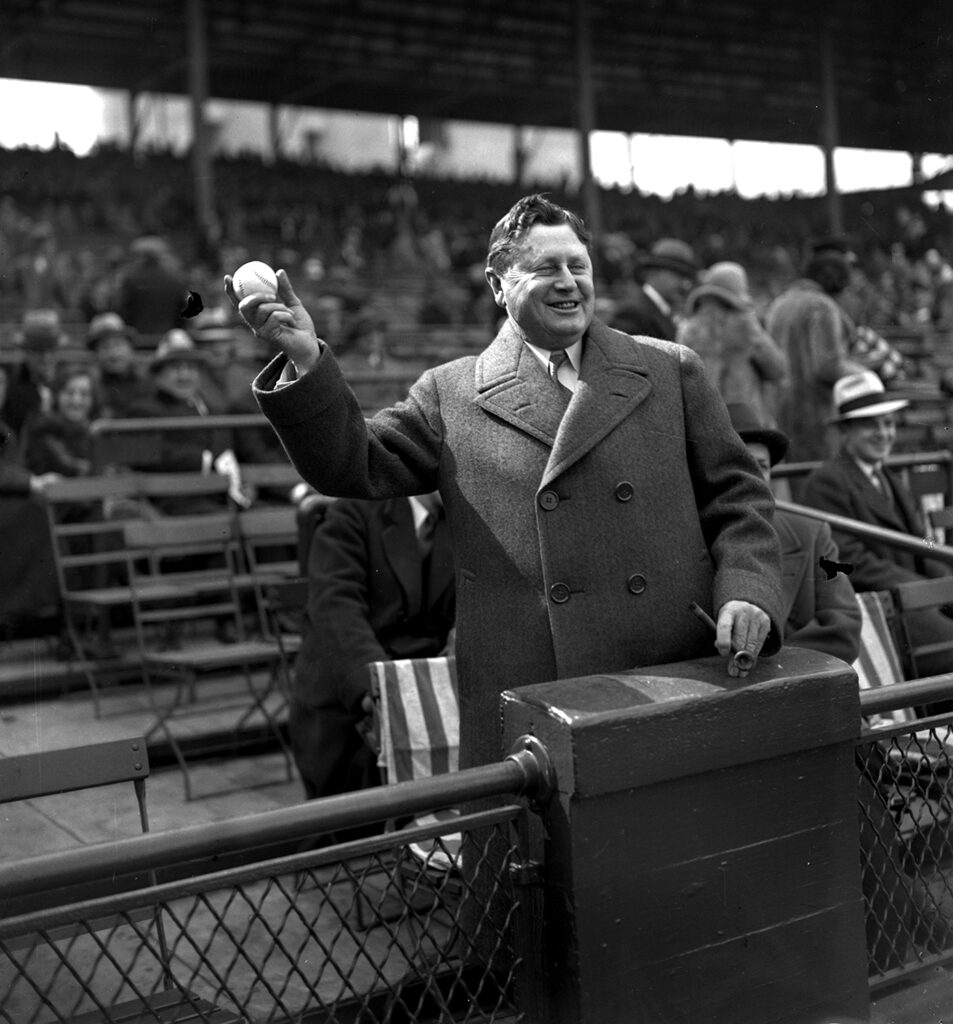
Week thirty-three saw the circus come to town. On Friday, the Ringling Brothers and Barnum & Bailey Circus arrived, fresh from some shows in Milwaukee, and pitched its tents in Grant Park. Along with the assorted acrobats and equestrians, there were “five herds of elephants, 100 clowns, and 1,000 assorted lions, tigers, leopards, polar bears and allied quadrupeds.” A welcoming parade had to be abandoned because of the amount of traffic on Chicago’s streets, the circus claimed, but the promise of twenty performances of the “Greatest Show on Earth,” as well as an endless supply of peanuts, pink lemonade, and hot dogs, were sure to keep the city’s residents, young and old, content.
Chief among the attractions was John Daniel II, the “only gorilla in captivity,” who traveled to Chicago in his own private train car, accompanied, as always, by Alyce Cunningham, who’d been present when he was captured in the Congo. The three-year-old simian derived his name from John Day I, who’d been the only gorilla in captivity prior to his passing in 1922. The Field Museum’s Carl E. Akeley called Daniel II the “living thing that is nearer to man than anything else.”
If not bearded ladies, then ones with five o’clock shadow were seen on Scott Street in the Gold Coast. Detectives Foote and Mulcahy from the Hudson Avenue police station had gone undercover in “bobbed wigs, handsome gowns and hats” to snare an individual who’d been terrorizing neighborhood women by casually dropping a corrosive powder on their dresses that ate through the fabric and irritated the skin. Police believed this person could be the one responsible for the more serious acid attack on Alice Lindberg, 18, earlier in the week.
While the circus was the chief entertainment that week, the city’s two ball clubs continued to play, with the Cubs currently third in the National League and the White Sox struggling in sixth place in the American League. Cubs owner William Wrigley Jr. decided to break the lease on the park where they played, which had 88 years remaining on it, by purchasing the place himself. Considered one of the most valuable pieces of real estate “uptown,” the park went to Wrigley for $295,000.
Week Thirty-Four: August 17-August 23, 1924
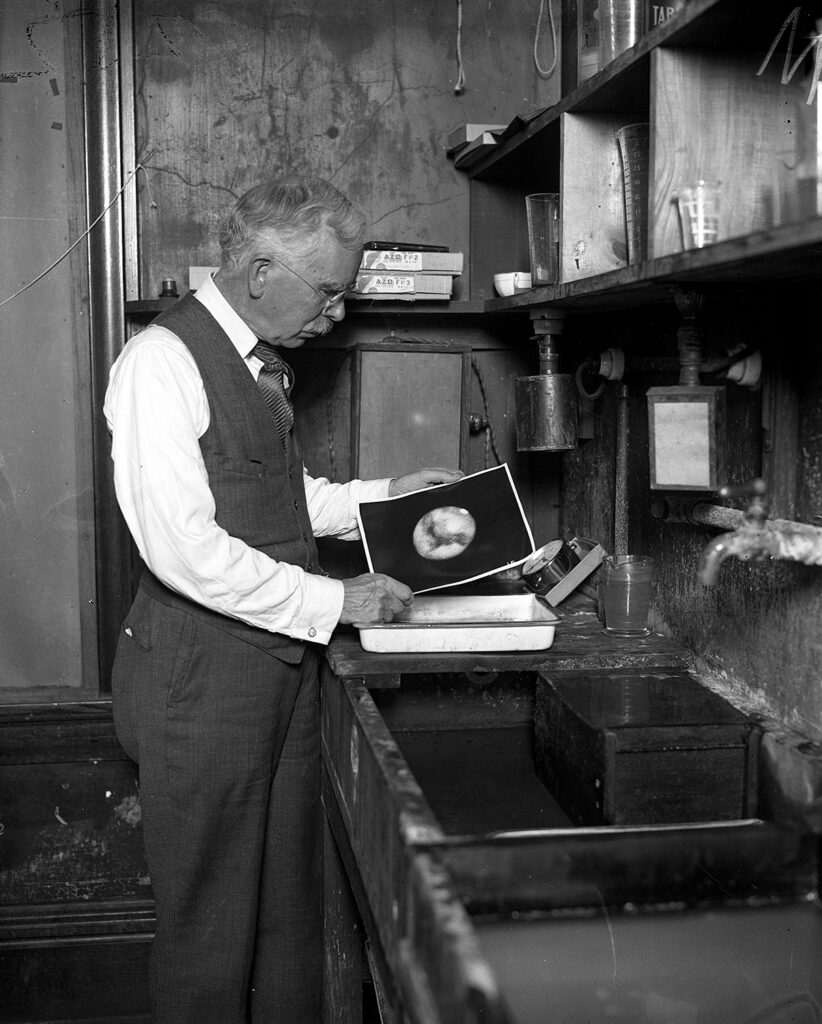
Is there life on Mars was the question being asked at the Point Grey Marine Station in Victoria, British Columbia, when it picked up a “few low notes” followed by a “zipp” in the thirty-fourth week of 1924. A similar signal of mysterious origin had been picked up in Newark, New Jersey. That both may have been broadcast from Mars was believed because the planet was “sneaking right up alongside our earth,” according to the Tribune. Coming within 34.5 million miles, Mars was the closest it would be to Earth until 2007.
Astronomers at Northwestern University’s Dearborn Observatory and the University of Chicago’s Yerkes Observatory busied themselves with the important work of determining the existence of a possible third moon and the level of “moisture content” in Mars’s atmosphere. All dismissed speculation about the unearthly origins of the mysterious radio signals. If Martians did exist, the scientists maintained, they’d probably have better things to do than broadcast nonsense to the Earth.
While many eyes were trained on the fourth planet named for a god of war, those of Europe’s leaders were reading the fine print of the various protocols contained within the Dawes Plan at No. 10 Downing Street in London, England. Regarded by Colonel James A. Logan Jr., “America’s observer with the reparations committee,” as the “first real peace treaty since the war,” the plan developed over several months of negotiations, led by Charles Gates Dawes, now the Republican candidate for vice president, settled matters around payment of war debts and French occupation of the Ruhr Valley. Enactment of the plan, it was believed, would set Europe on a path toward peace and prosperity.
Not sharing that opinion was one of the “three old summer gypsies of the summer trails” who’d interrupted their road trip to Montreal to visit with President Calvin Coolidge, then vacationing in Plymouth, Vermont. The “summer gypsies” were automaker Henry Ford, tire tycoon Harvey Firestone, and the “Wizard of Menlo Park” himself, inventor Thomas Edison. During a tour of a local cheese factory, a journalist quizzed the trio about current affairs. The eighty-year-old Edison mostly played deaf, but, when asked about the Dawes Plan, Firestone maintained it was good for business and, furthermore, predicted the “greatest period of prosperity in the history of the country if Coolidge is elected.” Ford agreed with the part about Coolidge but put no stock behind the reparations plan, saying it would have no impact on business or peace in Europe.
Ford would know given that his circulation of the forged document, the “Protocols of the Elders of Zion,” had been leading to acts of violence against Jews and referenced by authoritarians in Europe for most of the year. A reminder of that violence was discovered by a hunting dog, belonging to a vacationing policeman, in a remote wooded area about 18 miles outside Rome. The dog dug up a skeleton believed to be that of Italian socialist Giacomo Matteoti. Back in June, after revealing he’d planned to expose corruption, Matteoti had been kidnaped and presumed murdered by members of the Fascist government of Benito Mussolini. After weeks of turmoil in which it looked like the Fascists would falter, Mussolini regained control through a purge of his party. Dental work confirmed for most that the skeleton was indeed Matteoti’s. Many of the bones had been scattered by wild animals.
In Chicago, a more careful arrangement, a “human head, a pair of withered arms, and a single discolored leg–placed in the form of the piratical skull-and-crossbones symbol–were found opposite Richard Loeb’s home” in the Kenwood neighborhood. Wedged between the arms was an envelope addressed to “Chicago, City of Crime,” and, within, a single page upon which was scrawled a single line, “If the court don’t hang them, we will,” signed “K.K.K.” The bones and note rested upon the front steps of a mansion belonging to businessman Frank Harris, despite being directed toward Loeb, one of two young men on trial for their life for having kidnaped and murdered fourteen-year-old Bobby Franks.
Loeb himself would be brought to tears as his defense attorney Clarence Darrow began to deliver his closing remarks at the Cook County Courthouse on Friday of that week. Darrow’s main point was simple: “I hope we can get rid of hanging for the good of the human race.”It would take Darrow many, many hours to put before Judge John R. Caverly the evidence in support of this point.
While Darrow laid out what he believed were the causes, mostly cultural and societal, that had led Loeb and his friend Nathan Leopold Jr. to commit this horrible crime, he did not include among them “coffin nails.” That’s what reformer Lucy Paige Gaston had called cigarettes throughout a decades-long crusade in which she’d succeeded in getting the state of Illinois to ban their sale to minors and managed to get herself deputized in Chicago to ensure the law was enforced. The longtime leader of the National Anti-Cigarette League passed away quietly at the Hinsdale Sanitarium as the week neared its end. The cause of death was listed as cancer of the throat.
Week Thirty-Five: August 24-August 30, 1924
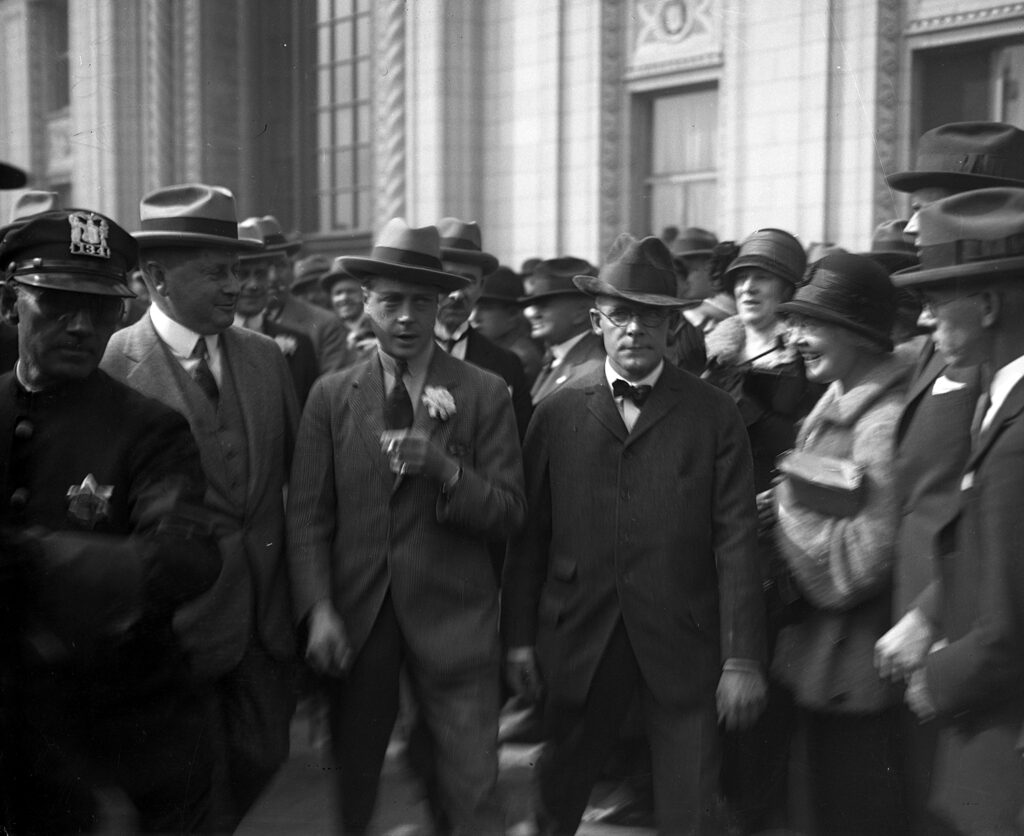
Over 2,500 people fell into a deep sleep in Japan, it was reported, in the thirty-fifth week of 1924. How to control the spread of this “sleeping sickness” stymied local physicians and bacteriologists, who believed it was a form of spinal meningitis. Over 900 of those who developed the condition, mostly elderly, never woke up.
What they dreamt no one can say. In the United States, the dreams of the thousands of Black Americans leaving Alabama, Mississippi, and other Southern states for Chicago were easier to discern. They sought better economic opportunities and less oppressive living conditions but were often met with “forcible segregation,” according to the 1921 report that had followed the racial violence of the summer of 1919. That report was referenced in an article in the Tribune, in which it was noted that Black Chicagoans were often “charged more than a white, even in districts of greatest squalor,” for a place to live.
The article on housing followed one from the day before that estimated the 1924 population of Black Chicago at 150,000 and estimated that another 100,000 would move to the city by 1930. Jobs in a range of industries, but primarily in the steel mills and stockyards, attracted both men and women. The new restrictive immigration law, it was believed, had led to more jobs in the city than people who could fill them.
Clarence Darrow’s dream that week was global in its scope–nothing less than atoning for the societal devastation brought on by the Great War. For three days, he had argued before Judge John R. Caverly that the young lives of wealthy University of Chicago students Nathan Leopold Jr. and Richard Loeb–who’d pled guilty to the kidnaping and murder of fourteen-year-old Bobby Franks–should be spared. Caverly’s decision of whether or not to send the two to the gallows was nothing short of showing “mercy to civilization.”
Decidedly more pleasant were the dreams of many unattached young women when on Friday, one of the world’s most eligible bachelors, Edward Albert Christian George Andrew Patrick David Windsor, the Prince of Wales, arrived in New York harbor at 2pm on Friday, having sailed to the United States aboard the RMS Berengaria. The trip, he told the reporters who’d swarmed him soon after his arrival, was purely for pleasure: he intended to attend the “international polo matches” being held on Long Island. When asked by one reporter “if he would marry an American girl,” the Prince “laughed heartily” and proclaimed that he “didn’t know.” He was certain that he liked “America very much.”
Not sleeping peacefully that week was three-month-old Clarice Gechman. When her mother left her in the backseat of the family car while running an errand, the infant was fast asleep, but the decision of a thief to get behind the wheel and speed off roused the child, whose loud wails prompted him to give up his prize. “He certainly left in a hurry,” observed Policeman Schmidt upon returning Clarice to her relieved mother. Asked who’d attempted to steal the car and abduct her, however briefly, Clarice replied “Coo.” According to the Tribune, the police immediately began searching for a “man named Coo.”
Week Thirty-Six: August 31-September 6, 1924
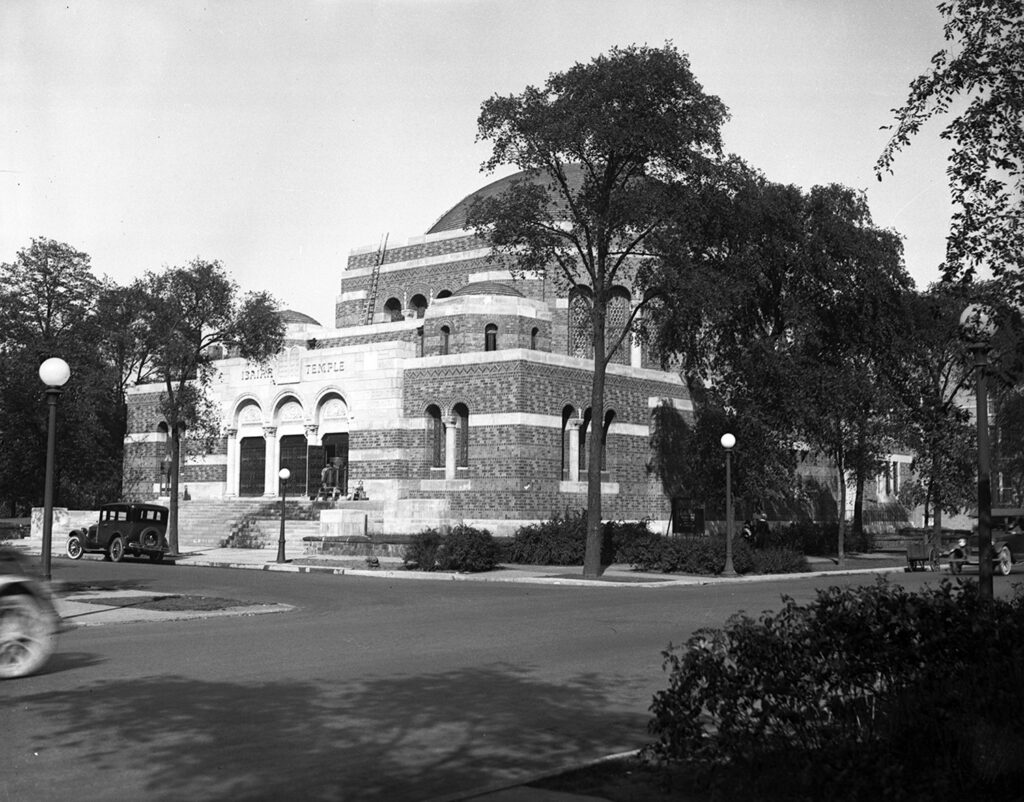
Temples Isaiah and Israel came together as one in the thirty sixth-week of 1924. The merger coincided with a planned move into an enormous new temple that had been constructed at the corner of Greenwood Avenue and Hyde Park Boulevard in Kenwood. The “united congregation will be one of the largest in America.”
A block away, Jacob Franks and his family prepared to leave the mansion that had been the scene of so much tragedy. Ever since the youngest Franks child, fourteen-year-old Bobby had been kidnaped and murdered in May, the house had become a “mecca for the cranks and the terrorists and curiosity’s thousand eyes.” Add to that additional threats made toward the remaining children, a burning cross, and a threatening arrangement of human bones on a neighbor’s porch, the latter two attributed to the Ku Klux Klan, the affluent neighborhood of Kenwood no longer felt safe. The sale of the house revealed a sad twist: many years prior, Jacob Franks had purchased the land on which he built his family’s home from Albert Loeb, the father of one of his son’s killers. The Franks family intended to move into the Drake Hotel.
That case must have been on the minds of the five Chicagoans asked that week by the Inquiring Reporter, “What in your estimation is the greatest problem confronting the United States?” Four of the five answered crime, but, more than that, the unequal distribution of justice in response to crime, with the poor often being punished more severely than the rich. Clara Aaron regretted that “respect for the law” could not be taught through example. As she explained, the country was plagued by “High officials protecting and profiting by crime. Foremost lawyers preaching anarchism to inmates of jails; eminent professional men perjuring themselves for per diem fees.”
In a letter to the independent progressive presidential candidate Senator Robert La Follette, Republican of Wisconsin, New York state judge John Ford, himself a member of the GOP, lamented the “subservience to predatory interests” that characterized the party and the United States Supreme Court. “The Supreme Court of the United States is an absolute despotism,” Judge Ford wrote. “It is beyond the control of congress, of the constitution, of the people, and of any authority which is directly or indirectly responsible to the people.” He supported La Follette’s pledge to reform the Court.
Swift justice was served that week to twenty-six men, “ranging from youths of 20 years to middle-aged males of respectable appearance,” who were rounded up in Garfield Park as part of a police-led “campaign against mashers.” The men had all been accused of “annoying”unattached young women and “mothers pushing baby carriages” who were trying to enjoy their time in the public park.
At a movie theater in the Loop, during a screening of The Woman Who Sinned, sisters Violet King and Jane Stanage found themselves the victims of the unwanted attention of one Robert Findelhay. When he allegedly touched first Violet’s ankle and then Jane’s, the latter slapped him so hard on the nose that it sounded like a “baseball meeting Babe Ruth’s bat.” Later in court, before the judge, Stanage admitted “with some reluctance that her ankles might be interesting to the average male” but didn’t “want any movie flirts trying to feel them in the darkened theaters.” Findelhay claimed he’d been merely trying to snatch back the bottom of his coat upon which the two women, seated behind him, were treading. His denial prompted another wallop from Stanage. The judge found Findelhay guilty of harassing the women and fined him $200 and costs.
No stranger to being struck on the nose was boxing champion Jack Dempsey. In fact, he was sporting a newly constructed one when he gave an interview to a journalist in Philadelphia and revealed he was in a relationship with the “silver sheet” star Estelle Taylor. The two intended to wed and then wind down their respective careers to “settle down in the country somewhere, not too far from the bright lights.” Within a day of the interview’s publication, Dempsey claimed he’d been misquoted: he and Taylor were simply good friends who often traveled together. It was revealed that the actress was married to Kenneth Malcolm Peacock, a Philadelphia bank clerk.
Week Thirty-Seven: September 7-September 13, 1924
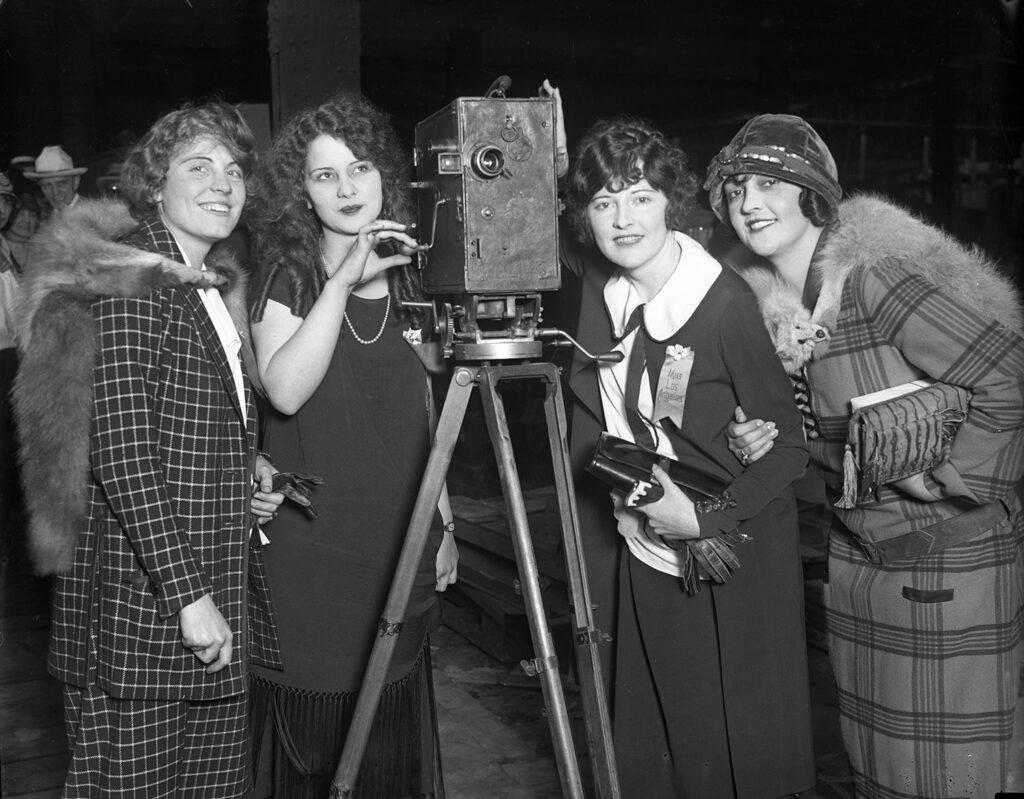
Songs and stories rose from the ocean floor in the thirty-seventh week of 1924. Outfitted in a diving suit with a microphone built into the helmet, Uncle Wip of Philadelphia radio station WIP delivered the “first bedtime story to be broadcast from the bottom of the sea,” near the Steel Pier in Atlantic City.
Not far from there, “Miss Philadelphia,” Ruth Malcolmson, 18, was “crowned by King Neptune on the million dollar pier in the presence of 5,000 cheering persons” in the third annual contest to determine “America’s most beautiful bathing girl.” She bested the winner of the past two years, “Miss Columbus.” Margaret Leigh represented Chicago and was among the finalists.
All good stories have a beginning and an end, and the start of Miss Philadelphia’s reign was just one of the beginnings that week. In Lake Geneva, Wisconsin, popular cartoon character Any Gump began his campaign for the presidency when his statue was unveiled near the entrance to the estate of his creator Sidney Smith. Before a crowd of 200 Chicagoans and a brass band, Smith declared that his creation “has made a language of his own that will last as long as the American language. He is a man who put Gumption into the citizenship of this country.”
Back in Chicago, the unfinished Grant Park Stadium, located on the lakefront, just south of the Field Museum of Natural History, hosted the Police Field Day before 45,000 spectators as well as an evening Pageant of Music and Light, organized by the South Park Commission, in which “three thousand children bearing lanterns marched in fairy processional,” prior to a formal dedication scheduled for October. There was discussion around renaming the unfinished structure, with its classical colonnade making it “as fine a stadium as any in the country,” in honor of those who’d given their lives in the Great War.
The events at the stadium were but a small part of a very full week, locally and nationally, as acknowledged in an editorial cartoon by John T. McCutcheon that appeared in the Monday edition of the Tribune. Captioned “A Busy Week Ahead,” it depicted Uncle Sam at the center of a whirlwind in which the phrases “Maine election,” “Firpo Willis Fight,” “The Chinese War,” “The Prince of Wales,” and other events, accompanied by an image, swirled.
Among those other events was an ending, the conclusion of a flight around the world in which several nations participated. Alone among the “Air Magellans” to finish “spanning 23,000 miles of the world’s girth for the first time in the annals of human travel” was the American squad, led by its “flagplane” Chicago. Over 45,000 greeted the team of three planes as they arrived over Boston, five months to the day after first taking flight from Seattle. From New England, the fliers headed to Washington D.C. where President Calvin Coolidge waited three hours in the pouring rain on an airstrip to greet them.
The flyers, all part of the military, couldn’t have picked a better week for their return, as Friday marked the first National Defense Day, another event that appeared in McCutcheon’s cartoon. Millions in cities and towns across the nation participated in parades and other patriotic activities in the country’s largest “celebration and test of military potentialities,” which concluded with a radio address by General John J. Pershing, who’d led the American Expeditionary Forces in the Great War, in which he announced his retirement. Over 15,000 gathered in Grant Park in Chicago to hear Major General Harry C. Hale describe the “definite, fixed policy for preparedness.” Those who advocated for peace, such as the “black haired girl” with a “large bundle of copies of a radical newspaper on her arm” who appeared on the edge of the park were escorted by army officers “gently but firmly” away while the “papers were ignited and slowly, one after the other, burned–a funeral pyre of Pacifism.”
Calls for blood accompanied the conclusion of the Richard Loeb and Nathan Leopold case, another event featured in the McCutcheon cartoon. Judge John R. Caverly returned with a verdict of life without the possibility of parole for the murder of fourteen-year-old Bobby Franks, plus ninety-nine years for the separate charge of the boy’s kidnaping. “Life in prison may not, at the moment, strike the public imagination as forcibly as death by hanging,” wrote Caverly, who was “moved chiefly by the consideration of the age of the defendants, boys of 18 and 19 years.”
Week Thirty-Eight: September 14-September 20, 1924
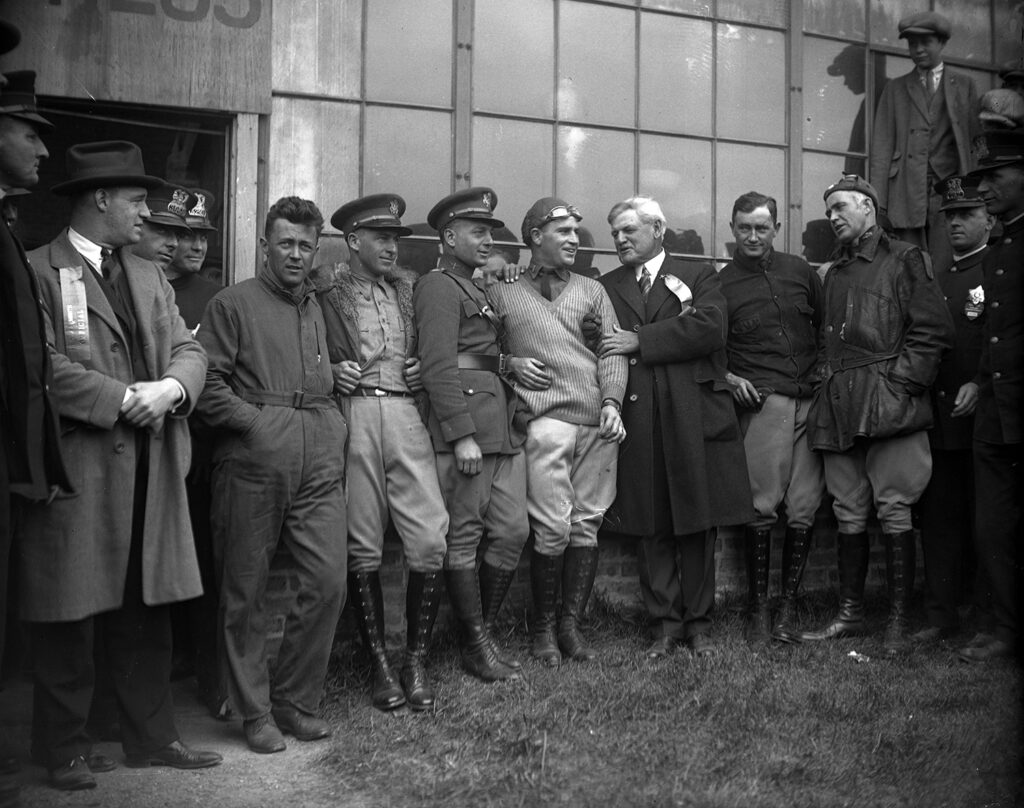
“More than 350,000 sets of false teeth were manufactured in Chicago’s seventy laboratories up to September 1,” proclaimed W.H. Scholl, vice president of the American Dental Laboratories Association, at their fifth annual conference, held in the thirty-eighth week of 1924. That number placed the city above New York for the first time, and the United States now led the world in the production of dental products.
Two individuals who would be incarcerated long enough to require dentures were Nathan Leopold and Richard Loeb, the convicted murderers of fourteen-year-old Bobby Franks. The Tribune reported on the start of their life terms at the state penitentiary in Joliet by noting that it began with a morning screening for all prisoners of the Rudolph Valentino-starring Monsieur Beaucaire, followed by the “first bitter hour of manual labor the two boys had ever known.” During a day weaving rattan-seat covers, Leopold and Loeb “were thoroughly depressed and dispirited and went about the task set for them with listless and despairing hands, and sober, somber, sad brooding countenances.”
While the two looked down in despair upon their work, the rest of the city looked to the sky, inspired by the heroics of the United States world flyers as they arrived on their westward tour of the country. With the flagship Chicago in the lead, the three planes, which included the Boston and the New Orleans, touched down at the airmail field in Mayfield around 1pm where Mayor Dever and other dignitaries greeted them. Thousands lined the streets as the flyers, who’d circumnavigated the world by air, processed first to a luncheon and later a dinner held in their honor, the latter at the Drake Hotel. There George Foster, head of the welcoming committee, announced he was sending a message to the head of the United States Army’s air service requesting that the Chicago be gifted to the city so that it could be permanently displayed in the Field Museum.
On display at Dexter Park, adjacent to the Union Stockyards, were the political enthusiasms of 15,000 “boys from the river front” who’d come out to hear Democratic presidential candidate John W. Davis deliver a rousing stump speech. Dispensing with his patrician airs and oft-repeated platitudes, Davis tailored his remarks to the crowd, focusing on the topics about which his audience cared, “Irish freedom and personal liberty.” Revealing its prejudice, the Tribune asserted that “all thought personal liberty meant free liquor, apparently,” although Davis was actually referencing recent decisions by the Supreme Court. “Call it by its right name, Johnny!” someone in the crowd purportedly called out. “Call it booze!”
The particular perspective of those of Irish ethnicity was also noted in the story of Dana Wolfe, a young man from Springfield, Illinois, stopped for speeding near the intersection of 47th and Western. A “search of the machine revealed a pistol lying on the seat next to him, while in the tonneau was a costume apparently of a full fledged member of the K.K.K.” Unfortunately for Wolfe, he’d been stopped by “five gentlemen of the detective bureau, bearing the names McCarthy, O’Grady, O’Connell, Day, and Conway,” who did not look favorably upon the anti-Catholic actions perpetrated by the Klan and promptly locked the speeder up for the night.
The baseball season entered its own twilight stage that week, with the Chicago White Sox and Chicago Cubs, both out of contention, announcing when the postseason city series would be held. Both teams suffered a loss with the passing of the Peerless Leader, Frank Chance, from a respiratory ailment in Los Angeles. Hired to be the White Sox manager, Chance had been too ill to assume those duties in the spring, and his former Cubs teammate, Johnny Evers, had filled in on what was hoped would be a temporary basis. As a Cub, the player-manager Chance had led the team to four pennants and two World Series wins, including the franchise’s last in 1908. His four-straight seasons of leading teams that won 100 or more games established a major league record. “These are the saddest of possible words,” wrote Franklin Pierce Adams, New York journalist and Giants fan, of Chicago’s legendary infield. “Tinker to Evers to Chance.”
Week Thirty-Nine: September 21-September 27, 1924
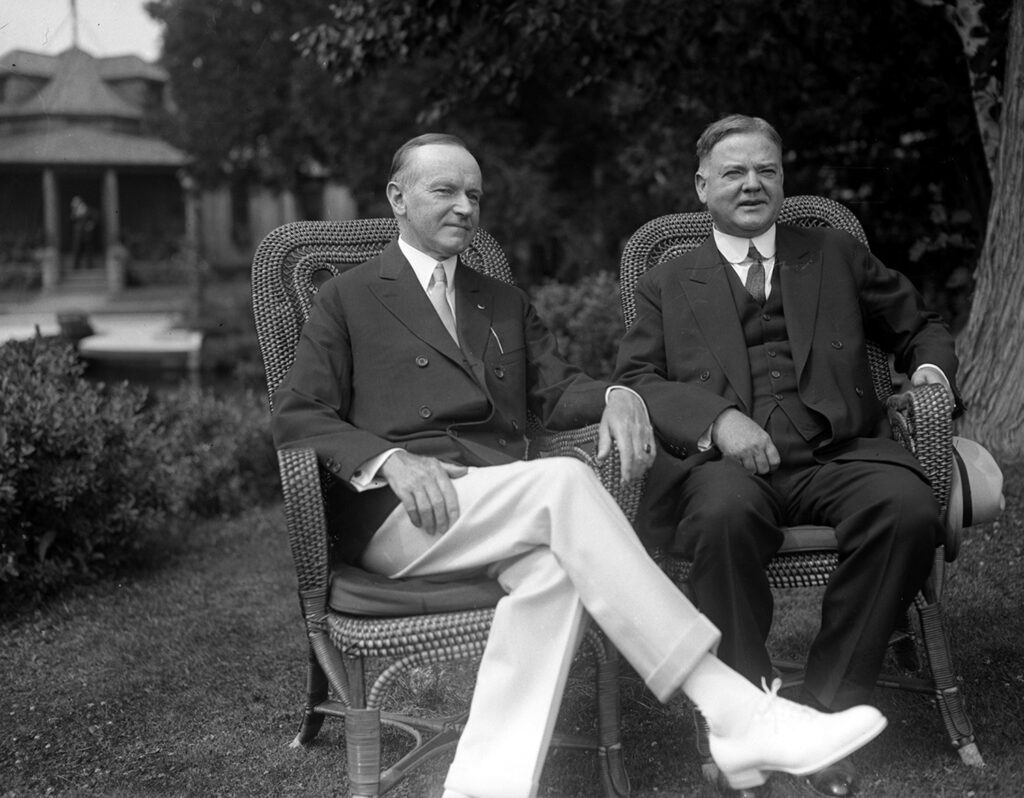
“Time lost is said to be gone forever,” the Tribune reminded its readers in the thirty-ninth week of 1924, “but tonight, if you don’t forget, you can set the hands of the old alarm clock back one hour and beat the adage.” An extra hour at the end was the least strange thing to occur that week.
Start with gold, ingots and bars, some $2 million marks worth, concealed in cheese and lying in the hull of the Dutch liner Tubantia, some forty fathoms below the ocean’s surface. Eight years prior, in the midst of the Great War, a German submarine had torpedoed the boat, not knowing of the treasure within. Now salvagers from France, Denmark, and England–although the latter could be a German ship in disguise–circled above, plotting how to retrieve it. As reported, the cheese treasure is a tale that “reeks with romantic sea lore, gold running, blockades, and piracy.”
Back in the United States, a small object of outsized importance, given its owner, went missing. “New York’s Tenderloin rocked tonight from the seismic reaction of a mystery that concerned the disappearance of a wallet belonging to the Prince of Wales,” reported the Tribune, “and the nocturnal adventures of Maj. E.D. Metcalfe, confidential staff officer of his royal highness.” With the Prince elsewhere, as part of his stay in the U.S., Metcalfe, it seems, had taken the wallet with him on a romantic assignation. Returning to his room early the following morning, he discovered it missing and frantically called local police to report Wales had been robbed—however, when they arrived, investigators learned that the wallet had unexpectedly reappeared.
Someone soon to be appearing all across Chicago was musician and public relations man Charles D. Isaacson, dubbed the “Billy Sunday of the opera.” Hired by the Chicago Civic Opera to boost attendance at the Auditorium, Isaacson intended to “go into the offices, the plants, the warehouses, the factories, the tenements, and tell the people who do not understand opera just what it is all about.” The Inquiring Reporter asked five Chicagoans if they thought his efforts to popularize opera would succeed. Most wished him well, but attorney R.C. Holbrook expressed skepticism about the venture. “Opera is not for the general public,” he remarked, “although I believe if it were put on in good English it would be more educational and, naturally, more popular.”
No one doubted the popularity of baseball in Chicago, but the fans who came out to watch the White Sox play the Washington Senators surprised the home team. With the Senators chasing a pennant for the “first time since George Washington was President,” the “south side crowd, and there were at least 7,000 present, turned against the Sox and rooted for the visitors.” The Tribune chalked up the fans’ behavior to the “feeling that is general over the country”that someone other than the perennial pennant contenders, the New York Yankees, should triumph. The Senators obliged by defeating the Sox 8 to 3 and maintaining a two game lead over New York.
Equally surprising, on the political front at least, was the endorsement of noted labor agitator Mary Harris “Mother” Jones of incumbent president Calvin Coolidge. Most expected her to endorse the progressive senator Robert LaFollette, but Jones lauded the conservative Coolidge for not “always blowing off steam” and keeping the country on a steady course.
Mother Jones was known for her work on behalf of coal miners, and one would have thought they’d been busy under a stretch of Washington D.C., when a truck wheel punctured the earth, exposing a “network of underground tunnels or a labyrinth of catacombs in the exclusive northwest section of the city.” Speculation swirled around the purpose of the brick-lined tunnels, four feet wide and seven feet tall–were they the work of German spies during the Great War, remnants of Civil War defenses, or clandestine routes for rum runners? An entomologist at the Smithsonian Institute, Harrison G. Dyar, quickly cleared up the matter. He admitted to digging the tunnels from 1905 to 1915, with all of them leading back to where he lived in the city at the time. “I did it for the exercise,” Dyar said. “Digging tunnels after work is my hobby. There’s really nothing mysterious about it.”
Week Forty: September 28-October 4, 1924
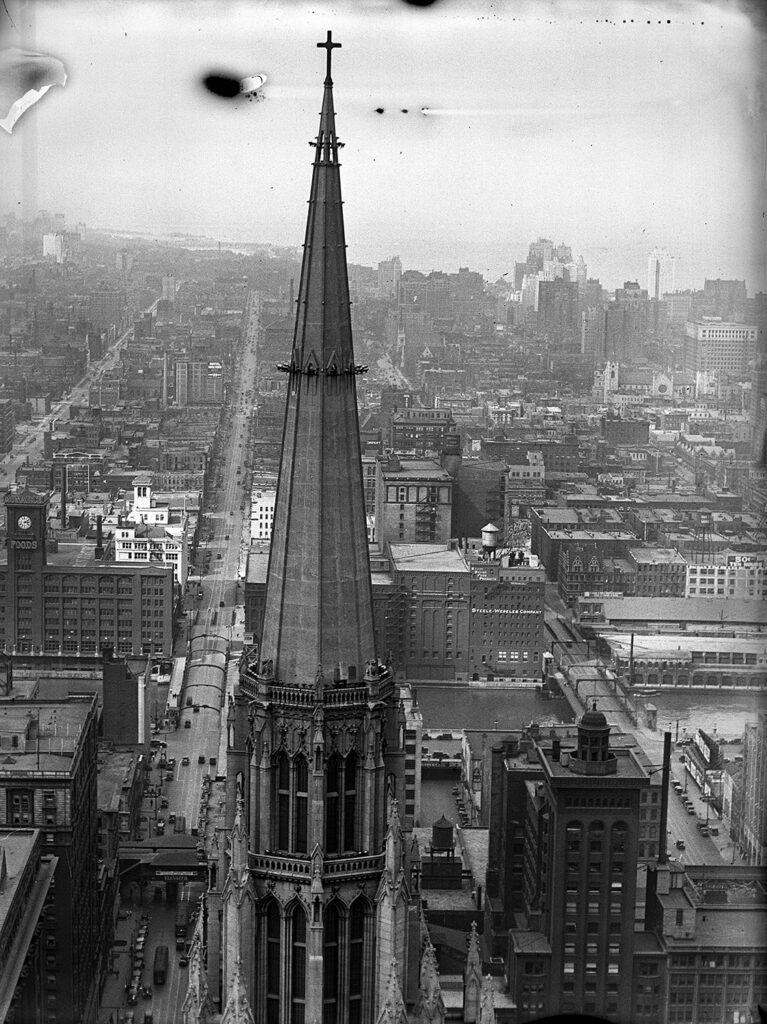
Climbing the 112-foot flagpole atop the unfinished Tribune Tower took steeplejack James Wiedersberg almost a half hour in the fortieth week of 1924. Almost 600 feet below, on Michigan Avenue, his wife and two small children were among the thousands who observed his progress. The purpose of Wiedersberg’s climb was to adjust the pulley system on the pole so that the Stars and Stripes could be raised. While at the top he had a perspective few in Chicago had possessed.
To the south he saw clearly the pointed cathedral-like top of the Chicago Temple, the city’s tallest building, dedicated earlier that week in an ecumenical ceremony that involved Mayor Dever and Rabbi Joseph Stoltz. As with Wiedersberg’s climb, thousands gathered to be part of the moment, filling the three services offered that day at the skyscraper with a church on its top and spilling out onto Washington Street and Clark Avenue, where Dr. O.C. Brown addressed them. “Chicago cannot endure unless she has regard for law and order,” said Mayor Dever in his remarks. “It is the dogma of all our religious creeds that without the religious impulse we shall inevitably fail.”
Dever may have been thinking about what the Tribune would report on the first of October. Chicago had reached a grim milestone: 500 auto-related fatalities since the start of the year. A full page of the paper displayed all the names of the deceased as well as 108 photographs of select victims. A combination of accidents, speeding, and intoxicated driving had produced this total, with the most recent casualty being seven-year-old Wiliam Roy, struck down near the intersection of Newberry and 14th Street. The Tribune had a term for cars like the one that killed Roy and vanished from the scene of the accident, “vampire” automobiles.
On the north end of the Michigan Avenue link bridge, clearly visible to Wiedersberg from his position atop the flagpole, some marginal effort at making the roadways safer started that week. The old wooden pavings were being replaced with rubber composition blocks, judged to be “skid, wear and vibration proof.”
Far more significant changes, however, were being debated all that week in City Hall, as Dever placed before the city council a plan for reducing the number of automobiles clogging Chicago’s streets: a municipally-owned rapid transit system that included a subway. The Mayor’s plan wasn’t the only one under consideration. Earlier in the year, under the ownership of utility magnate Samuel Insull, the Chicago Rapid Transit Company had consolidated the elevated lines and sought the council’s approval to expand them.
Insull also favored a subway, one that the city would build but that his company would run. To prove the feasibility of this proposition, it was announced that the Uptown Exposition and trade show, scheduled to open at the Broadway Armory on October 13, would include a scale model showing “Chicago’s subway and elevated systems as they are expected to appear in 1950.”
The aldermen, not wanting to pick a plan that would prove unpopular, seemed likely to put them both before the voters in the next city election the following winter, when all 50 council seats would also be up for grabs. Of the five Chicagoans the Inquiring Reporter quizzed that week in Lincoln Park about whether the city or Insull should control mass transit, four said the city, and the fifth didn’t care as long as the subway got built.
Steeplejack Wiederberg’s thoughts on the mass transit question were not noted, but the city must have looked like that model at the Broadway Armory from where he sat that afternoon in early October. Upon returning to the firm, flat surface of Michigan Avenue, he assured his family and the gathered reporters that there was “nothing to be afraid of on this climb.” He continued, “It was easy enough. There was a strong wind and the pole did wobble a bit, but I knew I was all right. I knew my ropes would hold.”
Week Forty-One: October 5-October 11, 1924
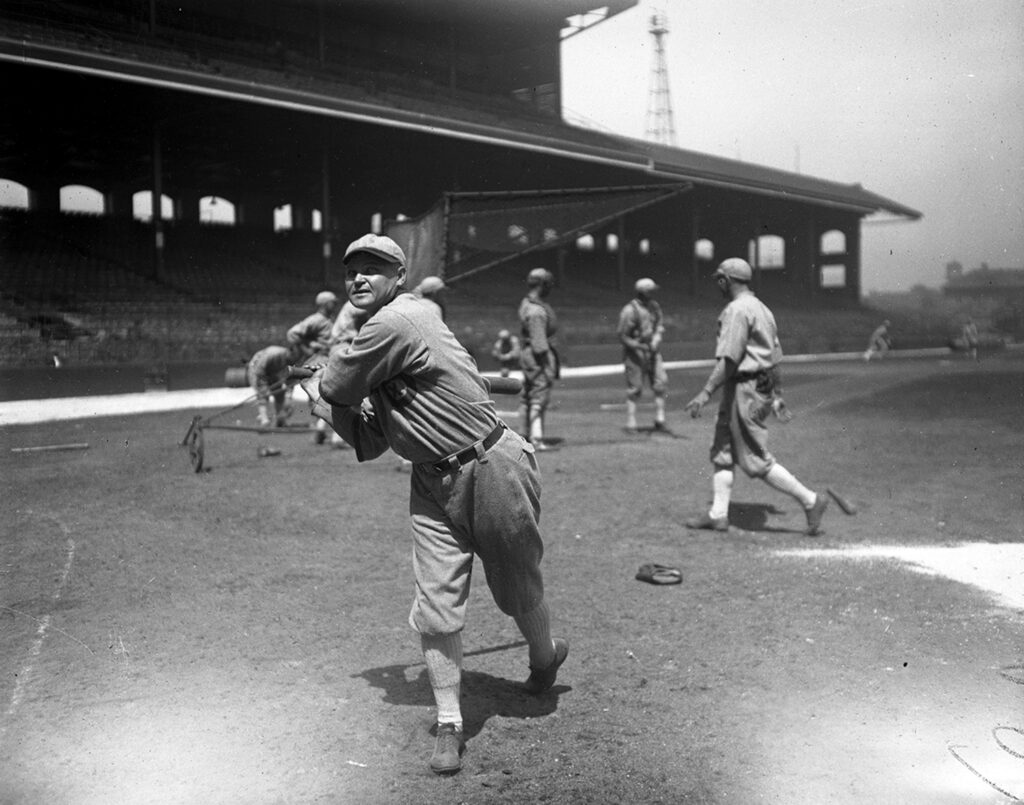
The World Series got underway in Washington D.C. in the forty-first week of 1924. The American League champion Washington Senators had on the mound veteran and star pitcher Walter “Barney” Johnson who kept the game close through eleven innings before faltering in the twelfth, allowing the National League champion New York Giants to claim game one by a single run. For the thirty-six-year-old Johnson, the game marked his first appearance in the Fall Classic.
In Chicago, the White Sox savored a smaller victory, besting the Cubs after six games in the annual City Series. The win marked the second straight year the White Sox took the series and the ninth time out of twelve contests, not including the 1906 World Series, in which the two teams faced off. The White Sox looked ahead to exhibition games in England against the Giants after the conclusion of the World Series while the Cubs contented themselves with trying for a pennant again next spring.
Another annual event, Chicago Day, marking the anniversary of the Great Fire of 1871 on October 9, took on added significance this year as the official remembrance doubled as the dedication of the new lakefront Grant Park Stadium. Around 60,000 Chicagoans gathered there on Thursday to hear speeches from Mayor Dever and the South Park Commission’s Edward Kelly, who oversaw the building of the stadium, and to see various military drills and a polo match between teams led by the Tribune’s publisher, Robert R. McCormick, and the Sherman House Hotel’s manager, Frank Bering. The highlight, however, was an appearance by veterans of the Chicago Fire Department who’d been part of fighting the conflagration fifty-three years prior and a reenactment of the burning of the O’Leary barn, complete with a cow from Iowa to kick over the lantern setting the city ablaze and Marie O’Leary Cannon portraying her great-great-grandmother Catherine O’Leary.
Even as Chicago marked a catastrophe that paradoxically it heralded as marking the start of the city’s immense growth in size and population, it couldn’t escape a prejudice both old and modern. In the vicinity of Maxwell Street, thirty-year-old William Bell died after being attacked by a mob of over 200. Bell, a Black man, had been accused by two white women of accosting them as they attempted to enter their home. Bell’s brother and a friend identified the security guard at a sacramental wine purveyor as the individual who’d likely struck the fatal blow with a baseball bat. The guard denied this, claiming he was the one who’d gone to get the police, who dispersed the mob, but not in time to rescue Bell. The following day the two women couldn’t say for certain if Bell was the man who’d harassed them.
Week Forty-Two: October 12-October 18, 1924
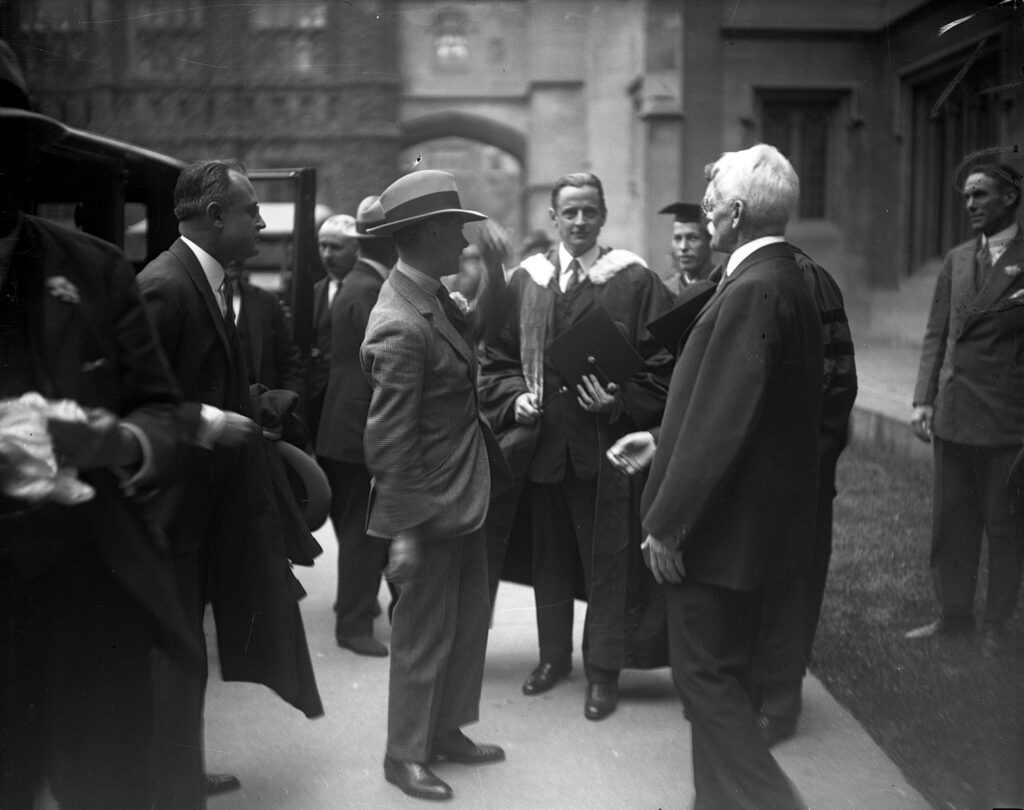
Cutting through the fog, in the early morning hours, the ZR-3 airship made radio contact with the naval station at Bar Harbor, Maine, asking for coordinates and learning it was about 120 miles offshore from the southern end of Boston in the forty-second week of 1924. Made in Germany as part of reparations from the Great War, the zeppelin was bound for Lakehurst, New Jersey, where it would be commissioned into the United States Navy.
As exciting as the arrival of the ZR-3 was, in Chicago the sixteen-hour visit by a different distinguished European guest captured, seemingly, the entire city’s attention. At 8am, at the small rail depot in Lake Forest, arrived Edward, Prince of Wales, heir to the throne of Great Britain, tanned and tired from time spent at a cattle ranch he owned in Calgary, Alberta. His host, Louis F. Swift, the meatpacker, conducted the Prince on a procession through the suburbs down Sheridan Road, where throngs of people had gathered to get a glimpse of royalty.
Edward wanted to see the stockyards. And after mounting a horse and reviewing the livestock pens, with Swift riding at his side, he was taken to the killing room floor and then briefly engaged the thousands of workers who’d massed to see him. From there, it was on to a luncheon at the University of Chicago and then up to the Field Museum, with a brief stop off at the Sovereign Hotel–the Prince seemed particularly interested in American hotels–before ascending to the top of the Wrigley Building to meet the chewing gum magnate William Wrigley Jr. and gaze out at the growing city. Atop the building, beside the Stars & Stripes, flew the Union Jack.
After a brief rest at the Drake Hotel, the Prince played squash, bathed, got a rub down, and put on his evening attire for a private dinner at the Saddle and Cycle Club, organized by his friend Wolcott Blair. Limited to roughly 100 hundred of Chicago’s most distinguished citizens under thirty, the dinner gave way to a dance that delayed the Prince’s departure for Detroit by three hours. By 3am he was gone, leaving the Inquiring Reporter to ask five Chicago women later that week who they found most appealing: the Prince of Wales, Rudolph Valentino, or Jack Dempsey. Only one woman said Dempsey, with the other four picking the Prince.
Edward wasn’t the only royalty to visit Chicago that week. Less publicized was a visit by Prince Kojo Tovalou-Houenou of Dahomey, who took time to lay a wreath at the base of the statue of Abraham Lincoln in the park named for the president. Had he remained in the city a while longer, the Prince could have seen Milestones, a nine-part pageant, with a cast of over 500, at the Auditorium Theater. Milestones celebrated Black life in the United States, with special attention given to certain figures, among them Phyllis Wheatley, Sojourner Truth, Frederick Douglass, Samuel Coleridge-Taylor, and Paul Laurence Dunbar.
The joy of that moment became eclipsed by a reminder of the violence and bigotry that marked so much of American life. On Friday, Bethel A.M.E., the largest Black church in the United States, at 42nd and Grand Boulevard, burst into flames. The damage totaled over $100,000. For the past several months, the church’s pastor, Reverend Carl Tanner, had been receiving threatening letters, and, not long before the fire, a sign had been tacked to the church’s front door. On it, three letters unambiguous in meaning and intent, K.KK.
Week Forty-Three: October 19-October 25, 1924
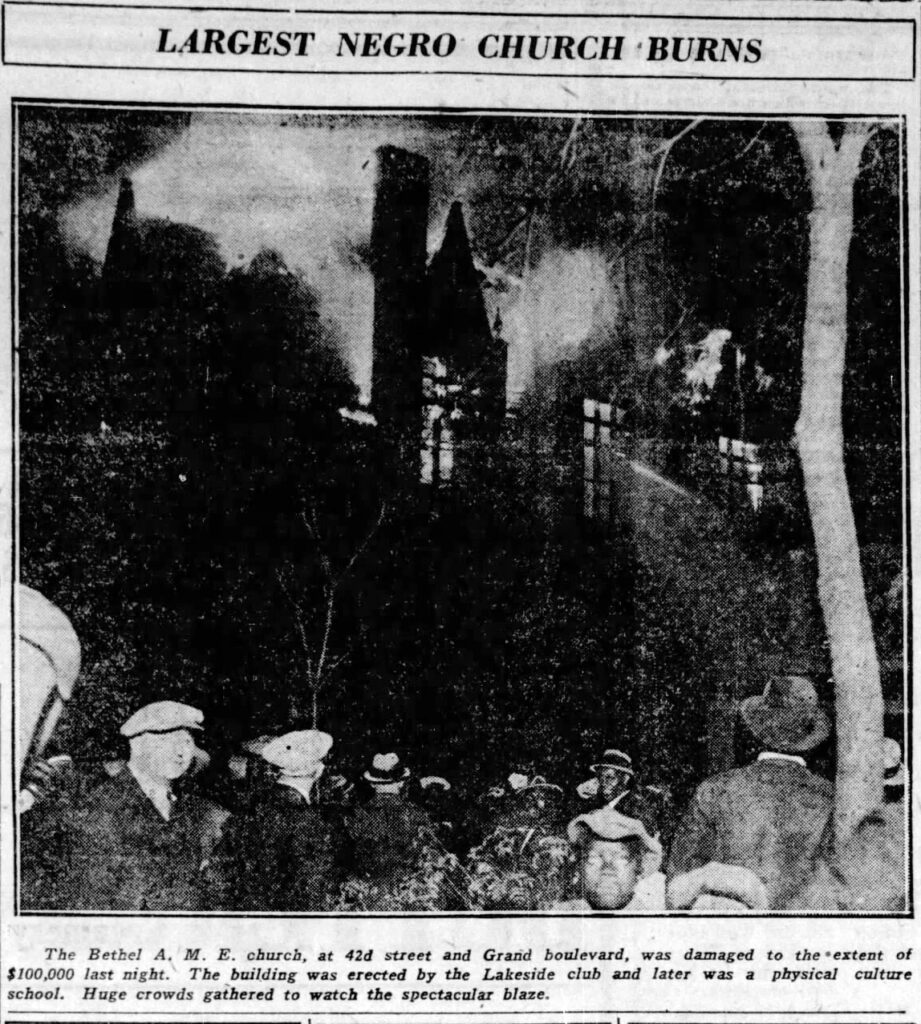
The forty-third week of 1924 began with the Chicago Tribune launching a campaign to restore the Bethel A.M.E. church, home to the largest Black congregation in the United States, which had been damaged by a fire, believed to have been set by the Ku Klux Klan. Within a day of the campaign’s launch, $13,053.00 had been raised throughout Chicago.
Violence, both real and figurative, filled the week. In the Chinese section of the city, a nationwide conflict between the On Leong and Hip Sing tongs resulted in a man being slain in the kitchen of the restaurant where he worked–most likely the victim of mistaken identity, the owner being the intended target–and a laundry on 22nd Street being bombed. In Philadelphia, a Chicagoan was stabbed to death, while much of the trouble seemed to stem from an influential tong member who’d been exiled to Cleveland. State’s Attorney Robert E. Crowe vowed to investigate the tong war and stem the violence.
A battle less fatal but no less pitched broke out before the city council’s transportation committee that week as four different plans for addressing Chicago’s rapid transit needs were submitted. Of them, the plan put forth by Mayor Dever, which called for the building of a subway and municipal ownership of the system, and the one championed by the Chicago Rapid Transit Company’s head Samuel Insull, which mirrored the Mayor’s but kept ownership in private hands, appeared the most likely to succeed. As tempers flared and tensions grew at a series of hearings, the transportation committee voiced a desire to put the matter before the voters at the next city election in February 1925. Everyone did seem in agreement that resolving the matter and putting the $40 million dollar fund reserved for rapid transportation to good use was imperative. “Discussion is good, but we’ve had twenty years of chatter,” Alderman Thomas Byrne, a member of the committee told the Tribune, “and not a shovelful of dirt has turned yet.”
As the head of Commonwealth Edison and the Chicago Rapid Transit Company, Insull could expect to see his name among the list of top income taxpayers, made public as part of a new, controversial policy, with the grudging approval of the Secretary of the Treasury, Andrew W. Mellon. At the top of the list, on the national level, were John D. Rockefeller Jr., Henry Ford, and his son Edsel Ford. In Chicago, it was learned that the highest amount of income tax was paid by the estate of the late Marshall Field, followed by chewing gum maker William Wrigley Jr.
One person who paid a surprisingly small amount of tax, less than two thousand dollars, was the president of Sears, Roebuck and Company, Julius Rosenwald. But then, charitable donations could be written off, and Rosenwald was one of the greatest philanthropists in the country. He announced that week he was stepping down as the president of Sears, a position he’d held since 1910, to become chairman of the board, clearing the way for Charles M. Kittle—who’d risen from a water boy to a vice president with the Illinois Central Railroad—to succeed him.
Asked why he was departing, Rosenwald said the “load was getting too heavy for Mr. Loeb and myself.” Albert Loeb was Rosenwald’s longtime vice president and confidant, often regarded as equally responsible for Sears’ growth and success. Since May, he’d been bedridden, suffering from a heart ailment, with the symptoms first presenting themselves mere days before his son, Richard Loeb, with his friend Nathan Leopold, kidnaped and murdered their fourteen-year-old neighbor Robert Franks.
Week Forty-Four: October 26-November 1, 1924
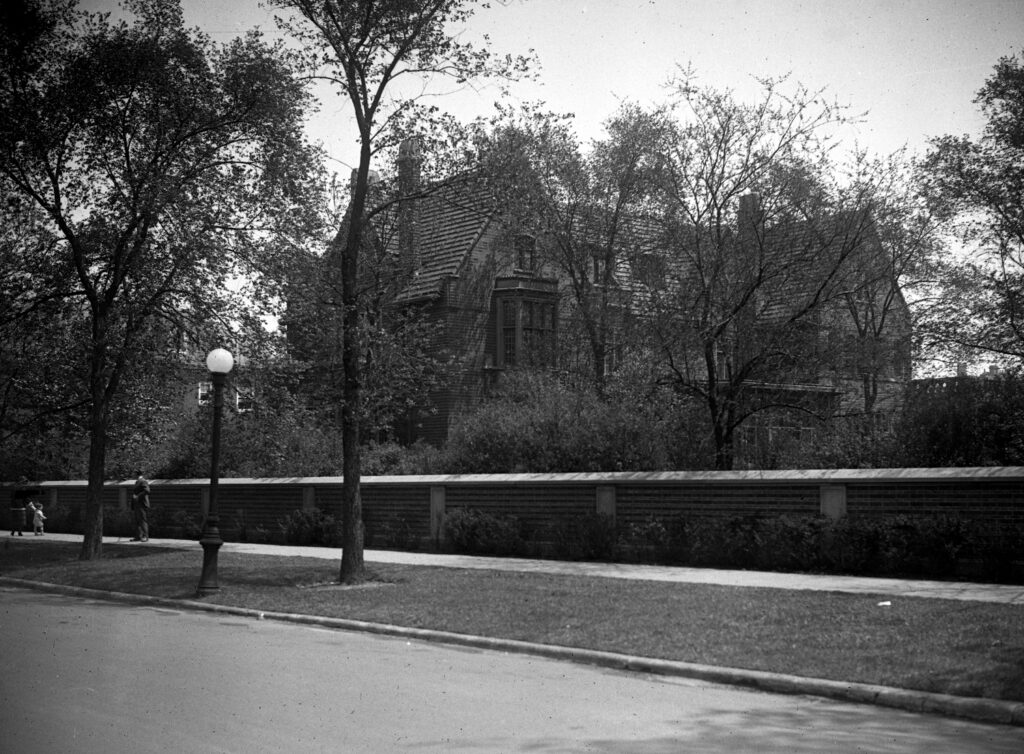
In the forty-fourth week of 1924, Vice President of Sears, Roebuck and Company, Albert Loeb, died at the age of 56 in his house in Kenwood, after suffering from a heart ailment that had left him bedridden back in May. Loeb had been born in Rockford and studied classics and economics at Johns Hopkins University before settling on the law. It was as the corporation’s counsel that he first became associated with Sears, a company he’d helped to grow alongside Julius Rosenwald, the president who’d announced his retirement a week prior.
Loeb’s burial at Rosehill Cemetery received police protection to keep away the curious. His $3 million dollar estate went entirely to his widow. Absent at the burial and in the will was his son, Richard, serving a life sentence at the state penitentiary in Joliet for the kidnaping and murder of Robert Franks. The Tribune reported that Richard Loeb was recovering from an illness himself but would soon be well enough to resume his job of making chairs at the prison.
Out of Italy came the story that two young men had drawn inspiration from Richard Loeb and his accomplice Nathan Leopold when they murdered an acquaintance as part of a fake kidnaping and ransom plot. University of Sicily students Simone Amore, 21, and Todaro Salvatore, 19, lured Gallea Calledora, 19, to the old convent of St. Augustine, where they stabbed him to death and hid his body behind centuries-old bones in the ossuary. They were apprehended while attempting to retrieve the ransom for the dead Calledora.
That same week, Italian Fascists marked the two-year anniversary of the march on Rome that ended with Benito Mussolini seizing power. Over 300,000 black shirts “equipped with rifles and with daggers in their belts” marched in parades held across the country. The “unique body, known as Benito Mussolini’s private army,” had promised to cap the anniversary by pledging loyalty to the King of Italy, although the number who actually took the oath was smaller than expected.
In England, voters exercised the franchise by turning out the ruling Labour Party in a snap election. The rival Tories took a 196-seat majority in Parliament, ensuring that former prime minister and leader of the conservatives, Stanley Baldwin, would return to power. While Labour lost, it retained the second largest number of seats. The election appeared to spell the end of the once powerful Liberal Party, with even former prime minister H.H. Asquith losing his seat. The victory of the Tories was attributed in part to the large number of women who voted as well as the weather—with the clear skies appealing to conservatives, who historically did not come out to the polls in the rain.
The election in England served as a prelude to the one in the United States, set for Tuesday of the following week. The Rennecker Printing Company at 312 W. Randolph had 4 million ballots ready for voters, who’d set a new record the previous week, with over 1 million registered in the city of Chicago alone.
Election day looked to be cooler, following a week that saw the hottest October 30 in 36 years when the mercury topped at a little over 76 degrees.
Week Forty-Five: November 2-November 8, 1924
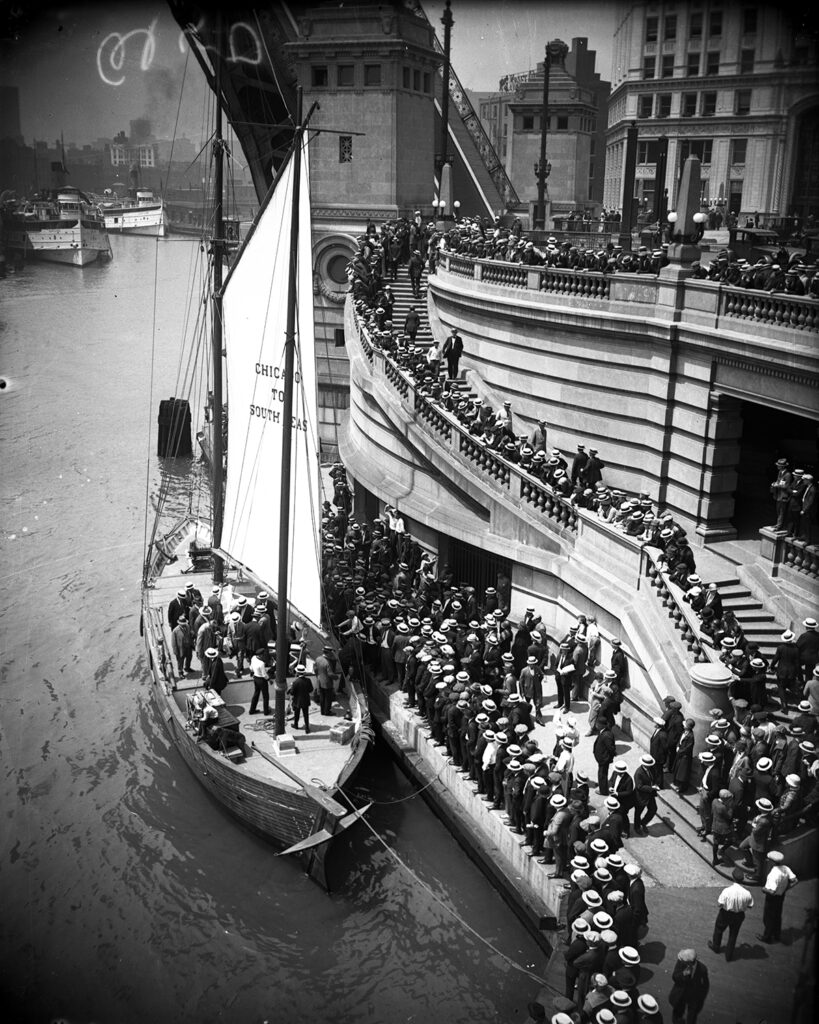
“Big-Hearted Al” Brown, also known as Al Capone, won big at the races it was reported in the forty-fifth week of 1924. He raked in close to $500,000 betting on the ponies in the space of a few weeks. Guidance from his friends at the Hawthorne race track, in acknowledgement of the generosity that had earned him his nickname, was the reputed source of his good fortune.
American voters were the ones who rewarded Calvin Coolidge, returning the incumbent Republican President of the United States to a term in his own right by a landslide margin. Despite often expressed fears that the presence in the race of a third party candidate–”radical” Senator Robert La Follette, Republican of Wisconsin–could prevent a win in the electoral college, throwing the race into the House of Representatives, where the outcome would be far from certain, Coolidge effortlessly prevailed with his pledges of additional tax cuts, rigid immigration restrictions, and continued prosperity overall. The Democratic candidate John W. Davis, a conservative and compromise who’d emerged from a convention riven by division, performed so poorly that some pundits wondered if it spelled the end of his party.
Two Democrats not brought down by Davis were Nellie T. Ross of Wyoming and Miriam Ferguson of Texas, who became, respectively, the first and second woman to be elected governor of a state.
In Chicago, another first was achieved, when lawyer Albert Bailey George became the first elected Black judge. Running with support of a Republican Party eager to consolidate Black support in the city’s second ward, George triumphed over his white opponent by a meaningful margin. A respected attorney, active in the Chicago Urban League and in the governance of Provident Hospital, George promised a fair hearing to all who came before his bench, regardless of race or sex. Of challenges to his position, he had this to say: “I do not think the klan will cause any trouble, but if it comes we must face it. I am not running away from any troubles.”
Winning that week as well was the Oxford University debate team who took on the University of Chicago debate team on the latter’s Hyde Park campus. The topic was prohibition, with Oxford taking the “wet” position and Chicago the “dry.” After all was said and done, the audience sided with the speakers from England, with a good number who arrived as “drys” having been persuaded to change their views.
On the Oxford team was Malcolm McDonald, the son of outgoing Labour Prime Minister Ramsay McDonald. The younger McDonald, 23, had already run twice for Parliament and had lost both times, but those who saw him speak in Chicago believed he had a bright future as a statesman.
Someone whose future was unexpectedly brightened was the former Liberal MP Winston Churchill, appointed by incoming conservative Prime Minister Stanley Baldwin as the chancellor of the exchequer, one of the most powerful positions in the British government. Many expected Churchill to join the Tories.
Labour had lost the election, in part, due to a scandal surrounding the so-called Zinoviev letter in which a high-ranking Russian Soviet had called upon British communists to disrupt the government and seize control. It was determined that week that the letter was most likely a fake.
Whether or not the fabled tree-climbing fish of the South Seas was a fake would apparently never be known as the much ballyhooed expedition financed by former Chicago Mayor William Hale “Big Bill” Thompson drew to an end before departing U.S. waters.
Moored in Lake Pontchartrain, outside New Orleans, the ship that was to carry scientists and a film crew to far off locales had floundered due to a lack of funds and a crew–earlier in the voyage, the cook, upon learning he wouldn’t be paid, had apparently jumped off the ship, swimming across the Illinois River to reach the shore. The much publicized voyage of the Big Bill from Lake Michigan and Chicago down toward the Gulf of Mexico had included stops at Lockport, Peoria, and St. Louis, where the former Mayor made sure to give a speech and be photographed. At New Orleans, however, the expedition’s funds having all been expended, he promptly took a train back to Chicago.
Week Forty-Six: November 9-November 15, 1924
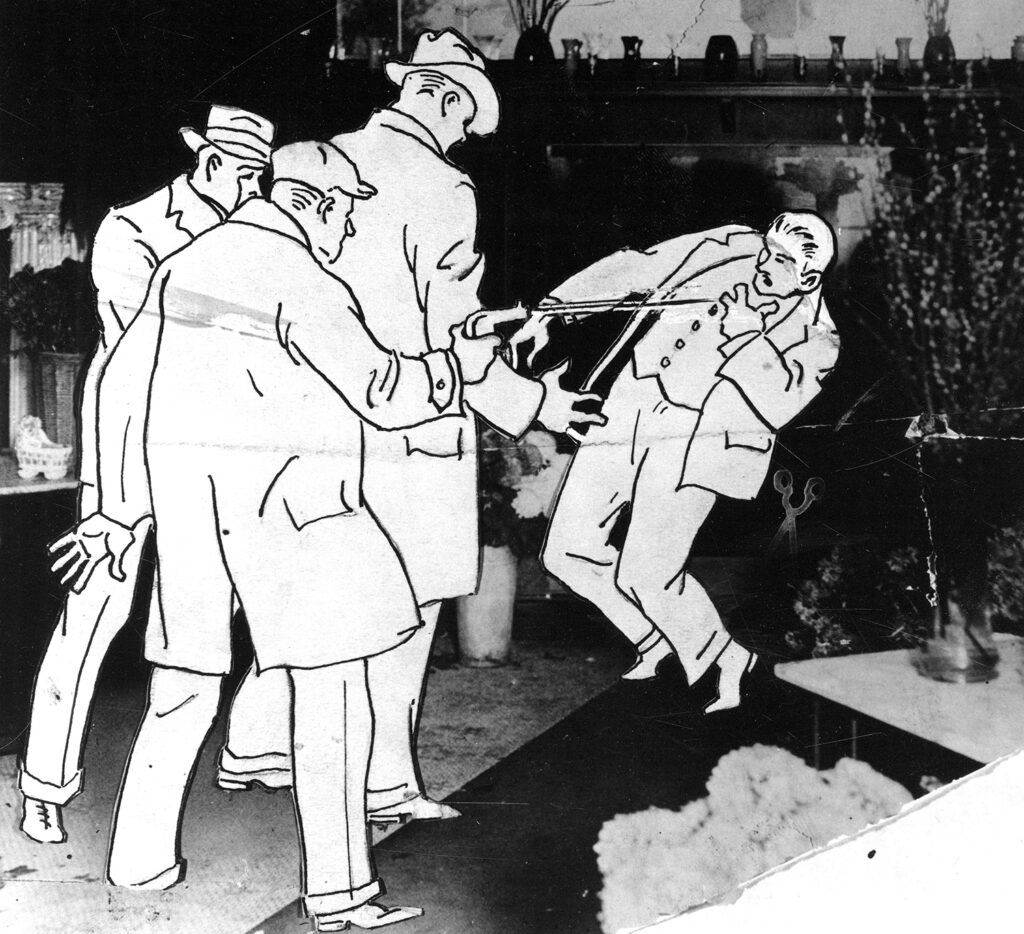
Sunday readers of the Tribune received a thrilling account of the previous day’s football game between the University of Illinois and the University of Chicago at the latter’s home field in the forty-sixth week of 1924. Defying the odds, the University of Chicago Maroons held in check the greatest player of the game, the Fighting Illini’s Harold “Red” Grange, the “Galloping Ghost,” to ensure a final score of 21-21.
While the previous week ended with raucous cheers at Stagg Field, the current one held a nationwide moment of silence at 11am on November 11, Armistice Day, honoring the cessation of the Great War six years prior. Those in Chicago’s Loop paused their speech and movements as American flags unfurled and bugles played “taps.” At Ogden Park, ROTC students from Lindblom High School engaged with the 124th Field Artillery in a simulated battle.
The day before a real act of violence had erupted in a florist shop on State Street, directly across from Holy Name Cathedral, and dominated the headlines for most of the week. Dean O’Banion, co-owner of the store, had been gunned down by three unknown assailants. Apart from selling flowers, O’Banion served as the leader of the North Side Gang—one of 1,313 operating in Chicago, according to University of Chicago sociologist Frederick Thrasher, who’d release the findings from his years-long study of gang life in the city that week. O’Banion had made enemies among other enterprising criminals profiting off of national prohibition.
Eyewitness accounts suggested that he recognized his killers as he’d greeted them with a question as to whether they were there for flowers for the funeral of Michael Merlo, the recently deceased former president of the Unione Siciliana. Fatally for O’Banion, he followed his question by holding out his hand, which was firmly taken by one of the men, as the other two pulled out pistols and fired six shots into the gangster florist.
O’Banion’s assassination resulted in the police rounding up seemingly all of Chicago’s gangland, but no one professed to know anything. Everyone loved O’Banion, it appeared, now that he was dead. Thousands lined the streets and rooftops of adjoining buildings to observe his wake at the Sbarro Funeral Home on Wells Street, where he reclined–a rosary placed in one hand–in a casket worth $10,000, shipped from Pennsylvania for the occasion. Because of his reputation the former altar boy was denied burial in consecrated ground. His plot in Mount Carmel Catholic cemetery sat in the section reserved for those in mixed marriages.
In a different section of Mount Carmel lay the final resting place of Merlo, whose funeral on the West Side had attracted even larger crowds. He’d come to Chicago thirty years prior, an immigrant and manual laborer, and had risen to being one of the most respected and powerful men in the Italian-American community. Overseeing the arrangements for the funeral was Al Brown, manager of the Four Deuces cabaret, who used his birth name, Alphonse Capone, in affairs like this. He and his associate Johnny Torrio, leader of the South Side Gang, had placed the order for the flowers with O’Banion. To the latter’s funeral, Capone had sent a wreath of dark red roses.
Week Forty-Seven: November 16-November 22, 1924
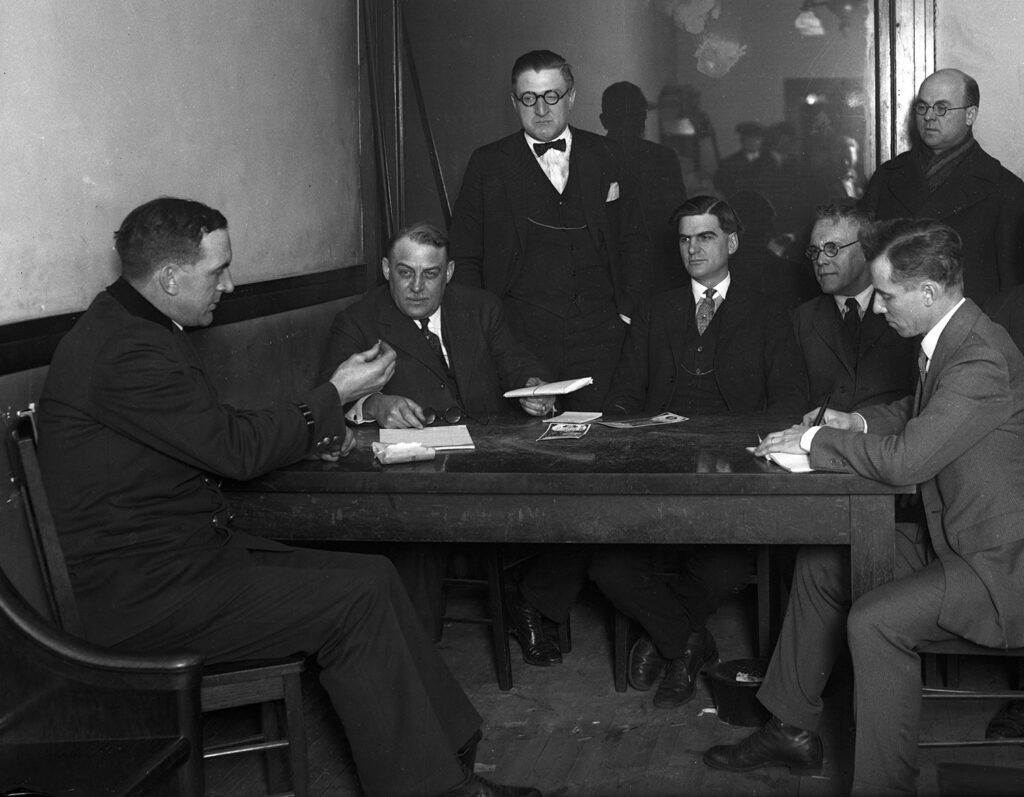
John A. Smuts laid in critical condition at Boston City Hospital, the victim of what he claimed was a self-inflicted gunshot wound, in the forty-seventh week of 1924. The location of the wound and the passage of the bullet through his body led police to doubt the story. They turned their attention to his “former stage star” wife May Yohe, who’d been with him at the time of the shooting in their apartment. She attributed their bad luck to the 65-carat diamond she’d previously owned when married to her former husband Lord Francis Hope. The Hope Diamond, she claimed, “brought ill fortune to all its possessors.”
Aerial stunt artist Ethel Dare ran out of luck when her parachute failed to open properly, and she plunged 1,000 feet to her death at the start of a benefit airshow in Cassopolis, Michigan. Her decision to use a new kind of harness for the first time in public was believed to have contributed to the accident. A skilled pilot and parachutist, Dare had completed over 200 jumps in her career, including one that almost ended her life off Municipal Pier in 1922.
Cut short that week as well was the storied career of Chief of Detectives Michael Hughes. After twenty years with the Chicago Police Department, he angrily turned in his badge upon learning of his reassignment to head the Irving Park station. He attributed the move to politics, specifically Mayor Dever’s desire to hold someone responsible for the city’s high murder rate.
In the wake of gang leader Dean O’Banion’s assassination the previous week, the police had arrested over 400 underworld figures as part of a mass clearing out of the city’s crime dens. Among those rounded up and questioned was an undertaker from New York, Frank Uale or Yale, who claimed to be in town for the funeral of recently deceased Unione Siciliana president Michael Merlo. State Attorney Crowe believed that Yale, formerly suspected in the murder of James “Big Jim” Colosimo in 1920, was involved in O’Banion’s slaying. Crowe had a theory that South Side gangster Johnny Torrio had orchestrated both killings, importing a gunman from New York. Under questioning, Yale claimed he’d never heard of O’Banion and knew Torrio by name but not personally. He did admit a friendship, however, with the organizer of Merlo’s funeral, known Torrio associate Al Capone.
In Los Angeles, it was the sudden death of a pioneering film producer, Thomas Ince, that made national news–this despite being a week where in the City of Angels an outbreak of pneumonic plague was announced contained and angry farmers in the Owens Valley had seized control of the aqueducts keeping the California city wet and their fields dry. While the guest of actress Marion Davies and newspaper mogul William Randolph Hearst, the 44-year-old Ince had developed a severe case of indigestion during a cruise off San Diego on the yacht Oneida. Rushed back to his house in L.A., Ince died of apparent heart failure. His Theosophist beliefs led to a quick cremation at Hollywood Forever Cemetery, attended by his family, Davies, and another passenger on that ill-fated cruise, comedian Charlie Chaplin.
One person doing well that week was Zoro Agha, a Kurdish porter living in Constantinople, who turned 150, making him the oldest man in the world. He had the birth certificate to prove it and attributed his longevity to abstaining from tobacco, alcohol, and coffee while subsisting on a simple diet of dried peas, beans, figs, and honey. He believed that spacing out his five marriages also aided his continued survival.
Week 48: November 23-November 29, 1924
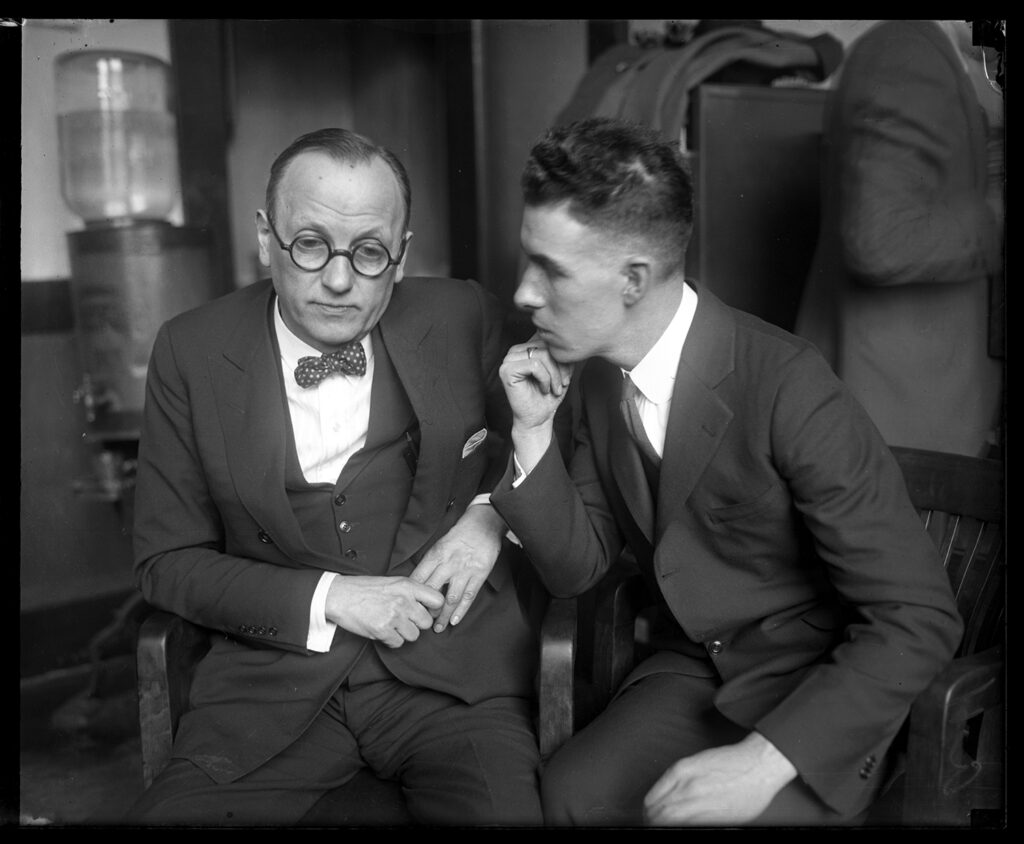
On Thursday, a column of hobos, bums, and floaters stretched for four blocks down Wabash Avenue in the forty-eighth week of 1924. They waited to enter the Movie Inn, the restaurant run by “Ma” Greenstein, where they’d be given celery and soup, turkey and stuffing, coffee and cigars, gratis. For the fifteenth year in a row, “Ma” fed Chicago’s itinerant class of workers and cadgers a free Thanksgiving dinner. She was joined by Ben L. Reitman, doctor to the poor and dispossessed, former lover of the exiled anarchist Emma Goldman, who’d recently launched a campaign to expose the atrocities she’d witnessed committed by the Bolsheviks in the Soviet Union.
Dozens of Chicagoans who’d been swindled out of thousands by Leo Koretz also gave thanks that week. The shady financier, who’d convinced them to invest in the fictitious Bayana River Trust in Panama, had disappeared in December of 1923 when his scheme began to fall apart. Sightings of him in India were made, but since March he’d been hiding out in Halifax, Nova Scotia, where he’d grown a beard. While he could disguise his face, he couldn’t conceal his love of luxurious living. His spending without a source of income aroused the suspicion of a Canadian with friends in Chicago. These suspicions made their way to States Attorney Crowe who’d sent two of his men up north, where they found Koretz living like a lumber baron. The “con man de luxe” quickly surrendered and agreed to waive extradition back to the U.S.
In Chicago, another confidence man went on trial in a federal court. Colonel Charles Forbes, former head of the Veterans Administration in the Harding Administration, had been indicted for having conspired with several contractors to defraud the government of close to a million dollars allocated for the construction of hospitals for those who’d served in the Great War. The government’s star witness was prepared to testify that he’d personally delivered a $5,000 bribe to Forbes in the bathroom of his room at the Drake Hotel.
Harding’s successor, Calvin Coolidge, stood beside his wife, First Lady Grace Coolidge, on a blustery day at the Anacostia naval air base as the latter prepared to christen the latest addition to the U.S. Navy. The German-made ZR-3 dirigible had flown out that morning from its hangar in Lakehurst, New Jersey, to Washington. With the words, “I christen thee, Los Angeles,” the airship assumed its new name. Several passenger pigeons were released onto the airstrip, each with a piece of tissue paper tied to the leg. On the paper were written verses from the Gospel of Luke, “And suddenly there was with the angel a multitude of the heavenly host praising God and saying, Glory to God in the highest and on earth, peace, goodwill toward men.”
Speeding back to the City of Angels was the comedian Charlie Chaplin and his seventeen-year-old co-star Lita Grey. The two had traveled down to Empalme, a railway center near Guaymas, Mexico where before Civil Justice Antonio Hara they were married. Despite the best efforts of the actor’s publicity people, the press learned of the rushed trip and dogged the new couple throughout their journey back to California.
The Italian press kept up its criticism of the Fascist government under the leadership of Premier Benito Mussolini in response to an attack made by his followers on some Great War veterans groups earlier in the month. Mussolini pledged to soften his rhetoric and to remove the bad actors in this party. He regretfully accepted the resignation of his “right hand man” Italo Balbo who’d orchestrated the violent attacks on his opponents. By week’s end, however, the Fascist papers reported that should republicans and other opposition forces in Italy prevail, chaos and civil war would result.
Chicagoans got nearer to Europe than they’d previously considered possible through the miracle of radio. Bridging a distance of over 4,000 miles, several enthusiasts used the latest sets to tune in on November 26 to stations broadcasting out of London, England and Lyons, France. Ten to eleven that night had been designated a “silent hour” in which the U.S. government could test the range of its latest receivers. Local radio lovers used the opportunity to cross an ocean over the cleared airwaves and bring the whole of the world a little closer.
Week Forty-Nine: November 30-December 6, 1924
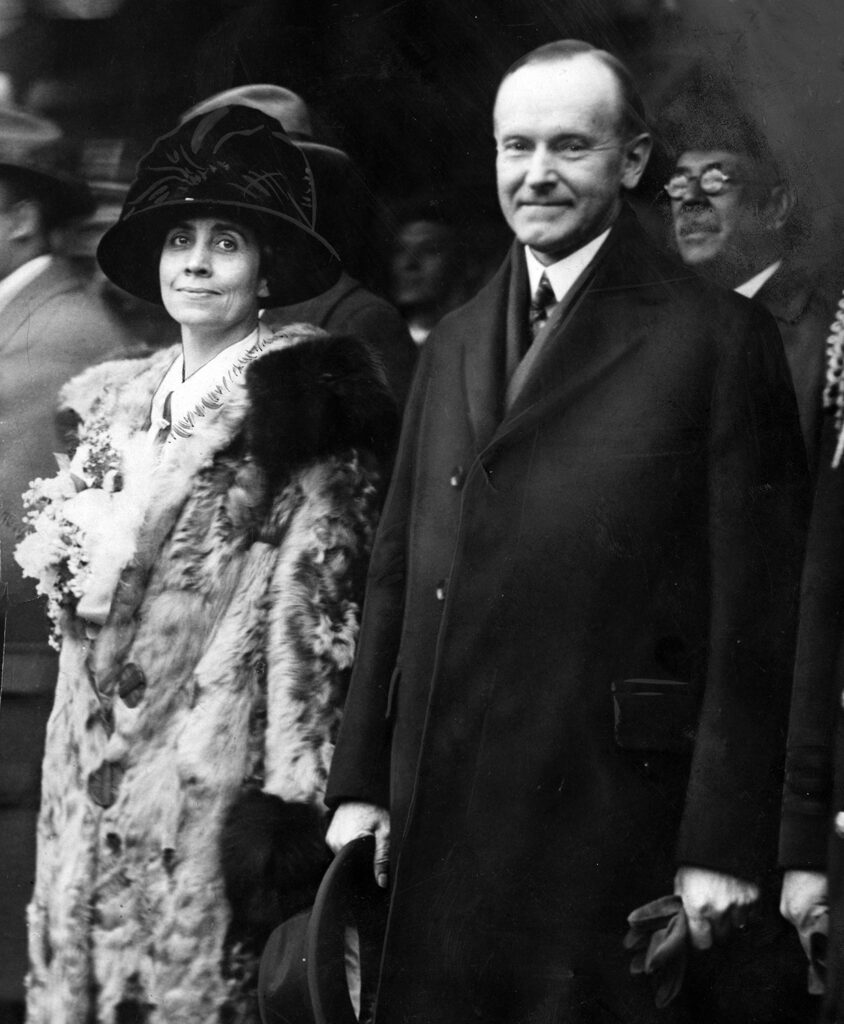
Tears were shed in the Auditorium Theater before Saturday’s performance by the Chicago Civic Opera in the forty-ninth week of 1924. “Puccini is dead,” conductor Giorgio Polacco told the audience. “You all know him through his works, but I and many of the artists of our company knew him as a man–and what a severe task this performance will be for them! What a man he was!” The noted Italian composer of such works as Tosca and Madame Butterfly, Giacomo Puccini had died suddenly, the result of complications from throat surgery he’d undergone in Brussels. Upon the conclusion of Polacco’s speech, the orchestra played Chopin’s funeral march.
More celebratory were the thirteen hours spent in the city by the President of the United States, Calvin Coolidge, and the First Lady, Grace Coolidge. The President had come to town to attend the International Livestock Exposition, near the Union Stockyards. Over 40,000 Chicagoans turned out that day, hoping to catch a glimpse of the nation’s chief executive.
Coincidentally, actresses Dorothy and Lillian Gish were in the city as well, en route from New York to Los Angeles, where they planned to attend the premiere of their most recent motion picture, Romola. During their layover, the simple but smartly dressed sisters visited with an old family friend and her young son. They told the Tribune how they’d nearly been the ones to discover Rudolph Valentino but thought he was too fussy with his wardrobe to employ in one of their pictures.
Had the sisters had more time, they could have visited a replica of the first house built by a non-native person in what became Chicago. The park district had provided the wood to Chicago Elks Lodge No. 4 to build a recreation of the simple dwelling in which Father Jacques Marquette wintered. On December 4, over two thousand attended a ceremony at the site, complete with reenactors and Mayor Dever, marking the 250th anniversary of the Jesuit missionary’s arrival. President Coolidge and his entourage paused long enough in their trip between the Drake Hotel and the Union Stockyards to note the crowd. The replica stood at the north end of the Michigan Avenue bridge, in the shadow of the Wrigley Building, and would “remain there for a week for instruction of school children in Illinois history.” Upon the structure’s demolition, it was reported the wood would be “given to the poor.”
Another house of note was gifted that week to the American Institute of Architects. John J. Glessner donated his home in the once fashionable Prairie Avenue district with the understanding that he could continue to reside there as long as he liked and that, upon moving in, the Institute would use it to “develop and encourage appreciation of good architecture on the part of the public” and “to afford opportunities and facilities for the training of young men to attain excellence” in the profession of architecture. The house was the last structure to be designed by noted Boston architect H.H. Richardson, who died suddenly at the age of forty-eight but not before leaving behind a body of work that had transformed American architecture.
Another house changed locations but not its owner that week. Chicago police, aided by United States deputy marshals, moved the six-room dwelling of Edna Barhite–a relatively easy task given that she lived on a houseboat named the Genevieve R. docked off Berteau Avenue in the Chicago River. Barhite’s “landlubberly neighbors” had lodged a complaint that the houseboat doubled as an illegal saloon. Barhite was absent when the authorities towed her home to a different spot on the river near Western Avenue.
Week Fifty: December 7-December 13, 1924
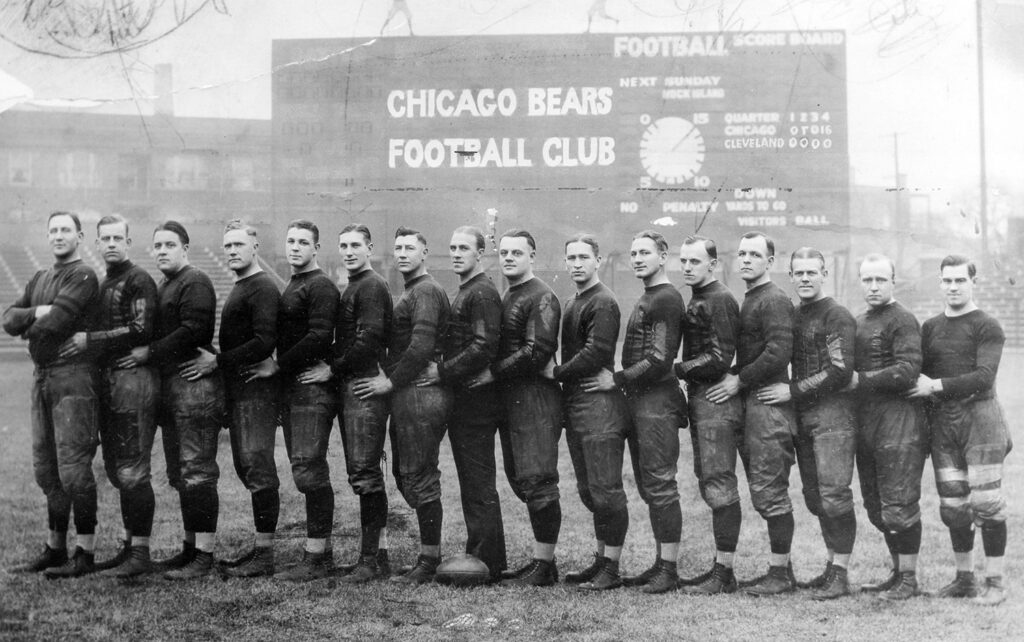
In the fiftieth week of 1924, the village of Area, home to St. Mary of the Lake’s Seminary, renamed itself Mundelein in honor of the Chicago Cardinal who’d done so much to support that institution. Also having their faith rewarded were the 18,000 fans who turned up at Cubs park to see the underdog Chicago Bears play against the Cleveland Bulldogs for the national professional football title. Led by quarterback “Little Joe” Sternaman, the Bears bested the Bulldogs 23 to 0, with “Little Joe” himself scoring multiple times.
Women’s Christian Temperance head Anna Gordon had her faith in national prohibition confirmed when she was gifted that week one of the last remaining schooners used at the Workingman’s Exchange, a saloon on Clark Street. At the Union’s golden jubilee convention earlier in the year, she’d borrowed an identical vessel and filled it with packages of tea, gifting them to those in attendance. Expressing a desire to own permanently a tankard from one of the most legendary watering holes in Chicago, Gordon connected through friends with its proprietor, the former First Ward Alderman Michael “Hinky Dink” Kenna. He happily handed over one of the glasses that had held the beer that slaked the thirst of many a reliable voter. His former colleague and current holder of the aldermanic office, John “Bathhouse” Coughlin, wrote a poem (in truth, most likely authored by the Tribune’s John Kelley) to memorialize the exchange.
Receiving a gift that week in the form of a portion of the $6,000 reward offered for the identification of Robert Franks’s kidnapers and killers were eight individuals ranging from the immigrant laborer who’d discovered the boy’s body to the night watchman who’d recovered the chisel used as weapon in the crime. Receiving no reward but only honorable mention was Jacob Weinstein, the Almer Coe & Co. employee who led the thirty-six-hour-straight effort to review the optical firm’s 54,000 records to determine that the pair of eyeglasses recovered at the crime scene belonged to Nathan F. Leopold Jr. Leopold and his friend Richard Loeb later confessed to the crime and that week marked their third month serving a life sentence in the state penitentiary in Joliet, Illinois. Almer Coe himself became so indignant at the snub of Weinstein that he wrote a letter of complaint to Chief of Police Morgan Collins, State’s Attorney Robert E. Crowe, and the Chicago Crime Commission’s Henry Chamberlain, who’d determined the division of the reward money.
Equally frustrated were the 1,500 Spiritualists who gathered at Orchestra Hall in a formal rebuke of the magician Harry Houdini, who’d headlined a program there titled “Can the Dead Speak to the Living?” on November 10. At that event, Houdini offered $5,000 to “any medium in the world” who “could compete with him under test conditions” to produce proof of an afterlife. “No man has the right to ridicule a religion,” said Dr. C.A. Burgess, head of the Illinois State Spiritualists Association, at the gathering. “Such a man belongs in an insane asylum.” Burgess then successfully used spiritualist methods to cure one man of rheumatism but “failed to cure two of nervous spasms.”
Week Fifty-One: December 14-December 20, 1924
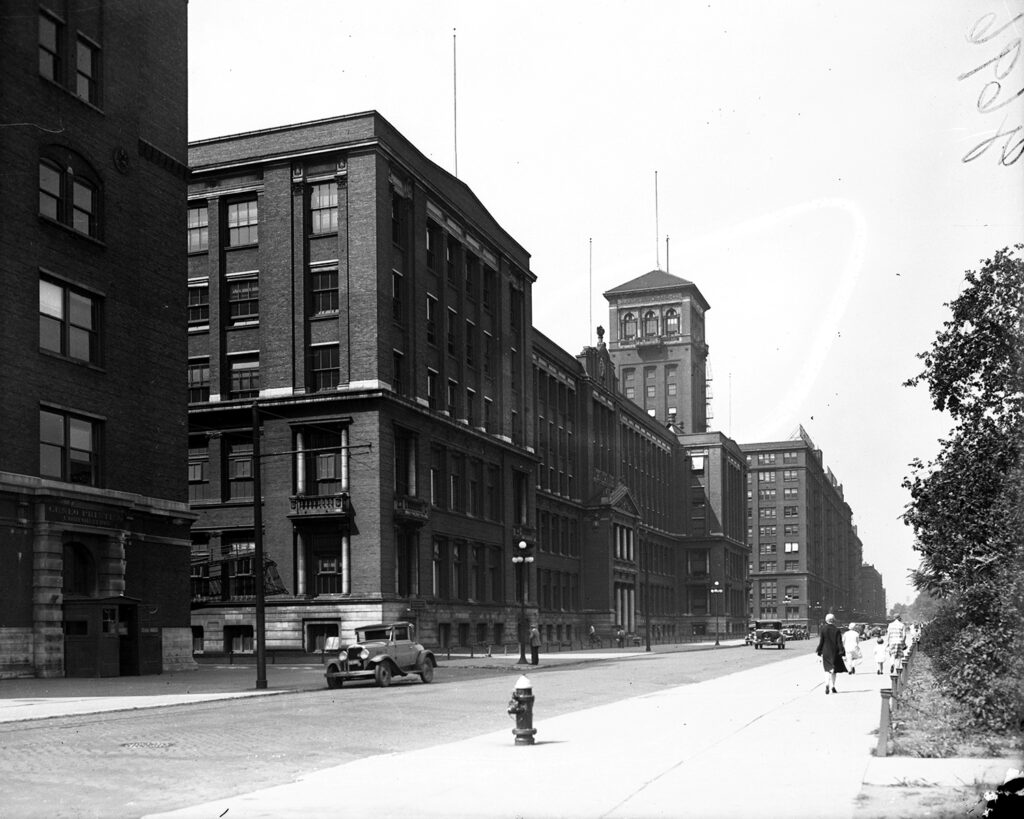
An eastbound train carrying the body of labor leader Samuel Gompers left San Antonio, Texas, at 11:07pm on the first day of the fifty-first week of 1924. Gompers had been in Mexico City, attending the Pan-American Federation of Labor conference, when the altitude, it is believed, aggravated a pre-existing condition, precipitating his final illness. The London-born Gompers, not wishing to die outside of the United States, was rushed by train back to Texas where he passed away in the early morning hours of Saturday.
“Nurse, this is the end,” he is reported to have said on his deathbed. “God bless our American institutions. May they grow better day by day.” The former cigar maker was 74 and had served as president of the American Federation of Labor for forty years. The Federation’s other leaders were set to meet within six days to pick his successor.
The death of carpenter Paul Beach at the age of 45 in Los Angeles would not have been noted in the national press if not for the fact that the man, upon inspection by the undertaker, was revealed to be a woman. For seven years until his wife’s sudden passing, Beach had been by all accounts happily married. Among his papers was found the name of Helen Walker, who lived in Chicago and worked as clerk at Swift & Co. When contacted by the Tribune, Walker refused to comment on how she knew Beach or why he’d chosen to live as a man.
In Chicago, Charles Kittle, president of Sears Roebuck & Co., announced that the mail order giant intended to open a series of retail stores. Citing the success of rival chains, Kittle said that the move to retail would increase the customer base from 9 million to 12 million. The first store was set to open in February as an addition to the large Sears complex near the corner of Homan and Arthington. Additional stores were planned for Philadelphia, Dallas, and Seattle.
A bill passed by the United States House of Representatives 282 to 39 would, if it became law, ban the sale of revolvers and pistols by mail order companies like Sears. Passed as part of an effort to limit easy access to firearms by criminal elements, the bill met with rigorous debate on the floor. Representatives Blanton (Democrat, Texas) and Wingo (Democrat, Arkansas) led the opposition, proclaiming it an “infringement on the constitutional ‘right to bear arms.’”
Coming out in support of the bill was the Postmaster General, who referenced a letter he’d received from a grief-stricken father in Tennessee who’s fifteen-year-old son had accidentally killed himself with an automatic pistol purchase through the mail for $6.74.
The pistol had originated in Chicago, where companies like Sears and Montgomery Ward, anticipating this legislation, had already removed handguns from their inventories at great personal expense. Citing this and a belief that the bill “would discriminate against a citizen who needs a gun to protect his home,” Representative Blanton deemed the legislation unnecessary and unlikely to achieve its stated goal of lessening violent crime. “For my part,” the Texas statesman said, “I hope every American boy will be able to hit a dime from his hip at twenty paces.”
One thing that did go out in the mail that week was the official Christmas card of the City of Chicago. The front displayed an image of a snow-covered Michigan Avenue, looking north, with the Art Institute and its sculpted lions in the foreground and the towering Wrigley Building toward the back. Appearing regularly within the card’s border was the city’s motto, “I Will.” A short holiday greeting from Mayor Dever sat in a box affixed as to obscure part of one of the lions. The first recipient of the season’s greetings from the nation’s second largest city: President Calvin Coolidge.
Week Fifty-Two: December 21-December 27, 1924
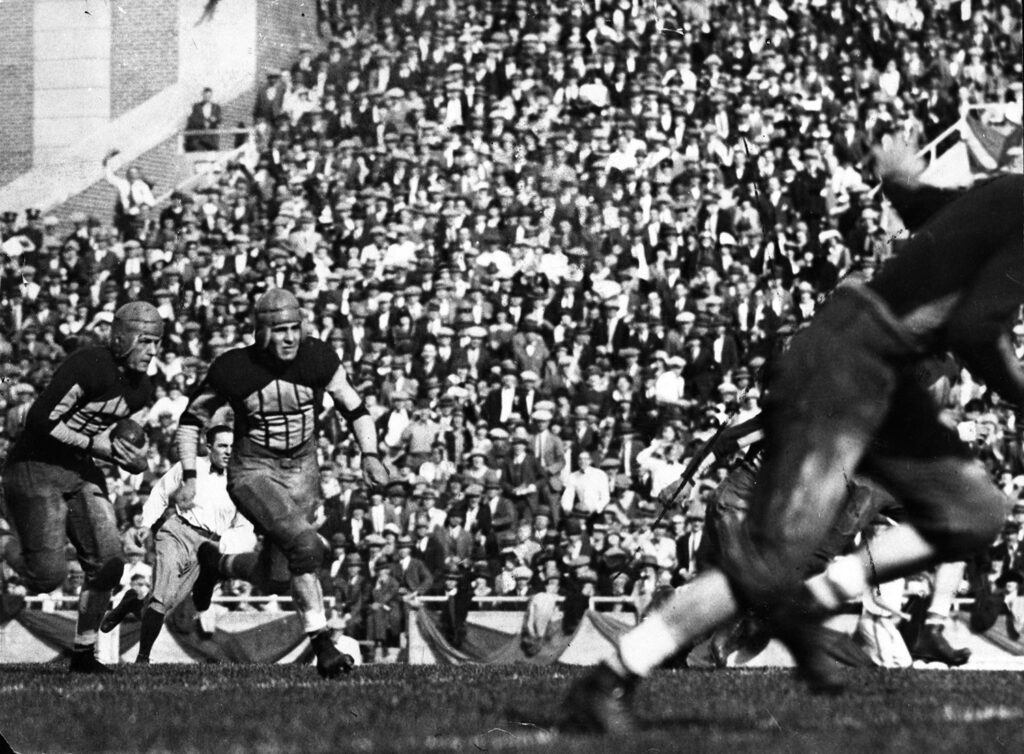
The final full week of 1924 started with Harold “Red” Grange of the University of Illinois being awarded the first Chicago Tribune trophy after being judged by coaches and other “gridiron authorities” as the “Big Ten football player of greatest value to his team during the season of 1924.” The awarding of the trophy–”a sterling silver football about two-thirds the size of a regulation oval, mounted on an ebony pedestal, with silver nameplate descriptive of the honor”–is expected to become an annual tradition.
A former Chicagoan of note, architect Frank Lloyd Wright, announced his plans to return to the city and open a new studio at 19 East Cedar Street. A Chicagoan of growing infamy, the manager of the Four Deuces cabaret on Wabash, known associate of South Side gang leader Johnny Torrio, Al Brown was reported to have been shot and killed. After a two-hour search, police located Brown, also known as “Al Caponi,” who called the rumors about his death, “Greatly exaggerated.”
What wasn’t exaggerated was the spirit with which the city on Thursday celebrated the yuletide holiday. In his Christmas message to Chicago, Mayor Dever expressed his belief that “(s)igns are not absent that not only in Chicago but throughout the nation, the country and the people are again on the highway to spiritual, moral, social, and intellectual progress.” Material progress, at least, seemed to be indicated by the large volume of sales recorded by department stores in the Loop. Mandel Brothers, Marshall Fields, and Carson Pirie, Scott all reported record sales.
Helping themselves to some of this prosperity were the thieves who waylaid a taxicab conveying Joseph Suffrin and his wife from the clothing store they owned near the corner of Grand and Milwaukee back to their home. The three masked men made off with $1,000 in cash and $2,000 in jewelry. An even larger haul, estimated at $200,000 in value, was taken during a holdup at the luxurious Parkway Hotel. The “principal loser” in that affair, out of some $85,000 worth of jewelry and securities, was the wife of Harry Hart, one of the three owners of the Hart, Schaffner and Marx clothing company.
Should the thieves be apprehended and eventually find themselves in the state penitentiary in Joliet, then they might experience a Christmas like the one notorious thrill killers Nathan Leopold Jr. and Richard Loeb had. After being entertained by a rendition of Handel’s Messiah by “Chicago choristers,” Leopold and Loeb, along with some 2,000 fellow inmates, sat down in the dining hall to enjoy “roast pork, pie, coffee, and cigars.”
More deserving of such comforts were the more than 8,000 men, women, and children, white, Black, Chinese–”representatives of all the races and nationalities that go to make up Chicago”–who found, regardless of need, an open house and a “Christmas welcome” at Wendell Phillips High School. Over three hundred transient men, who’d ventured south from the “hobo heaven, the Grandville Hotel,” received warm clothing and a dinner of “(t)urkey, roast pork, ham, chicken, cranberry sauce, salad, and ice cream,” served to them by the Revered L.H. Crawford, Alderman Robert Jackson, Mr. John R. Jenkins, Miss Viola Westbrook, Mrs. Lucy A. Walker, Mr. J.H. Langhorn, Miss Edna Young, and Mr. James Nichols, who represented the Illinois Association of Negro Commerce, sponsors of the daylong event.
All of this happened despite a record cold that set in during the early morning hours of the 25th of December. Ideal conditions, however, for those who ventured out after the holiday to Grant Park Stadium. Dedicated only that fall, the playing field had been flooded and transformed into an enormous ice rink. Skating there in the final days of the month proved popular among those on break from office work in the Loop.
Week One: December 28, 1924-January 3, 1925
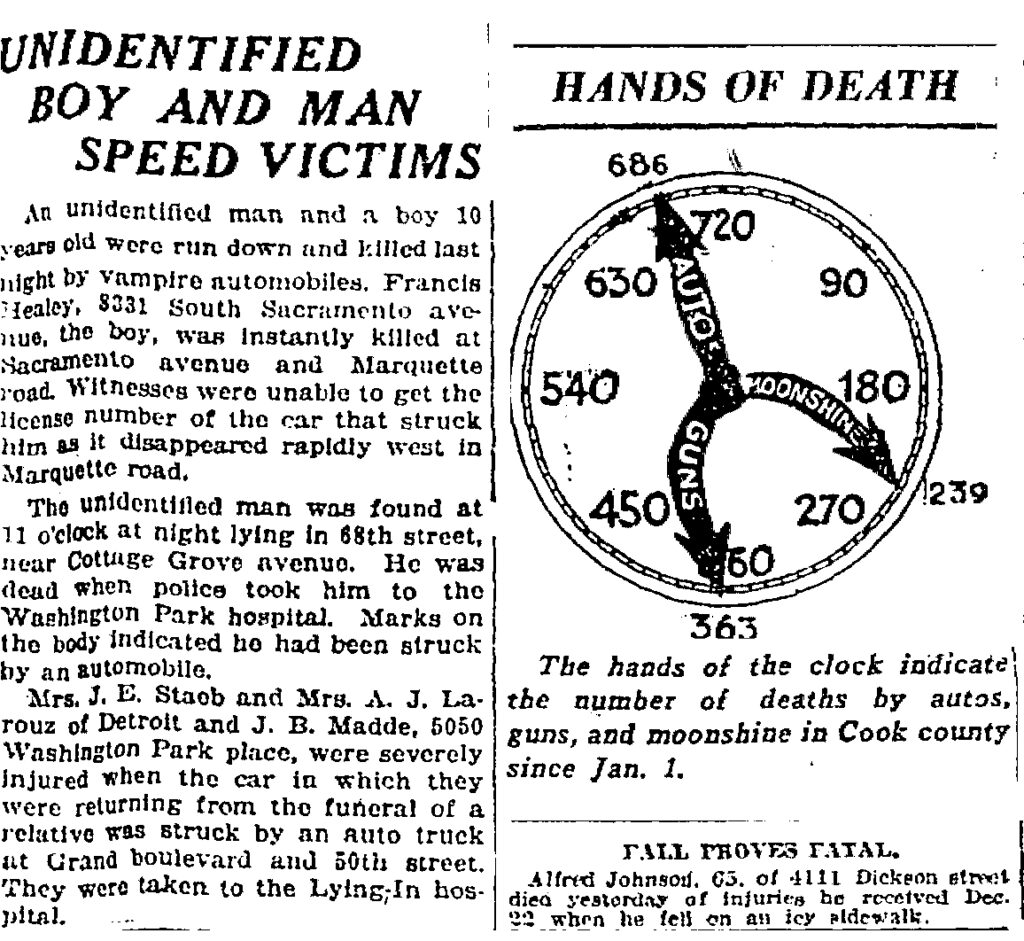
The year 1924 ended with “comparative warmth” in Chicago given the first part of the week. Temperatures across the Midwest had plunged, with the city recording its coldest December in twenty years. To the north, near Holland, Michigan, the steamship Wisconsin, with sixty onboard, remained trapped by the ice on Lake Michigan. In the city, eight died from exposure within two days. The cold weather did not chill, however, the prospect of prosperity many foresaw in the coming year.
In a New Year’s message, Mayor Dever noted the accomplishments of the passing year and looked ahead to resolving the city’s public transit needs within the next month–this despite coming under criticism in a pamphlet put out by the Northwest Side Commercial Association for opposing Samuel Insull’s plan to consolidate and privatize mass transit. The Board Education was also at odds with the Mayor over a proposal to abolish bonuses for teachers, with Dever saying, “A well paid, contented teaching force is necessary for the proper functioning and upbuilding of the public educational facilities.”
The Mayor still fared better than Governor Len Small who a Sangamon County circuit court found liable for $961,000 that should have gone to the state but instead went into his coffers while he was treasurer. A portion of those funds might be put by the state toward paying bonuses to veterans of the world war. About 275,000 applied for them prior to the midnight December 31 deadline.
With the legislature not in session that week, Springfield was relatively quiet, save for the seventy Boy Scouts from Chicago who took a train down in order to tour the home of Abraham Lincoln and lay a wreath upon his grave. To prepare for the experience, a film of Lincoln’s life was screened on the train car they rode to the state capital.
Another Illinois lawyer of note, Clarence Darrow, resolved the matter of his fee for taking on the defense of Nathan Leopold Jr. and Richard Loeb with the Chicago Bar Association approving a plan to split $150,000 with the two joint counsels, the Bachrach brothers.
An attorney in search of a case in the coming year, William Jennings Bryan announced he’d “carry his fight against Darwinism into the very ranks of the staunchest supporters of the theory” by joining the American Association for the Advancement of Science. The Association convened in Washington on December 30 to discuss among other things if chimpanzees could be taught one day to read and write.
Such an experiment would be costly. Coming out of the nation’s capital that week were the costs of the grand experiment called national prohibition. Each year since the 18th amendment had been in effect, the cost of its enforcement at the federal level had risen annually, so that it was practically triple the original annual allocation.
Thankfully for the United States government, France affirmed that it intended to repay the four billion it owed in war debt. In Germany, a provisional government, led by a three-man nonpartisan directorate, was set to take over when the Reichstag reconvened on January 4. This was in response to the crisis developing around the Allies’ refusal to withdraw from Cologne.
Italian premier Benito Mussolini had a crisis of his own making to resolve, when an unearthed document that implicated him personally in some of the worst violence perpetrated by his Fascist party appeared in the opposition press. After a few days when it appeared likely that the cabinet and Mussolini himself would resign, he responded by having the government shut down any opposing newspapers and raid the homes of his political opponents.
In Rome, the Vatican prepared to welcome pilgrims for what had been designated as a Holy Year of Jubilee.
Not feeling particularly jubilant were former Soviet Union leader Leon Trotsky, reportedly imprisoned in the Kremlin after refusing to go into exile, and William “Big Bill” Hayward, head of the Industrial Workers of the World, who’d fled there to avoid a jail sentence but was apparently becoming disillusioned with bolshevism.
Still within its thrall and fully committed to combatting “militarism, imperialism, and capitalism” on behalf of the people was the incoming Chinese president Sun Yat-sen. His elevation to that role, it was claimed, was financed almost entirely by the Soviet ambassador.
In Norway, half a million went to bed on December 31 in Christiana, the name of the capital for the past three hundred years, and awoke the next morning in Oslo, as the city reverted to using its original name.
All of this seemed a world away in Chicago as the final hours of the year counted down. Asked by the Inquiring Reporter “what are the most outstanding events of 1924,” the five Chicagoans quizzed outside the Cook County Building almost all mentioned the death of former President Woodrow Wilson, the election of President Calvin Coolidge, and the Loeb-Leopold case. One man added the selection of Eddie Collins as manager of the White Sox.
One respondent, perhaps hoping to ensure he’d make it into print, referred to the “public awakening and the efforts being made to prevent auto accidents and preserve life in general.” He had in mind the Tribune’s “Hands of Death” clock face, which tracked daily the number who died in Cook County by car, booze, and bullets. On December 31, the “Hands” had stopped at 686 by auto, 239 by moonshine, and 363 by guns.
To hear the New Year rung in with style, Chicagoans could have tuned their radios to a station in Philadelphia broadcasting from the tower in Independence Hall where the large bells marked the start of a new year and 148 years of the United States. Most, it seemed, went out into the city, likely with intoxicating spirits in tow.
Hotels like the Blackstone, Congress, Drake, and Edgewater anticipated thousands of attendees at their parties. Cabarets and clubs, from the enormous Rainbo Gardens to the intimate Friars Inn planned for standing room only. The burlesque and vaudeville houses announced midnight shows. Every taxicab in the city stood ready as evening approached to ferry passengers from party to party. Motor buses altered their schedules so that the last would depart from the Loop at 2am. The police pledged to focus on the bootlegger and leave the casual drinker alone.
Here is how the Tribune described the evening the following morning: “You’d have to go back to armistice night to find the equal of last night’s hilarious celebration of the coming of the new year, a celebration marked by huge crowds, indifference amounting to contempt for expense, the unimpeded flow of noise, exhilaration and high spirits, and the vast quantity of alcoholic drinks, emanating from somewhere.”
Even at the neighborhood soft drink parlor could be seen the “bottle in bond resting peacefully on the chaste marble counter of the soda fountain.”
The year 1925 began with snow, piled four inches high by the end of the day. It snuffed out the flame atop the fourteen-foot candle with a two-inch-wide wick the Elks had lit in memory of Father Marquette at the site near the Wrigley Building where he’d wintered 250 years prior.
Two were reported dead from accidental gunshot wounds–one, William Goldman, 35, had been shot and killed when a “bullet crashed through the window and entered his head” on the Jackson Park Elevated–and three from alcohol poisoning. Almost forty more filled the city’s hospitals, either shot or poisoned, or, in some instances, both. A fire that had broken out at a commission house on Water Street claimed the lives of hundreds of chickens and ducks. The fire department’s response had been hampered by the hundreds of revelers pouring out of nearby cabarets and hotels at 4am to gawk.
To prevent such chaos in the new year, the Illinois Ku Klux Klan announced from their office at 76 Monroe that they’d dedicate themselves to battling booze, vice, and gambling in the city. Expect raids, they said, and support for law and order in the months ahead.
On the other side of the continent, in Pasadena, California, the University of Notre Dame defeated Leland Stanford University 27 to 10 to claim the national football championship before a capacity crowd of 53,000 “in the athletic feature of the annual Tournament of Roses festival.”
And in the Tribune, cartoon character Andy Gump once again marked the passage of time by getting plastered at a hotel party, being abandoned by his family, and receiving a bill for $161.75. The following day’s strip, January 1, saw him in bed, holding his head in his hands, hungover and vowing to change. “I’ve had my lesson,” he said. “From now on, I’ll be as dry as the heart of a furnace.”
